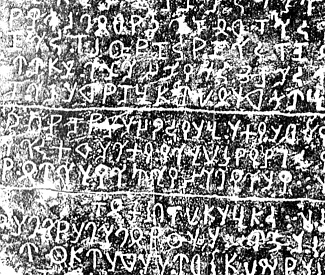

Zitierweise / cite as:
Payer, Alois <1944 - >: Quellenkunde zur indischen Geschichte bis 1858. -- 15. Frühe europäische Quellen und Quellen aus der Zeit der East India Companies. -- Fassung vom 2008-07-01s. -- http://www.payer.de/quellenkunde/quellen15.htm
Erstmals publiziert:
Überarbeitungen:
Anlass: Lehrveranstaltung FS 2008
©opyright: Dieser Text steht der Allgemeinheit zur Verfügung. Eine Verwertung in Publikationen, die über übliche Zitate hinausgeht, bedarf der ausdrücklichen Genehmigung des Verfassers
Dieser Text ist Teil der Abteilung Sanskrit von Tüpfli's Global Village Library
Falls Sie die diakritischen Zeichen nicht dargestellt bekommen, installieren Sie eine Schrift mit Diakritika wie z.B. Tahoma.
Mottos
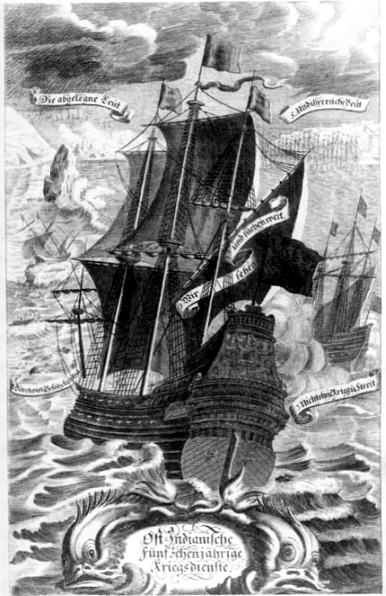
Frontispiz zu Johann Jacob Saar: Ostindianische fünfzehnjährige Kriegsdienste,
1672
Auf den Banderolen steht:
Wir sehen und suchen weit
Durch viel Gefährlichkeit
Nicht ohne Krieg und Streit
Die abgelegne Leut
Und ihre reiche Beut
[Bildquelle: a.u.a.O., S. 79]
| Dass dir nach Batavia mit zu fahren nicht gegrauet, Dass du Siam, Indostan, und auch Sina selbst beschauet, Und gesund bist wieder kommen, dies ist gleichwohl eine Tat, Welche bei uns Oberdeutschen billig Preis und Ehre hat: Du erzählest Wunderding' aus Japan und Coromandel, Von der Indianer Pracht, Glauben, Kleidung, Tun und Handel: Doch eines so von allen uns füraus verwundert macht, Nämlich, dass du einen Affen nur heraus gebracht. J. Grob1 |
1 Grob, Johann: Epigramme, nebst e.
Auswahl aus seinen übrigen Gedichten / hrsg. u. eingel. v. Axel Lindquist.
-- Leipzig : Hiersemann, 1929. -- 270 S. -- (Bibliothek des Litterarischen
Vereins in Stuttgart ; 273). -- S. 190. -- Zitiert in: Gelder, Roelof
van: Das ostindische Abenteuer : Deutsche in Diensten der Vereinigten
Ostindischen Kompanie der Niederlande (VOC), 1600 - 1800. -- Hamburg :
Convent, 2004. -- 271 S. : Ill. ; 27 cm. -- (Schriften des Deutschen
Schiffahrtsmuseums ; Bd. 61). -- Originaltitel: Het Oost-Indisch avontuur :
Duitsers in dienst van de VOC (1997). -- Zugleich. Amsterdam, Univ., Diss.,
1997. -- ISBN 3-934613-57-8. -- S. 185
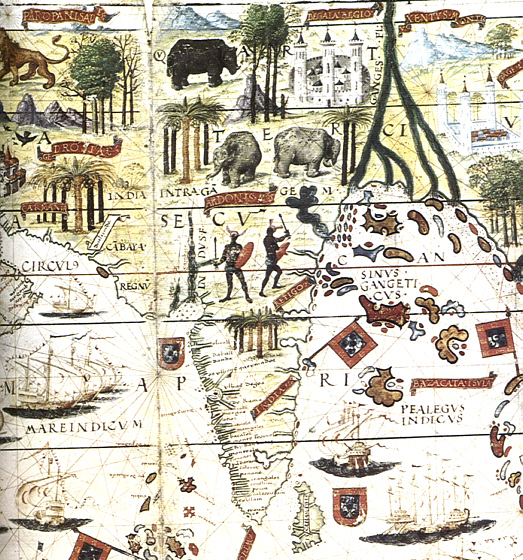
Abb.: Karte von Indien, 16. Jhdt.
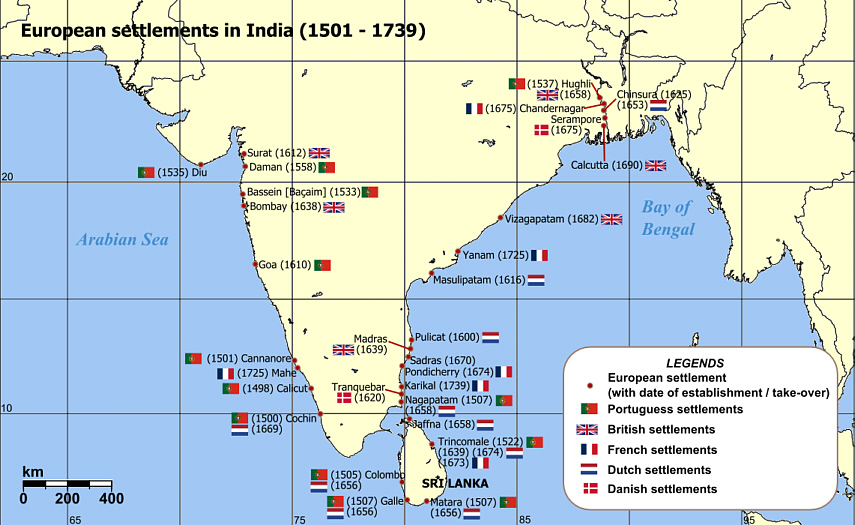
Abb.: Europäische Stützpunkte in Indien 1501 - 1739
[Bildquelle: Wikipedia, Creative Commons Lizenz:
Attribution ShareAlike 2.5, kein Autor angegeben]
Die Quellen aus dieser Zeit sind unübersehbar. Wichtige Gattungen sind
Sehr vieles ruht in den Nachfolge-Institutionen der Archive der betreffenden Companies und Nationen.
Hier kann nur ein oberflächlicher Einblick gegeben werden.
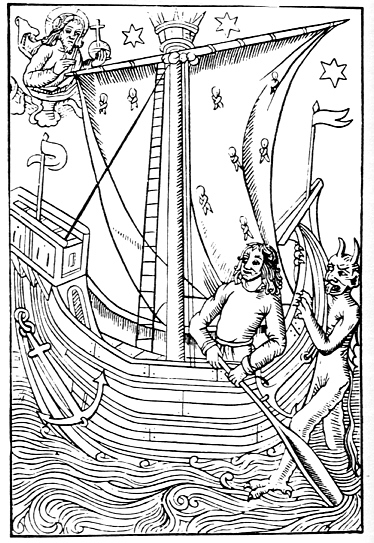
Abb.: Der Seefahrer war vielen Versuchungen ausgesetzt: Seefahrer zwischen Gott
und Teufel, um 1490
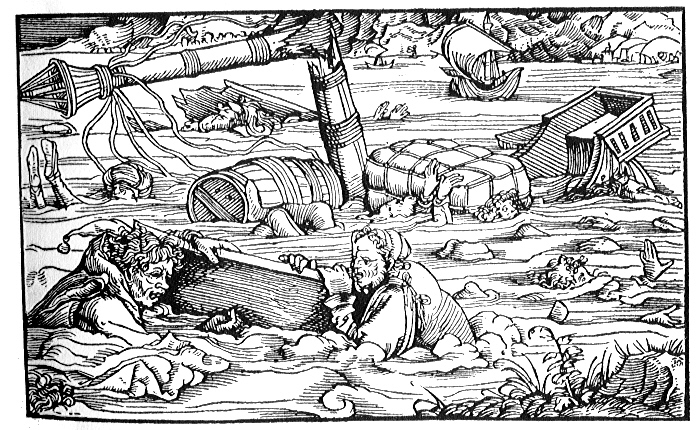
Abb.: Schiffbrüchige: Die Seefahrt nach Indien war äußerst riskant
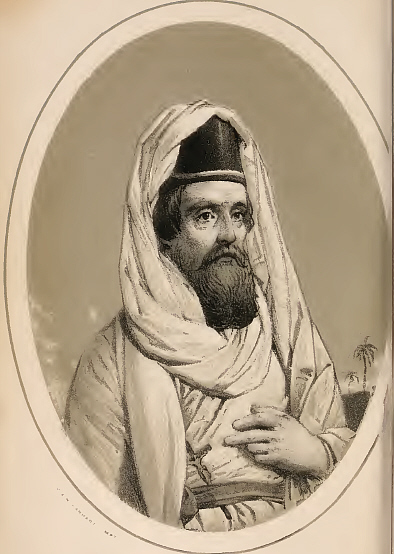
Abb.: Mit den Räubern und Händlern kamen die Missionare: Jesuit in Südindien
[Bildquelle: The Jesuit in India : adressed to all who are interested in the foreign missions. -- London : Burns & Lambert, 1852. -- Frontispiece]
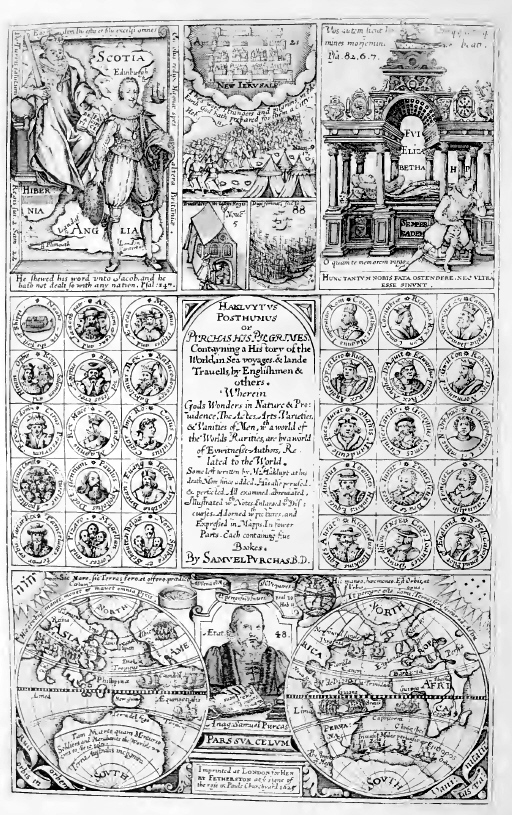
Abb.: Titelblatt
Eine der frühesten (und besten!) Quellensammlungen zur Geschichte der europäischen Exploration und Expansion ist:
Haklvytvs posthumus, or, Pvrchas his Pilgrimes : contayning a history of the world, in sea voyages, & lande-trauells / by Englishmen and others, wherein Gods wonders in nature & prouidence, the actes, arts, varieties & vanities of men, w[i]th a world of the worlds rarities are by a world of eyewitnesse-authors related to the world, some left written by Mr. Hakluyt at his death, more since added, his also perused, & perfected, all examined, abreuiated, illustrated w[i]th notes, enlarged w[i]th discourses, adorned w[i]th pictures, and expressed in mapps, in fower parts, each containing fiue bookes / [compiled] by Samvel Pvrchas, B.D. -- [London] : Imprinted at London for Henry Fetherston at y[e]e signe of the rose in Pauls Churchyard, 1625.. -- 4 Bde. ; 35 cm.
Abb.: Titelblatt von Bd. 1 des Neudrucks von 1905Nachdruck 1905ff. in 20 Bänden: Teilweise Online: http://www.archive.org. -- Zugriff am 2008-06-04. -- Für unsere Zeit sind besonders ergiebig:
Bd. 2, Online: http://www.archive.org/details/hakluytusposthum02purcuoft. -- Zugriff am 2008-06-05
Bd. 3, Online: http://www.archive.org/details/hakluytusposthum03purcuoft. -- Zugriff am 2008-06-05
Bd. 4, Online: http://www.archive.org/details/hakluytusposthum04purcuoft. -- Zugriff am 2008-06-05
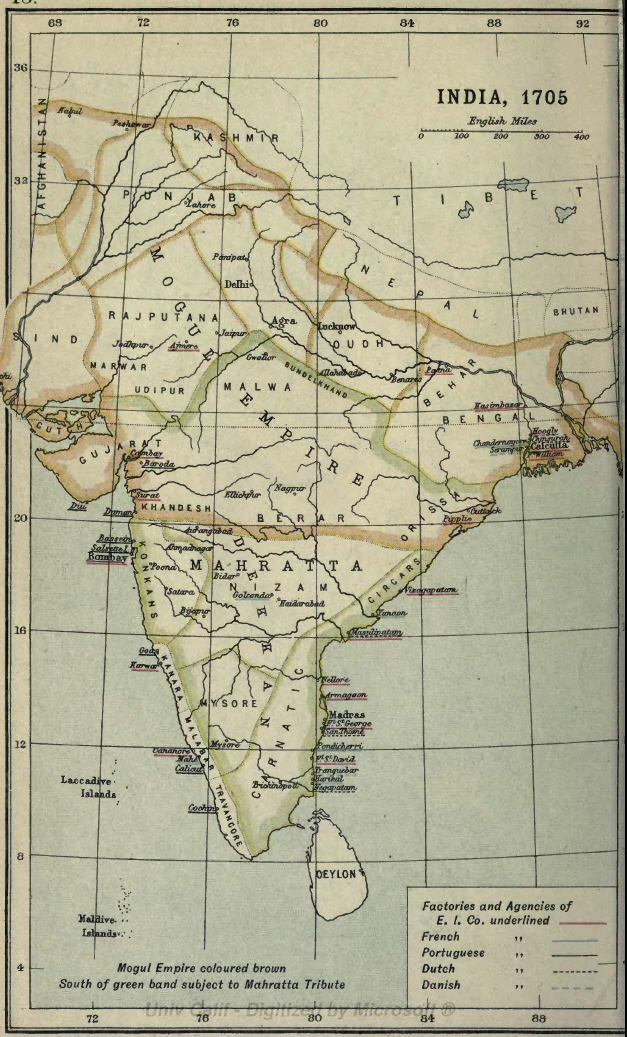
Abb.: Indien, 1705
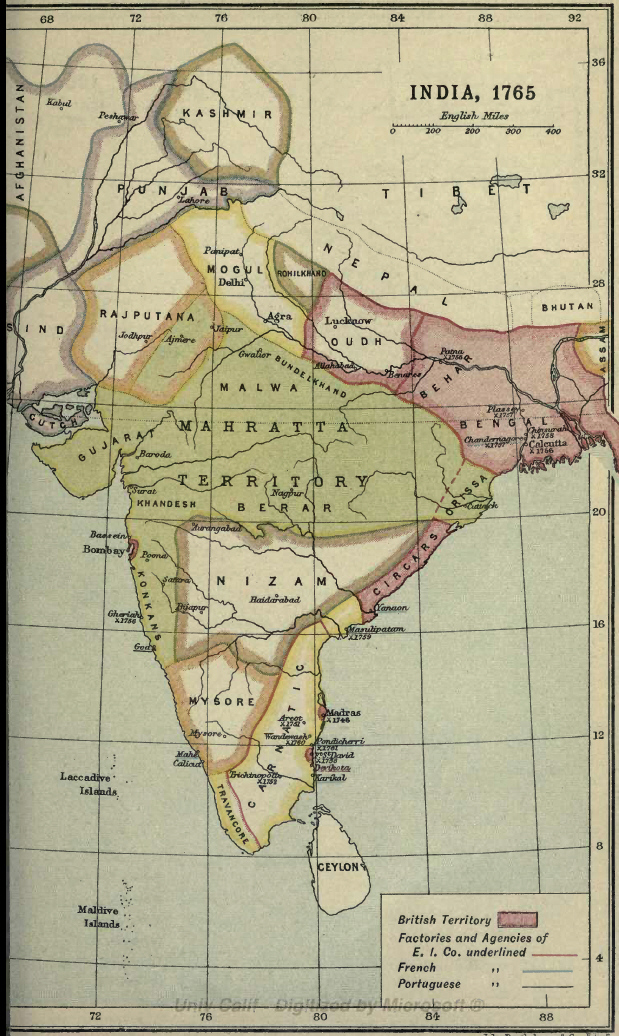
Abb.: Indien, 1765
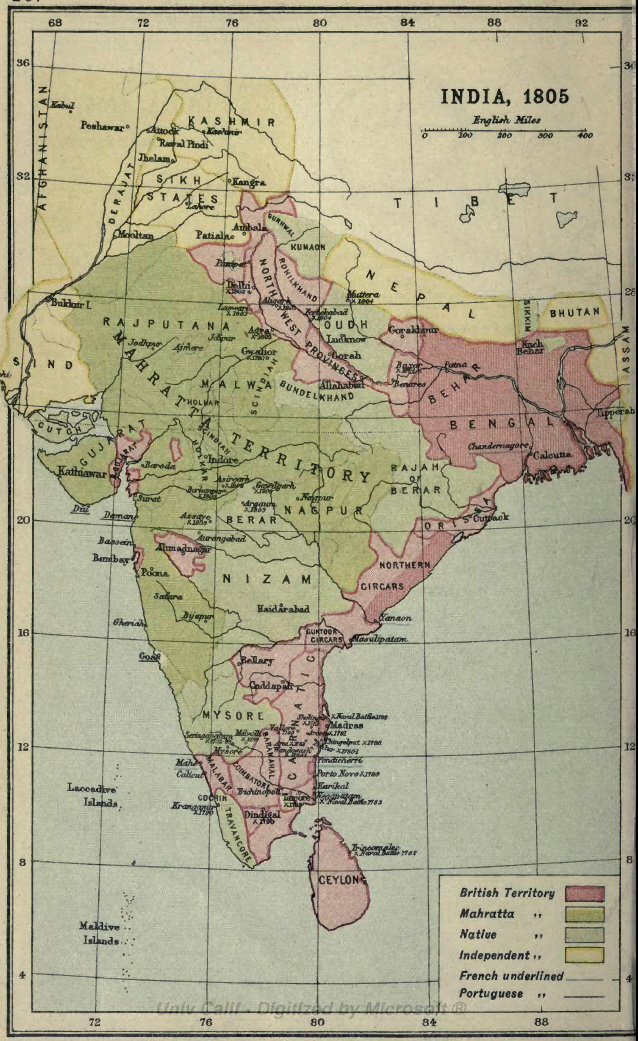
Abb.: Indien, 1805
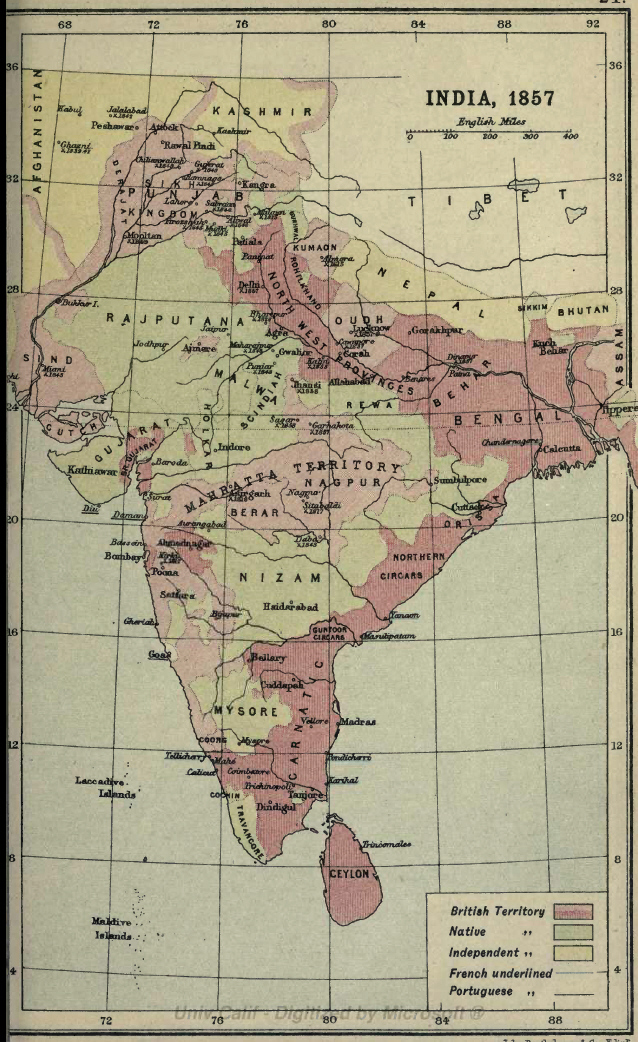
Abb.: Indien, 1857
[Quelle aller vier Karten: Bartholomew, J. G. (John George) <1860-1920>: A literary and historical atlas of Asia. -- London : [1912] -- xi, 226 S. ; Ill. : 18 cm. -- S. 18ff. -- Online: http://www.archive.org/details/literaryhistoric00bartrich. -- Zugriff am 2008-06-10. -- "Not in cpopyright".]
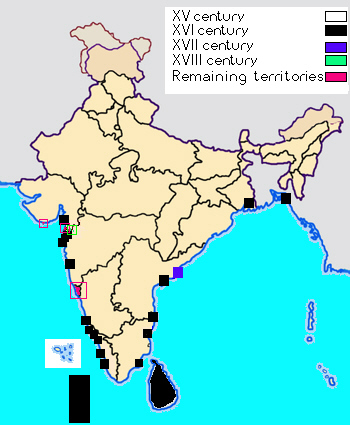
Abb.: Portugiesische Territorien in Indien
[Bildquelle: Wikipedia, Public domain]
"Portugiesisch-Indien (auf portugiesisch: Estado da Índia) war eine portugiesische Kolonie in Indien. Portugiesisch-Indien bestand zum Ende der portugiesischen Herrschaft aus drei nicht miteinander verbundenen Territorien, die als Enklaven im britischen Kolonialgebiet lagen. Es waren dies die Gebiete von Goa, der Hauptstadt Portugiesisch-Indiens, Damão und Diu. Bis ins 18. Jahrhundert hinein wurden von Goa aus jedoch sowohl die Besitzungen in Ostafrika als auch die Stützpunkte in Hinterindien mit verwaltet. Geschichte
Im ausgehenden Mittelalter war Indien, auch wenn man in Europa nicht viel über den Subkontinent wusste, als Ursprungsland der äußerst begehrten und sehr kostbaren Gewürze geschätzt. Seit dem Fall Konstantinopels am 29. Mai 1453 an die Osmanen war der Gewürzhandel für christliche europäische Händler nicht mehr zugängig, das Monopol hatten nunmehr die Moslems. Die Suche nach einer von diesen nicht beherrschten Handelsroute wurde deshalb zu einem wichtigen Teil der Politik der europäischen Handelsnationen, besonders Portugals. Da die Moslems die Landroute kontrollierten, konnte dieser Zugang nur auf dem Seeweg gefunden werden, wofür die Südspitze Afrikas umrundet werden musste. Ein erster wichtiger Schritt auf diesem Weg war getan, als Bartolomeu Diaz 1488 das Kap der Guten Hoffnung erreichte. 1498 erreichte Vasco da Gama schließlich Indien auf dem Seewege.
Die Portugiesen begannen ab 1505 in Indien Gebiete zu erobern und dort Handelsstützpunkte einzurichten. Da der Weg nach Portugal beim Fehlen moderner Kommunikationsverbindungen zu weit war, um die indischen Gebiete effektiv von Portugal aus verwalten zu können, richteten die Portugiesen den „Estado da Índia“, den indischen Staat ein, unter der Regentschaft eines vom portugiesischen Monarchen ernannten Vizekönigs, der weitreichende Vollmachten besaß. Unter den ersten beiden Gouverneuren Francisco de Almeida und Afonso de Albuquerque („Alfonso der Große“) wurde die portugiesische Machtposition planmäßig ausgeweitet. 1509 erlangt Portugal durch die Vernichtung einer arabischen Flotte vor Diu die vollständige Seeherrschaft im Indischen Ozean. 1510 besetzt Alfonso de Albuquerque Goa. 1535 wird Diu, 1588 Damão portugiesisch.
Vor allem Alfonso de Albuquerque hatte begriffen, dass das kleine, bevölkerungsarme Portugal nicht in der Lage gewesen wäre, seine Herrschaft auf Landbesitz zu begründen. Unter seiner Führung stützten sich die Portugiesen daher auf ihre Seemacht. Albuquerque eroberte und sicherte die wichtigsten Stützpunkte an den afrikanischen und asiatischen Küsten des Indischen Ozeans, so dass im Falle von Gefahr das portugiesische Indiengeschwader schnell zu den Konfliktherden verlegt werden konnte. Sofala und Mosambik in Ostafrika, Maskat und Hormuz am Eingang zum Persischen Golf, Goa und Cochin in Indien sowie Malakka auf der Malaiischen Halbinsel bildeten die Eckpfeiler des portugiesischen Estado da Índia und legten die Grundlagen für die See- und Handelsherrschaft der Portugiesen im 16. Jahrhundert im Indischen Ozean. Da die Eroberung von Aden misslang, blieb der alte Handelsweg durch das Rote Meer für die Muslime weitgehend offen, zumal die Osmanen 1538 Aden besetzten.
Zu Beginn des 17. Jahrhunderts begann das Vordringen der Niederländer und der Engländer nach Süd- und Südostasien. Die Niederländer wichen dabei der portugiesischen Route nach Indien aus und steuerten, dank verbesserter geographischer und astronomischer Kenntnisse, vom Kap der Guten Hoffnung aus direkt das heutige Indonesien an.
Ab 1756 begannen die Briten den größten Teil Indiens zu erobern. Zu diesem Zeitpunkt hatte Portugal bereits den Zenit seiner Macht überschritten und konnte so der britischen Expansion nichts mehr entgegensetzen. 1802 bis 1813, während im portugiesischen Mutterland der Kampf zwischen den Briten und Napoleon tobt und Portugal danach de facto durch den britischen Militärbefehlshaber William Carr Beresford regiert wird, ist Portugiesisch-Indien britisch besetzt.
[...]
1946 hatte Portugiesisch-Indien als erste Kolonie den Status als Überseeprovinz erhalten, was allerdings zu keinen großen Veränderungen in der Verwaltung führte. 1954 übernahmen lokale, indische Nationalisten in den portugiesischen Besitzungen Dadra und Nagar Haveli die Kontrolle und schaffen eine proindische Verwaltung. Indien verweigerte für die portugiesischen Truppen den Zugang zu den Enklaven durch sein Territorium. 1961 verliert schließlich Portugal seine letzten indischen Kolonien Goa, Diu und Damão. Diese wurden von der indischen Armee handstreichartig besetzt. In Goa standen 3.000 schlecht ausgerüstete portugiesische Soldaten einer indischen Übermacht von 30.000 Mann gegenüber. Die portugiesische Regierung unter António de Oliveira Salazar war nicht bereit, ihre indischen Kolonien aufzugeben und befahl den dort stationierten Soldaten, in völliger Verkennung der militärischen Machtverhältnisse, sich gegen die Inder zu wehren. Die lokalen Befehlshaber sahen jedoch, dass der Widerstand zwecklos war, und leisteten deshalb dem indischen Einmarsch kaum Widerstand. Portugiesisch-Indien hörte somit nach über 450 Jahren portugiesischer Präsenz auf zu existieren und wurde in die Indische Union eingegliedert.
LiteraturFeldbauer, Peter: Die Portugiesen in Asien : 1498 - 1620. -- Essen : Magnus, 2005. - 254 S. : Ill. ; 23 cm. -- ISBN 3-88400-435-2. -- Frühere Ausg. u.d.T.: Estado da India
[Quelle: http://de.wikipedia.org/wiki/Portugiesisch-Indien. -- Zugriff am 2008-05-20]
Archiv:
Arquivo Histórico Ultramarino (AHU), Lisboa. -- Webpräsenz: http://www.iict.pt/ahu/. -- Zugriff am 2008-05-26
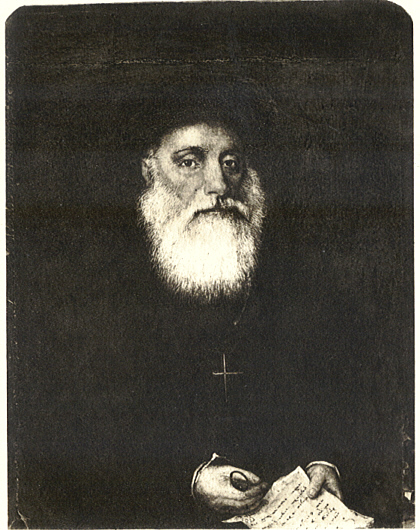
Abb.: Vasco da Gama
Originaltext:
Velho, Alvaro <Vermutlicher Autor>: Roteiro da viagem de Vasco da Gama em MCCCCXCVII. -- 2. ed., correcta e augmentada de algumas observações principalmente philologicas / por A. Herculano e o barão do Castello de Paiva. -- Lisboa : Imprensa nacional, 1861. -- xliii, 180 S. ; 22 cm.
Deutsche Übersetzung:
Hümmerich, Franz <1868 - >: Vasco da Gama und die Entdeckung des Seewegs nach Ostindien ; auf Grund neuer Quellenuntersuchgn dargest. -- München: C. H. Beck, 1898. -- XIV, 203 S. ; 24 cm. -- S. 149 - 191
Teilausgabe der deutschen Übersetzung:
Payer, Alois <1944 - >: Quellenkunde zur indischen Geschichte bis 1858. -- 15. Frühe europäische Quellen und Quellen aus der Zeit der East India Companies. -- 1a. Zum Beispiel: Roteiro da viagem de Vasco da Gama em 1497. -- http://www.payer.de/quellenkunde/quellen1501a.htm
"C. Die zwei ältesten Quellen zur Geschichte der ersten Indienfahrt. 1. Roteiro da viagem de Vasco da Gama em 1497, 2a ed.. correcta etc. por Alexandro Herculano e o barão do Castello da Paiva, Lisboa 1861, die im folgenden übersetzte Quelle.
2. La navigatione prima (di Vasco da Gama) scritta per un gentiluomo Fiorentino che si trovô al tornare dell' armata in Lisbona, gedruckt bei Ramusio, Delle Navigationi etc. Bd. I, S. 119 ff. & Paesi novamente retrovati, c. LI.
Wer die oben (S. 118) angeführte Stelle auf S. VI von Stanleys Einleitung liest, der muss zu der Meinung kommen, dass es außer den Werken des Correa, Castanheda, Barros, Goes und Osorio keine Quelle für die Kenntnis der ersten Indienfahrt gebe. Sie alle können aber nicht einmal als Quellen erster Hand angesehen werden, weil ihre Darstellung wieder auf andere Berichte zurückgeht. Und doch sind uns zwei Quellen erhalten, die als unmittelbarer Niederschlag der Ereignisse gelten dürfen, und von denen jede Kritik der anderen ausgehen muss. Das eine ist der Roteiro da viagem de Vasco da Gama em 1497 (Wegweiser von Vasco da Gamas Reise im Jahre 1497), der im folgenden übersetzte Bericht eines Seemannes, der die Entdeckungsfahrt mitmachte, das zweite, schon in den Paesi novamente retrovati 1507 und danach in Ramusios großem Werk erschienen, der Brief eines Florentiner Edelmannes, der sich zur Zeit der Rückkehr von Gamas Schiffen in Lissabon befand. Da wir es hier mit zwei von einander unabhängigen, in sich glaubwürdigen Berichten zu tun haben, so darf als kritischer Grundsatz für die Beurteilung von [S. 126] Ereignissen der Entdeckungsfahrt aufgestellt werden: Wo diese beiden Darstellungen inbezug auf eine Einzelheit der Reise übereinstimmen, muss die betreffende Tatsache als zweifellos erwiesen gelten. Von diesen beiden Berichten hat Stanley keinen benutzt; wer nun aus dieser Tatsache schließen wollte, dass er keinen davon gekannt habe, der würde einen Fehlschluss tun; denn im Appendix seines Buches, S. I, teilt er mit genauer Quellenangabe ein Dokument mit, das im Anhange des Roteiro veröffentlicht ist. Stanley wusste also von diesem Buche und hat es nicht für nötig befunden, dasselbe in den Kreis seiner Betrachtung auch nur mit einem Worte hereinzuziehen.
Der bei Ramusio gedruckte Brief des Florentiners stammt aus der zweiten Hälfte des Jahres 1499. Es ist zuerst von Angelo Bandini (Vita e Lettere di Amerigo Vespucci, Florenz 1745, p. 85 ff.) und danach von portugiesischen Forschern mehrfach dem Amerigo Vespucci zugeschrieben worden, kann aber nach der oben mitgeteilten Überschrift bei Ramusio, die auch durch den Inhalt bestätigt wird, von ihm nicht herrühren, da sich Vespucci zur Zeit von Gamas Heimkehr (August oder September 1499) auf seiner Reise mit Hojeda befand, von der er nach der bestbegründeten Ansicht erst im Juni 1500 zurückkam. Zweifellos aber war er in der zweiten Hälfte des Jahres 1499 nicht in Lissabon. Der Bericht zerfällt in zwei Abschnitte. Der erste derselben, Kap. I—VI umfassend, ist entstanden, ehe Vasco da Gama selbst oder sein Schiff Gabriel noch eingetroffen war, gründet sich also auf Erkundigungen, die der Verfasser von der Besatzung der Berrio eingezogen hatte. Der zweite Teil, Kap. VII und VIII. fußt auf Mitteilungen des bei Angediva gefangenen Juden, den er, ebenso wie andere Teilnehmer an der Fahrt, persönlich über alles befragt hat. Abgeschlossen wurde der Brief nach dem Eintreffen entweder des Vasco da Gama oder seiner von Santiago (Kapverden) kommenden S. Gabriel, sicher aber vor Ende des Jahres; das ergibt sich mit Bestimmtheit aus der Angabe des Schlusssatzes, dass in Lissabon bereits vier Schiffe und zwei Caravellen bereit lägen, um im kommenden Januar nach dem Osten abzugehen. Für die Kenntnis der Reise im einzelnen ist aus dem Brief wenig zu gewinnen; er enthält sogar einige fehlerhafte Angaben; der Verfasser, ein in Portugal heimischer Florentiner, will vielmehr die kommerziellen Resultate und voraussichtlichen Wirkungen der neuen Entdeckung feststellen; er verweilt mit Interesse bei der Frage, welche Artikel sich zum Export und Import in den neu entdeckten Ländern voraussichtlich eignen werden, bei der Herkunft und dem Preis der einzelnen Gewürze und Juwelen, bei den Handelswegen und Verkehrsmitteln, bei der Fahrbarkeit der östlichen Heere, den Münzverhältnissen u. s. w. Ihn interessiert die kaufmännische Seite der Sache, nicht die Reise selbst in erster Linie. Von diesem Bericht sind einige mehr oder minder genaue deutsche Übersetzungen aus dem 16. Jahrhundert erhalten. Die eine stammt aus Konrad Peutingers Nachlass, und ist mit dem Tagebuch des Lukas Rem (S. 120 ff.) von B. Greiff (Augsburg 1861) herausgegeben worden. Sie war dem Hause Welser von Rom aus zugesandt, enthält mancherlei Missverständnisse und ist mehr eine Inhaltsangabe als eine wirkliche Übersetzung. Eine andere findet sich in dem 1534 zu Strassburg erschienenen Sammelwerk von Michael Herr, "Die New Welt" (S. 18 ff.). Sie schließt sich einigermaßen an das Original an, ersetzt aber im ersten Abschnitt meist die dritte Person durch die erste. "Alss wir nu wider heim kumen warend" u. s. w. Auf die gleiche Quelle geht der Bericht bei Jobst Ruchamer "Unbekannthe Landte und ein newe Welt" (Nürnberg 1508), Kap. 51—62, zurück. Selbständigen Wert haben diese Übersetzungen neben dem italienischen Original [S. 127] alle nicht. Auch Bernaldez (Historia de los Reyes catholicos, Sevilla 1870, Kap. 158) hat aus dem Bericht unseres Florentiners seine Kenntnis der ersten Indienfahrt geschöpft.
Die zweite, durchaus selbständige und. wie wir sehen werden, wertvollste aller Quellen ist der in Übersetzung folgende Roteiro. Es ist der nach Tagebuchaufzeichnungen angefertigte Bericht eines Seemannes, der auf dem Schiffe des Paulo da Gama von Lissabon mitausfuhr. Dass er Seemann, nicht Soldat war, ergibt sich mit Wahrscheinlichkeit unter vielen anderen aus der Stelle in Kap. 12 von Beilage II, wo er sagt: "An selbigem Tage nach dem Essen fanden wir beim Aufsetzen eines Beisegels eine Elle unter dem Mastkorb einen Riss in dem Maste, und selbiger Riss öffnete und schloss sich." Die Tatsache, dass er zur Mannschaft des Paulo da Gama gehörte, ergibt sich aus Kap. 1, wo er erzählt, wie allmählich das zerstreute Geschwader sich wieder zusammenfindet. Fünf Schiffe sind es mit dem des Bartolomeo Diaz. Am Sonntag — erzählt unser Autor — kommen das Proviantschiff, die Caravelle des Nicolao Coelho und das Schiff des Bartolomeo Diaz in Sicht und am folgenden Mittwoch das des Geschwaderchefs; also muss er selbst mit Paulo da Gama gefahren sein. Zu den Kapitänen gehörte er nach dieser und anderen Stellen nicht; dass er auch kein Steuermann war, machen solche Stellen wahrscheinlich wie Kap. 71: "Und die Steuerleute sagten, dass wir auf den Untiefen des Rio Grande seien." Seinen Namen nennt er nicht, wie er denn überall seine Person bescheiden in den Hintergrund stellt. Was wir außer Kleinigkeiten von ihm erfahren, ist, dass er zu den ausgewählten Mannschaften gehörte, die Vasco da Gama zu der Audienz beim Raja von Calicut mit an Land nahm. Aus dieser Tatsache haben die portugiesischen Herausgeber des Roteiro — die erste Ausgabe veranstalteten (Porto 1838) Diogo Kopke und Antonio da Costa Paiva — durch Vergleich mit Castanheda seinen Namen zu ermitteln gesucht. Sie schließen S. XXV—XXXI folgendennassen: Castanheda (Historia do descobrimento, Liv. I, c. 16) nennt von den Begleitern des Kommandanten in Calicut den Diogo Diaz, Schreiber des Vasco da Gama, Fernão Martins, den Dolmetscher, ferner den Veador (Warenverwalter) des Vasco da Gama, dessen Name nicht angegeben wird, dann João de Sá, Schreiber des Paulo da Gama, einen Matrosen mit Namen Gonçalo Pires, einen gewissen Alvaro Velho und Alvaro de Braga, Schreiber des Nicolao Coelho. Nun steht durch die fast wörtliche Übereinstimmung beider Darstellungen fest, dass für Castanhedas Schilderung der Entdeckungsfahrt unser Roteiro die Quelle gewesen ist. Da Castanheda nicht gar lange nach den Ereignissen, welche er hier schildert, gelebt und eine seltene Sorgfalt darauf verwandt hat, die Wahrheit des Geschehenen möglichst vollständig zu ergründen, so ist anzunehmen, dass er von dem Autor unseres Roteiro den Namen wusste, und da derselbe nach seinem eigenen Bericht zu dem Gefolge des Kommandanten in Calicut gehörte, so wird er unter den bei dieser Gelegenheit von Castanheda Genannten schwerlich übergangen sein. Nun schließt aber die Erzählung des Roteiro ohne weiteres aus, dass der Autor des Tagebuches Diogo Diaz sein könnte oder Fernão Martins oder der Veador des Vasco da Gama oder Alvaro de Braga. Gegen João de Sá sprechen folgende Erwägungen: Erstens war unser Autor, wie es scheint, ein einfacher Matrose, zweitens wissen wir durch Castanheda (Hist. do descobr. Liv. I, c. 16), dass João de Sá von dem Christentum der Inder nicht so ganz überzeugt war, während unserem Autor darüber nicht der mindeste Zweifel gekommen ist. Es bleiben also nur noch Gonçalo Pires und Alvaro Velho. Die Entscheidung aber zwischen diesen beiden ist nicht schwer. Wenn man nämlich die Stellen nebeneinandersetzt, an [S. 128] denen bei Castanheda von Gonçalo Pires die Rede ist, und dann die Darstellung unseres Berichtes damit vergleicht, so ergibt sich klar, dass der Autor des Roteiro jenen von seiner Person trennt. Castanheda sagt a. a. O., Liv. I, c. 21: "Der Catual .... nahm Vasco da Gama längs des Strandes mit, und da derselbe auf Grund dessen, was ihm in Calicut widerfahren war, diesem Volk misstraute, so sagte er dem Gonçalo Pires, dem Matrosen, er solle mit noch zwei der Unseren vorausgehen, soweit er könne, und wenn er den Nicolao Coelho mit den Booten finde, ihm sagen, dass er sich in Sicherheit bringen möge." An der entsprechenden Stelle, Kap. 47, berichtet unser Autor: "Dann führten sie uns am Strande hin, und der Kommandant, dem das gefährlich schien, schickte drei Leute voraus mit dem Befehl, wenn sie die Boote von den Schiffen sähen, und sein Bruder da sei, dass er sich in Sicherheit bringen solle." Beide Autoren berichten dann, wie die drei Leute sich von den übrigen weg verlieren, und fahren fort: Castanheda: "So saßen sie, da kam Gonçalo Pires an, mit der Meldung von Nicolao Coelho, dass er ihn mit den Booten erwarte." Unser Autor (Kap. 49): "Und während wir so saßen, kam einer von den Leuten, die sich am Abend vorher verloren hatten, und meldete dem Kommandanten, dass Nicolao Coelho seit dem Abend vorher mit den Booten an Land sei und auf ihn warte." Es bliebe also von den Genannten als Autor für den Roteiro nur Alvaro Velho übrig. Die portugiesischen Herausgeber sind sich natürlich klar darüber, dass diese Kette von Schlussfolgerungen nur den Wert einer Konjektur hat, die lediglich unter der doppelten Voraussetzung zutrifft, dass Castanheda von unserem Autor den Namen gewusst und genannt hat, und dass er, über die Einzelheiten dieser Tage gut unterrichtet, in der Wiedergabe der Ereignisse ebenso gewissenhaft wie sonst im allgemeinen war.
Wer der Verfasser des Roteiro auch sein mag, sein Bericht ist das Wertvollste, was wir über die erste Indienfahrt des Vasco da Gama besitzen. Leider aber ist er nicht vollständig und war es vermutlich nie. Die Erzählung der Entdeckungsfahrt bricht mit dem 25. April 1499 jäh ab, unmittelbar vor dem Augenblick, wo Nicolao Coelho durch Sturm von dem Kommandanten getrennt wird, es folgt aber darauf ein Anhang über indische Länder und Reiche, Handelsprodukte und Gewürzpreise, der nach Stil und Inhalt von demselben Verfasser herzurühren scheint. Der Eindruck des Bewussten und Gewollten in dem plötzlichen Verstummen des Berichterstatters wird durch das Vorhandensein dieses Anhanges noch verstärkt. Dass Coelhos Schiff am 10. Juli allein in Lissabon einfuhr, steht fest durch die Übereinstimmung fast aller Quellen mit dem oben erwähnten Brief des Florentiner Edelmannes. Die Frage, ob jene Trennung von Nicolao Coelho beabsichtigt war, ob er, der größeren Geschwindigkeit seiner Caravelle vertrauend, der erste sein wollte, der von der Entdeckung Indiens dem König die Kunde brächte, muss offen gelassen werden. Castanheda nimmt das unlautere Motiv an, Barros und Goes schreiben die Trennung lediglich der Gewalt des Sturmes zu, und der erste erzählt sogar, Nicolao Coelho habe umkehren wollen, als er an der Barre von Lissabon vernahm, dass der Kommandant noch nicht eingetroffen sei. Nach dem Brief des Florentiners möchte man eher an eine beabsichtigte Trennung denken. Da der Sturm außerdem bei den Inseln des grünen Vorgebirges stattfand, diese Inseln aber für die Hinfahrt als Sammelpunkt für den Fall einer Trennung durch die Instruktion zweifellos bestimmt waren, und Vasco da Gama auch auf der Rückfahrt nach dem Sturm Santiago anlief, so wäre ein Gleiches bei Nicolao Coelho wohl das Natürlichere gewesen. Was hat aber diese Frage mit dem jähen Abbrechen unseres [S. 129] Tagebuches, was hat der Verfasser desselben mit Nicolao Coelho zu tun? Nach den übereinstimmenden Berichten unseres Autors, des Castanheda, Barros, Goes u. a. wurde bei der Rückkehr auf den Untiefen des heil. Raphael das Schiff des Paulo da Gama verbrannt und der Rest seiner Mannschaft teils auf die Gabriel, teils auf die Caravelle des Nicolao Coelho versetzt. Sollte unser Autor der letzteren zugeteilt worden sein? In diesem Falle würde sein jähes Verstummen für Nicolao Coelho schwerlich etwas Gutes bedeuten. Mit Sicherheit wird man indes nicht danach urteilen können.
Die Handschrift, auf Grund deren Diogo Kopke und Antonio da Costa Paiva die erste Ausgabe des Roteiro veranstalteten, die einzige Handschrift, in der er erhalten ist, stammt aus der Bibliothek des ehedem so reichen Klosters von Santa Cruz in Coimbra und befindet sich heute in der Bibliothek von Porto, wohin sie mit dem größten Teile jener alten und wertvollen Sammlung bei der Aufhebung der Klöster gebracht wurde. Dass man es mit keinem Autographen des Verfassers zu tun hat, ergibt sich aus Kap. 60, wo der Kopist auf eine Lücke im Text mit den Worten aufmerksam macht: "Wie diese Waffen aussehen, ist dem Verfasser des Buches in der Federspitze stecken geblieben." Dem Schriftcharakter nach gehört indes die Kopie, wie die Herausgeber bestimmt versichern, dem beginnenden 16. Jahrhundert an, ist also sehr früh. Die Vermutung, dass der Bericht nie vollständig gewesen sei, wird wahrscheinlich auch dadurch, dass schon Castanheda ihn nur soweit kannte, als er uns vorliegt. In der äußerst seltenen Ausgabe des ersten Buches seiner Historia do descobrimento vom Jahre 1551 sowie in der danach angefertigten spanischen Übersetzung, die zu Antwerpen 1554 erschien, steht (Kap. 27) fast wörtlich der Schlusssatz unseres Roteiro: "und die Piloten sagten, dass sie auf den Untiefen des Rio Grande seien", und dann folgt unmittelbar: "und die weiteren Einzelheiten, die der Kommandant von da an bis zu der Insel Santiago noch erlebte, konnte ich nicht erfahren, nur ..." Dieser Satz findet sich zwar in der zweiten Ausgabe von Castanhedas erstem Buch nicht mehr (1554), aber es wird über den Rest der Reise nicht eine Tatsache mehr als dort mitgeteilt. Auf Grund einer gewissen Ähnlichkeit der Schrift und aus dem Fundort des Manuskriptes, Coimbra, haben die portugiesischen Herausgeber vermutet, die erhaltene Abschrift des Roteiro könne, da Fernão Lopez de Castanheda die letzten Jahre seines Lebens in Coimbra verbracht und sein Werk daselbst verfasst hat, von ihm selbst geschrieben sein. Damit ist aber ihre andere Angabe nicht wohl vereinbar, wonach das Manuskript in die Anfänge des 16. Jahrhunderts gehören soll; und eine Stelle Castanhedas steht mit dieser Annahme in direktem Widerspruch. Hist. do descobr., Liv. I, c. 16, erzählt er nämlich, wie Vasco da Gama sich von Pandarane, wo die Schiffe verankert liegen, zur Audienz bei dem Raja nach Calicut begibt. "Nachdem Vasco da Gama," heißt es dort, "in diese Sänfte eingestiegen war, brach er mit dem Catual, der in einer anderen den Weg zurücklegte, nach einem Orte auf, von dem ich den Namen nicht erfahren konnte." Nun steht aber in unserem Manuskript in voller Übereinstimmung mit dem, was wir nach der Lage der Orte und den Berichten der Historiker als gesichert annehmen dürfen, dass Gamas Weg nach Calicut über Capocate ging, das der Roteiro Capuá nennt, und dass dort die Mittagsrast stattfand, von der Castanheda spricht. Dass das Capuá des Roteiro mit Capocate identisch sei, wusste derselbe, wie ein Vergleich zwischen Liv. I, c. 13 seiner Hist. do descobr. mit Kap. 37 unseres Berichtes ergibt. Der Bericht des Roteiro ist. wie schon erwähnt, nach der Lage der Orte völlig einwandfrei, und Castanheda [S. 130] konnte sachliche Bedenken gegen die Angabe desselben somit nicht haben; wenn er also erklärt, er habe den Namen nicht erfahren können, so kann unsere Kopie des Roteiro, die denselben enthält, sein Handexemplar nicht gewesen sein.
Was die Glaubwürdigkeit der Darstellung betrifft, so spricht alles für den Roteiro. Erstens ist er zweifellos nach einem Tagebuch gearbeitet, wie die mit Wochen- und Monatstag fest datierten Notizen, oft über ganz geringfügige Ereignisse, beweisen. Zweitens ist der Autor ein einfacher, bescheidener Mensch, der überall seine Person in den Hintergrund stellt, nirgends aus persönlicher Vorliebe oder Abneigung Tatsachen entstellt, sondern ruhig und sachlich, mit der frischen und naiven Auffassung eines ungebildeten, aber vortrefflich beobachtenden Mannes, mit behaglicher Breite und unverkennbarer Gutmütigkeit die Dinge, die er sieht und erlebt, unter dem frischen Eindruck des Geschehenen in einem sehr wenig gewandten, von Fehlern und Unbeholfenheiten wimmelnden, aber nicht reizlosen Portugiesisch aufzeichnet.
In diesem Tagebuch und dem schon besprochenen Briefe des Florentiner Edelmannes haben wir also für die erste Reise des Vasco da Gama zwei voneinander unabhängige, in sich glaubwürdige Quellen im eigentlichen Sinne; daher muss, um das noch einmal an den Schluss dieses Abschnittes zu stellen, wo diese beiden Quellen inbezug auf ein Geschehnis der Reise übereinstimmen, dasselbe als erwiesen angesehen werden. Unter diesem Gesichtspunkt gilt es, ihre Darstellung mit der des Correa zu vergleichen."
[Quelle: Hümmerich, Franz <1868 - >: Vasco da Gama und die Entdeckung des Seewegs nach Ostindien ; auf Grund neuer Quellenuntersuchgen dargest. -- München: C. H. Beck, 1898. -- XIV, 203 S. ; 24 cm. -- S. 125 - 130]
Correa, Gaspar <16. Jhdt>: Lendas de India par Gaspar correa / Gaspar Correa publicadas ... soba déreagãe de Rodrigo José de Lima Felner [1809 - 1877]. -- Lisboa : Typ. da Academia real das sciencias, 1858-1864. -- 4 Bde. : Ill. ; 28 cm. -- (Collecçao de monumentos eneditos para a historia das renquistas dos Portuguezes en Africa, Asia et America ; Ser. 1, T. 1-4)
Übersetzung:
Correa, Gaspar <16. Jhdt>: The three voyages of Vasco da Gama, and his viceroyalty. From the Lendas de India of Gaspar Correa. Accompanied by original documents / Translated from the Portuguese, with notes and an introd., by Henry E. J. Stanley. -- New York : Franklin, [1963?]. -- lxxx, 430, xxxv S. ; 23 cm. -- Reprint of the 1869 ed. published by the Hakluyt Society. -- (Hakluyt Society. Works ; no. 42.). -- Originaltitel: Lendas de India. -- Online: http://www.archive.org/details/voyageroundworld01tayl. -- Zugriff am 2008-05-22. -- "Not in copyright."
Teile der Übersetzung siehe:
Payer, Alois <1944 - >: Quellenkunde zur indischen Geschichte bis 1858. -- 15. Frühe europäische Quellen und Quellen aus der Zeit der East India Companies. -- 1. Zum Beispiel: Gaspar Correa <16. Jhdt.>: Lendas de India, erste Reise Vasco da Gamas nach Indien. -- Fassung vom 2008-05-25. -- http://www.payer.de/quellenkunde/quellen1501.htm
Payer, Alois <1944 - >: Quellenkunde zur indischen Geschichte bis 1858. -- 15. Frühe europäische Quellen und Quellen aus der Zeit der East India Companies. -- 2. Zum Beispiel: Gaspar Correa <16. Jhdt.>: Lendas de India, dritte Reise Vasco da Gamas nach Indien. -- Fassung vom 2008-05-26. -- http://www.payer.de/quellenkunde/quellen1502.htm
"INTRODUCTION. Louvarei antes o Camoens sublime,
E o bravo Gama, arando ignotos mares,
E as Nereidas nuas impellindo
As uaos, que ameaça o escolho.Francisco MANUEL
The account here given of Vasco da Gama's voyages is taken from Gaspar Correa's Lendas da India, and is entirely new ; for Correa's work, which has only been printed within the last ten years, enters into much more detail than the other chroniclers, frequently differs from them, and has not been made use of by the great majority of the historians who wrote subsequently to him.
Gaspar Correa went to India, as he says in his prologue, when very young, and sixteen years after India was discovered,—that would be in 1514. The editors of the history, printed by the Academy of Lisbon, say, however, that he sailed with Jorge de Mello in March of 1512, on the ground of a receipt of which a facsimile is given. The receipt is signed by Gaspar Correa, but bears no date. It does not appear to bear out the assumption that Correa sailed with Jorofe de Mello. It runs thus : [S. ii]
" tres adiçoes
Gaspar Correa que foy de Jorge de mello que foy mestre salla avera ho mes de Junho sem cevada ao respeito 406 reis Recebeo de nuno Rybeiro os quatrocentos e seys reis em cyma conteudos,
Bastião da costa. Gaspar Correa."Correa arrived in India fifteen years before Castanheda, and must have begun to write his history during the government of Alfonso d'Albuquerque, since while he was his secretary he got hold of a diary written by Joam Figueira, a priest, who accompanied Gama ; and this, he says, gave him the desire to write down all that he could learn of the deeds done in India. He wrote the history of fifty-three years of the Portuguese exploits in India, leaving off with the government of Jorge Cabral. He mentions having written part of his history in 1561. The year of his death, which, according to Barbosa Machado, occurred in Goa, is not known ; but, as the editors of the printed copy say, it must have been before 1583, since Miguel da Gama, son of D. Francisco, the second count of Vidigueira, left India on February 21st, 1583, bringing with him Correa's manuscript. D. Miguel's ship, the Reliquias, encountered many storms, and at length arrived in the Tagus, where fire broke out on board the ship, which was with difficulty extinguished, and Correa's manuscript escaped from this danger also.
Nicholas Antonio, in his Bibliotheca Scriptorum Hispaniae (Rome, 1672), mentions our author in the following terms, "Gaspar Correa, Lusitanus, a civibus suis laudatur eo quod scripserit, Historia da India" ; [S. iii] and the prologue of the Academy edition compares him to Polybius : so that it might be a matter of surprise that his work was not published till three centuries after it was written.
The printed edition explains the causes which operated to prevent this publication in later times : at an earlier period they must be attributed to the fact that Correa expressly intended his work to be a posthumous one, in order that he might speak the truth of all concerned ; after his death, from the corruption which had set in among the Portuguese, truth was still more unpalatable ; and it may also be supposed that many passages of Correa's history could not have passed through the censure of the Inquisition, since at that time they would have affixed upon D. Joam II. and upon D. Manuel the stigma of Judaism and necromancy.
Correa's work was hardly ever mentioned from that time till 1790, when the Lisbon Academy determined on obtaining a copy of it, for the purpose of printing it. Till lately they had not obtained more than a transcript of part of the first volume, made by two persons, apparently at the end of the last century or beginning of the present one. At length, in 1836, the second, third, and fourth volumes of Correa's manuscript, written in his own hand, were deposited in the library of the Archives by Senhor Dr. Antonio Nunes de Carvalho. The work, however, could not proceed for want of the first volume, which is lost without leaving any trace or hopes of recovery.
Some years ago, however, Senhor Aureliano Basto, [S. iv] father of Senhor Joam Basto, the Keeper of the Archives, was so fortunate as to hear of a copy of the first volume in the shop of a confectioner, where he bought it for twenty-eight thousand eight hundred reis. This copy is said to be of a date but a little more modern than the time of Correa.
A second copy exists in the Royal Library of the Ajuda, in two volumes, in a handwriting apparently of the eighteenth century, or end of the seventeenth. This copy is very imperfect. In many parts the copyist has been unable to read the original, besides which he took impardonable liberties with the text, correcting and mutilating it, and making large omissions. This copy, however, served to assist MM. Basto and Gomes Goes, also of the Archives, in preparing a copy for the press, which has been edited by Senhor Rodrigo J. de Lima Felner.
The translation now given to the Hakluyt Society has been made from a transcript taken from another copy of the first volume, the property of the Duke of Gor, and which before it belonged to his family, had belonged to the Count of Torrepalma. I was not aware till last year that copies of Correa existed at Lisbon ; and the editors of the Lisbon edition did not know of the copy in the possession of the Duke of Gor. Singularly enough, the Duke of Gor's copy and that rescued from the confectioner appear to have been written by the same scribe : the handwriting, size of the volume and page, columns and headings of the pages in red ink, are similar in the two copies. A whole leaf, however, of the [S. v] Lisbon copy had gone to wrap up sweetmeats, so that the beginning of chapter vi and end of chapter vii have been made to coalesce into chapter vi in the printed edition.
The various chroniclers who have related Gama's voyage to India vary very much in their dates, and agree only as to the date of his arrival at the river named Dos Reis, on Twelfth Day. They also differ in the number of ships that composed the squadron, some giving four and others three ships, and they vary as to where the three ships were reduced to two, Correa's account, however, differs still more from that of all the others, for he makes the departure from Melinde and arrival in India three months later than in any of the other narratives.
He also very much shortens the return voyage to Melinde, which the other historians represent as one of the most arduous passages, in which the crews suffered great hardships. In this, Camoens seems to have followed Correa, canto x, stanza 144 :
" Thus they set out, cutting through the sea serene,
With the wind always gentle, meeting no storm,
Until the desired land hove in sight again ;
The ever-beloved country in which they were born."MITCHELL.
They also differ in the fact that Correa names Gama's ship S. Rafael, whilst Barros names it S. Gabriel; but outside the town of Vidigueira, of which Gama was made Count, there is a chapel of St. Raphael, in which an image of that saint is preserved to whom Gama's ship was dedicated. Correa is also the only [S. vi] historian who relates that Gama visited Cananor [Kannur/കണ്ണൂര്] on leaving Calicut [Kozhikode/കോഴിക്കോട്].
The following are the reasons why, in my opinion, Correa's narrative should be preferred to the others.
Firstly, he came to India earlier than any of the other writers, and was the only one who made use of the diary of the priest Joam Figueira. Castanheda who went to India in 1528, is the only historian who competes with him in this respect. Damian de Goes did not visit India. Osorio takes almost all his facts from Goes, and Barros wrote much later.
Secondly, the reasons given by Correa why his work should be a posthumous one, and the religious respect for truth which he professes, ought to secure to him a large share of credibility.
Thirdly, in many of the points in which Correa is at variance with the other chronicles, his narrative is more in accordance with human nature and probability.
The salient points of the narratives of Castanheda, Barros and others, have been added at the foot of the text, and further reasons for preferring Correa's dates and version will be found in the footnotes.
The Lisbon edition does not examine which of the various accounts are to be preferred. The prologue only observes that Correa's work contains some chronological errors, and disputes what he says of the invention of nautical instruments, and of the use of portable firearms. It adds, that "these venial faults ought not to diminish the lustre of Caspar Correa, nor raise doubts as to his good faith, and the full truth with which he relates what he saw and [S. vii] heard." The prologue also disputes Correa's giving the credit of the voyage of Bartholomew Dias to Joam Infante. Here, however, geography supports Correa, for the name of Rio do Infante, the term of the voyage in which Joam Infante and Bartholomew Dias doubled the Cape of Good Hope, shows that Correa had not exaggerated the position held by Joam Infante in that voyage.
I do not know to what anachronism as to espingardas or firelocks the prologue refers : Barros, however, and not Correa, is the person who is guilty of them in Gama's first voyage. Correa only mentions the use of cross-bows.
Amongst the rare occasions in which Caspar Correa mentions himself, we find the following in the year 1547 (tom. iv, p. 596). At that time "D. Joao de Castro (the thirteenth governor) thought it right to preserve some recollection of the former governors, so he summoned me, Caspar Correa, as I understood painting, and because I had seen in this country all the governors who had governed in these parts; and he enjoined me to work at drawing all the governors naturally [the size of life ?]. In which I occupied myself with a painter, a man of the country, who had a great natural turn, and he, by the directions which I gave him, painted their faces so like nature, that whoever had seen them, at once, on seeing the paintings, recognised them. The governor also had himself painted there after nature, armed as if he was figuring in a triumph.1 All were painted on boards, [S. viii] each one separately, full size, and all armed with corslets, and some with the very weapons with which they armed themselves, and upon them garments of dark silk, with very rich gold embroidery, and handsome swords, and above their heads the escutcheons of their arms. At the foot of each was written in gilt letters their names, and the time during which they had governed. He ordered these to be placed in the hall of their house, covered with curtains. This was a thing which looked very well, and all the ambassadors and foreign merchants delighted much in seeing them ; so much so that some kings and lords sent to fetch them all together to see them. The governor put lay figures2 in the hall, with halberds,3 and with awful features to inspire dread in the Moors who saw them. As the first governor was the Viceroy D. Francisco d'Almeida, the head of the house of the Almeidas of Portugal, a man of great merit, as has been written in this history, and as the governor was much pleased with his noble deeds, he ordered an inscription to be written in this manner: 'Rejoice, O great and warlike Lusitania, over your good Portugal, since from thee issued Dom Francisco d'Almeida, the most illustrious man who conquered these parts : and warring in them subjected them to the lordship of Portugal, with so much glory to the royal sceptre."
1 This refers to the palm he holds in his hand, and the palm leaf crown on his head in the picture, tom. iv, p. 430.
2 Cabides.
3 BysarmasThe autograph manuscript of Correa contains his pen and ink sketches of these governors, which have been reproduced in the Lisbon edition. They are [S. ix] better than the portraits in Pedro Barreto de Resende's work, which are probably copied from the portraits at Goa. There is a MS. of P. B. de Resende in the Sloane collection of the British Museum."
[Quelle: Correa, Gaspar <16. Jhdt>: The three voyages of Vasco da Gama, and his viceroyalty. From the Lendas de India of Gaspar Correa. Accompanied by original documents / Translated from the Portuguese, with notes and an introd., by Henry E. J. Stanley. -- New York : Franklin, [1963?]. -- lxxx, 430, xxxv S. ; 23 cm. -- Reprint of the 1869 ed. published by the Hakluyt Society. -- (Hakluyt Society. Works ; no. 42.). -- Originaltitel: Lendas de India. -- S. i - viii. -- Online: http://www.archive.org/details/voyageroundworld01tayl. -- Zugriff am 2008-05-22. -- "Not in copyright."
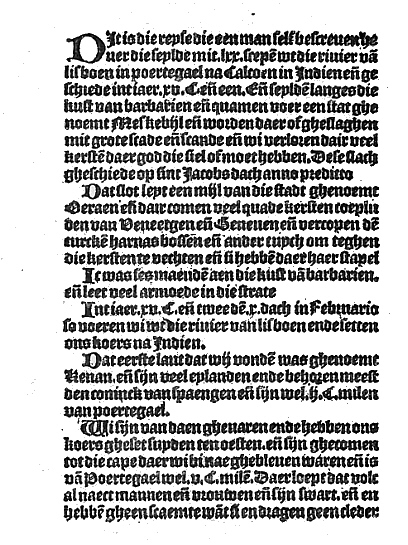
Abb.: Calcoen. -- Antwerpen, ca. 1504, 1. Seite [ein niederländischer Bericht
über Vasco da Gamas zweite Fahrt nach Indien]
[Bildquelle: Calcoen : a Dutch narrative of the second voyage of Vasco da Gama to Calicut, printed at Antwerp circa 1504 / with introduction and translation by J. Ph. Berjeau [1809 - 1891]. -- London : Pickering, 1874. -- Enthält das flämische Original in Faksimile. -- Online: http://www.archive.org/details/calcoendutchnarr00berjuoft. -- Zugriff am 2008-06-08]
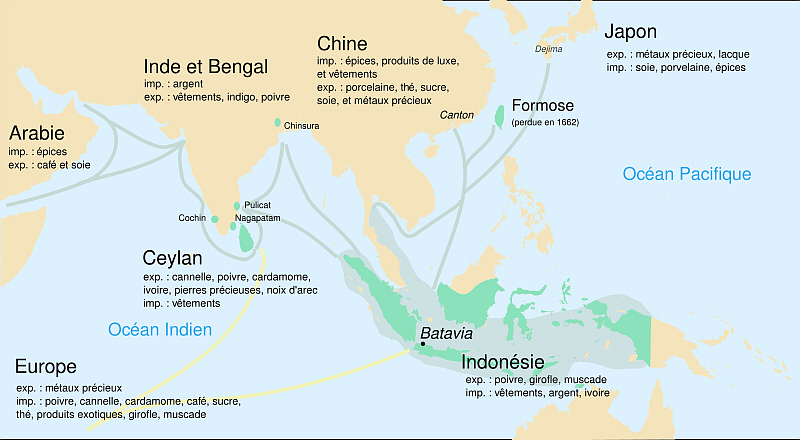
Abb.: Stützpunkte der Niederländer in Indien
[Bildquelle: Aliesin, Wikipedia, Creative Commons Lizenz:
Attribution ShareAlike 2.5]
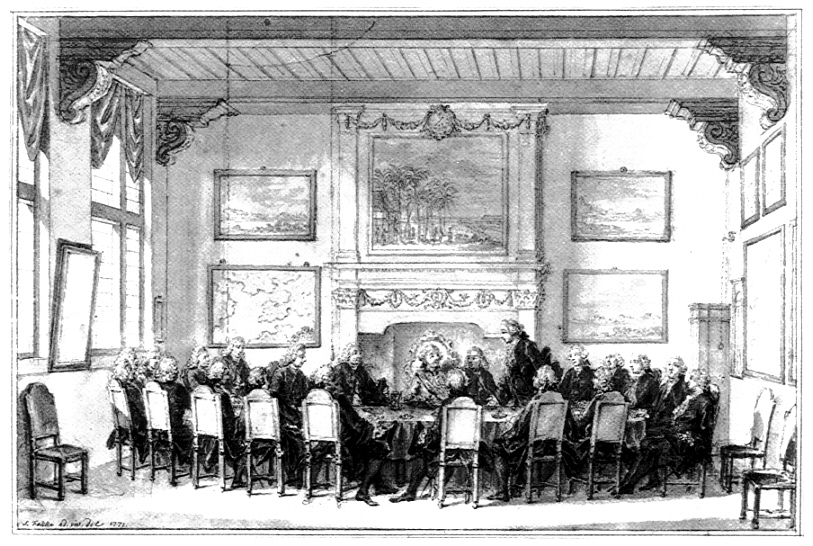
Abb.: Sitzung im Ostindienhaus, Amsterdam / von Simon Fokke, 1771
[Bildquelle: Gelder, Roelof van: Das ostindische Abenteuer : Deutsche in Diensten der Vereinigten Ostindischen Kompanie der Niederlande (VOC), 1600 - 1800. -- Hamburg : Convent, 2004. -- 271 S. : Ill. ; 27 cm. -- (Schriften des Deutschen Schiffahrtsmuseums ; Bd. 61). -- Originaltitel: Het Oost-Indisch avontuur : Duitsers in dienst van de VOC (1997). -- Zugleich. Amsterdam, Univ., Diss., 1997. -- ISBN 3-934613-57-8. -- S. 27]
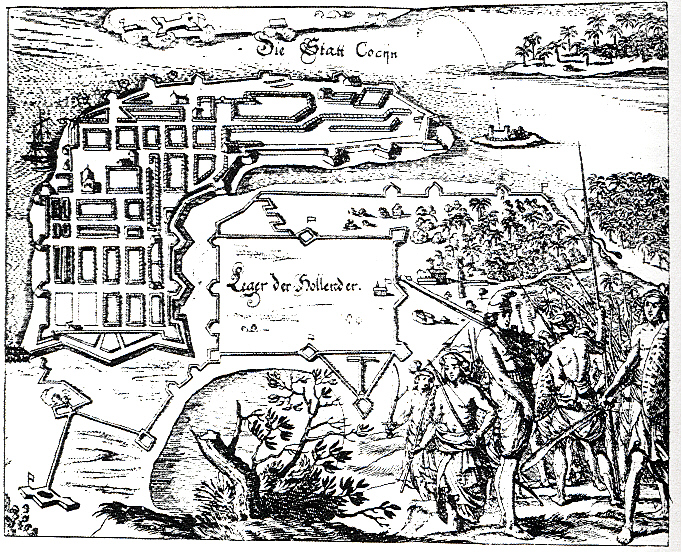
Abb.: "Leger der Hollender", Cochin, 1669
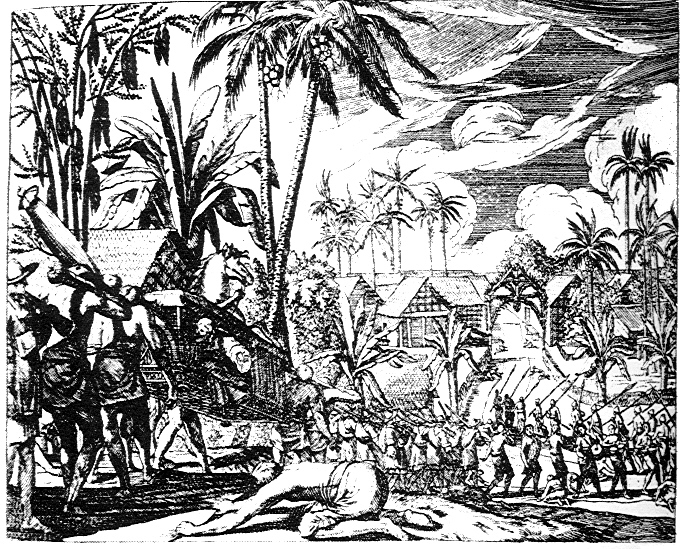
Abb.: Singhalesen auf Ceylon (Sri Lanka) huldigen dem holländischen
Befehlshaber, 1669
"DUTCH EAST INDIA COMPANY, THE (Oostindische Vereenigde Maatschappij), a body founded by a charter from the Netherlands states-general on the 20th of March 1602. It had a double purpose: first to regulate and protect the already considerable trade carried on by the Dutch in the Indian Ocean, and then to help in prosecuting the long war of independence against Spain and Portugal. Before the union between Portugal and Spain in 1580-81, the Dutch had been the chief carriers of eastern produce from Lisbon to northern Europe. When they were shut out from the Portuguese trade by the Spanish king they were driven to sail to the East in order to make good their loss. Unsuccessful attempts were made to find a route to the East by the north of Europe and Asia, which would have been free from interference from the Spaniards and Portuguese. It was only when these failed that the Dutch decided to intrude on the already well-known route by the Cape of Good Hope, and to fight their way to the Spice Islands of the Malay Archipelago. A first expedition, commanded by Cornelius Houtman, a merchant long resident at Lisbon, sailed on the and of April 1595. It was provided with an itinerary or book of sailing instructions drawn up by Jan Huyghen van Linschoten,1 a Dutchman who had visited Goa. The voyage was marked by many disasters and losses, but the survivors who reached the Texel on their return on the 20th of August 1597 brought back some valuable cargo, and a treaty made with the sultan of Bantam in Java. 1 Linschoten was born at Haarlem in or about 1563. He started his travels at the age of sixteen and, after some years in Spain, went with the Portuguese East India fleet to Goa, where he arrived in September 1583, returning in 1589. In 1594 and 1595 he took part in the Dutch Arctic voyages, and in 1598 settled at Enkhuizen, where he died on the 8th of February 1611. His Navigatio ac itinerarium (1595-1596) is a compilation based partly on his own experiences, partly on those of other travellers with whom he came in contact. It was translated into English and German in 1598; two Latin versions appeared in 1599 and a French translation in 1610. The famous English version was reprinted for the Hakluyt Society in 1885. Large selections, with an Introduction, are published in C. Raymond Beazley's Voyages and Travels, vol. ii. (English Garner, London, 1903).
These results were sufficient to encourage a great outburst of commercial adventure. Companies described as "Van Ferne" that is, of the distant seas were formed, and by 1602 from sixty to seventy Dutch vessels had sailed to Hindustan and the Indian Archipelago. On those distant seas the traders could neither be controlled nor protected by their native government. They fought among themselves as well as with the natives and the Portuguese, and their competition sent up prices in the eastern markets and brought them down at home. Largely at the suggestion of Jan van Oldenbarneveldt, and in full accordance with the economic principles of the time, the states-general decided to combine the existing separate companies into one united Dutch East India Company, which could discharge the functions of a government in those remote seas, prosecute the war with Spain and Portugal, and regulate the trade. A capital estimated variously at a little above and a little under 6,500,000 florins, was raised by national subscription in shares of 3000 florins. The independence of the states which constituted the United Netherlands was recognized by the creation of local boards at Amsterdam, in Zealand, at Delft and Rotterdam, Hoorn and Enkhuizen. The boards directed the trade of their own districts, and were responsible to one another, but not for one another as towards the public. A general directorate of 60 members was chosen by the local boards. Amsterdam was represented by 20 directors, Zealand by 12, Delft and Rotterdam by 14, and Hoorn and Enkhuizen also by 14. The real governing authority was the "Collegium," or board of control of 17 members, of whom 16 were chosen from the general directorate in proportion to the share which each local branch had contributed to the capital or joint stock. Amsterdam, which subscribed a half, had eight representatives; Zealand, which found a quarter, had four; Delft and Rotterdam, Hoorn and Enkhuizen had two respectively, since each of the pairs had subscribed an eighth. The seventeenth member was nominated in succession by the other members of the United Netherlands. A committee of ten was established at the Hague to transact the business of the company with the states-general. The "collegium" of seventeen nominated the governors-general who were appointed after 1608. The charter, which was granted for twenty-one years, conferred great powers on the company. It was endowed with a monopoly of the trade with the East Indies, was allowed to import free from all custom dues, though required to pay 3% on exports, and charged with a rent to the states. It was authorized to maintain armed forces by sea and land, to erect forts and plant colonies, to make war or peace, to arrange treaties in the name of the stadtholder, since eastern potentates could not be expected to understand what was meant by the states-general, and to coin money. It had full administrative, judicial and legislative authority over the whole of the sphere of operations, which extended from the west of the Straits of Magellan westward to the Cape of Good Hope.
The history of the Dutch East India Company from its formation in 1602 until its dissolution in 1798 is filled, until the close of the i7th century, with wars and diplomatic relations. Its headquarters were early fixed at Batavia in Java. But it extended its operations far and wide. It had to deal diplomatically with China and Japan; to conquer its footing in the Malay Archipelago and in Ceylon; to engage in rivalry with Portuguese and English; to establish posts and factories at the Cape, in the Persian Gulf, on the coasts of Malabar and Coromandel and in Bengal. Only the main dates of its progress can be mentioned here. By 1619 it had founded its capital in Batavia in Java on the ruins of the native town of Jacatra. It expelled the Portuguese from Ceylon between 1638 and 1658, and from Malacca in 1641. Its establishment at the Cape of Good Hope, which was its only colony in the strict sense, began in 1652. A treaty with the native princes established its power in Sumatra in 1667. The flourishing age of the company dates from 1605 and lasted till the closing years of the century. When at the summit of its prosperity in 1669 it possessed 150 trading ships, 40 ships of war, 10,000 soldiers, and paid a dividend of 40%. In the last years of the 17th century its fortunes began to decline. Its decadence was due to a variety of causes. The rigid monopoly it enforced wherever it had the power provoked the anger of rivals. When Pieter Both, the first governor-general, was sent out in 1608, his instructions from the Board of Control were to see that Holland had the entire monopoly of the trade with the East Indies, and that no other nation had any share whatever. The pursuit of this policy led the company into violent hostility with the English, who were also opening a trade with the East. Between 1613 and 1632 the Dutch drove the English from the Spice Islands and the Malay Archipelago almost entirely. The English were reduced to a precarious footing at Bantam in Java. One incident of this conflict, the torture and judicial murder of the English factors at Amboyna in 1623, caused bitter hostility in England. The success of the company in the Malay Archipelago was counterbalanced by losses elsewhere. It had in all eight governments: Amboyna, Banda, Ternate, Macassar, Malacca, Ceylon, Cape of Good Hope and Java. Commissioners were placed in charge of its factories or trading posts in Bengal, on the Coromandel coast, at Surat, and at Gambroon (or Bunder Abbas) in the Persian Gulf, and in Siam. Its trade was divided into the "grand trade" between Europe and the East, which was conducted in convoys sailing from and returning to Amsterdam; and the "Indies to Indies" or coasting trade between its possessions and native ports.
The rivalry and the hostilities of French and English gradually drove the Dutch from the mainland of Asia and from Ceylon. The company suffered severely in the War of American Independence. But it extended and strengthened its hold on the great islands of the Malay Archipelago. The increase of its political and military burdens destroyed its profits. In the early 18th century it was already embarrassed, and was bankrupt when it was dissolved in 1798, though its credit remained unshaken, largely, if its enemies are to be believed, because it concealed the truth and published false accounts. In the later stages of its history its revenue was no longer derived from trade, [S. 717] but from forced contributions levied on its subjects. At home, the directors, who were accused of nepotism and corruption, became unpopular at an early date. The company was subject to increasing demands and ever more severe regulation on the successive renewals of its charters at intervals of twenty-one years. The immediate causes of its destruction were the conquest of Holland by the French revolutionary armies, the fall of the government of the stadtholder, and the establishment of the Batavian Republic in 1798.
AUTHORITIES. The great original work on the history of the Dutch East India Company is the monumental Beschryving van oud en niew cost Indien (Dordrecht and Amsterdam, 1724), by Francois Valentyn, in 8 vols., folio, profusely illustrated. Two modern works of the highest value are: J. K. J. de Jonge, De Opkomst van het Nederlandsch Gezag in oost Indien (The Hague and Amsterdam, 1862-1888), in 13 vols. ; J. J. Meinsma, Geschiedenis van de Nederlandsche oost-Indische Bezittingen (3 vols., Delft and the Hague, 1872 - 1875). See also John Crawford, History of the Indian Archipelago (Edinburgh, 1820); Clive Day, The Dutch in Java (New York, 1904) ; Sir W. W. Hunter, A History of British India (London, 1899) ; and Pierre Bonnassieux, Les Grandes Compagnies de commerce (Paris, 1892)."
[Quelle: Encyclopaedia Britannica. -- 11. ed. -- 1910. -- Bd. 8. -- S. 716f.]
"Gründung und Organisation der Niederländisch-Ostindischen Gesellschaft Die Gründung und erste Organisation der Kompanie erfolgte durch die am 20. März 1602 von den Generalstaaten ihr erteilte Oktroi, wodurch sie auf 21 Jahre als merkantilistischer und politischer Körper privilegiert wurde. Schon durch diesen ersten Freibrief ward die Kompanie in vier Kammern geteilt, nämlich die von Amsterdam, von Zeeland, auf der Maas und von Nordholland und Westfriesland, von denen die Kammer auf der Maas wiederum die Kammern von Delft und Rotterdam, die Kammer von Nordholland aber die Kammern von Hoorn und Enkhuizen einbegriff. Der Anteil, welchen diese verschiedenen Kammern an der Kompanie haben sollten, ward so verteilt, dass die Kammer von Amsterdam die Hälfte, die von Zeeland ein Viertel und die beiden übrigen jede ein Achtel, also jede der vier Kammern, worin sich die beiden Kammern auf der Maas und von Nordholland teilten, ein Sechzehntel besitzen sollten. Die Angelegenheiten einer jeden Kammer sollen durch ihre Vorsteher oder Bewindhebber besorgt werden, die aber in der Folge bis auf zwanzig von Amsterdam, zwölf von Zeeland, und in jeder der vier übrigen Kammern bis auf sieben reduziert werden sollen. Zur Besetzung einer vakanten Direktorenstelle schlagen die übrigen Direktoren der Kammer die Kandidaten vor, aus welchen die Staaten der Provinz, wo die Kammer sich findet, einen ernennen. Ein jeder Direktor muss wenigstens für 1000 Pfund Flämisch Anteil an der Kompanie haben, ausgenommen
in den Kammern von Enkhuizen und Hoorn, wo 500 Pfund zureichen. Jede dieser verschiedenen Kammern besorgt ihre Privatangelegenheiten, ihre besonderen Ausrüstungen, Käufe und Verkäufe.Zur Besorgung der allgemeinen Angelegenheiten der Kompanie werden aus diesen 60 Vorstehern der einzelnen Kammern 17 Direktoren oder Bewindhebber gewählt, und zwar acht aus der Kammer von Amsterdam, vier aus der von Zeeland oder Middelburg, und zwei aus jeder der beiden übrigen Hauptkammern; die 17. soll durch die Kammern von Zeeland, auf der Maas und von Nordholland der Reihe nach hinzugefügt werden. Die Versammlungen dieses engeren Ausschusses der Siebzehner sollen abwechselnd sechs Jahre zu Amsterdam und zwei Jahre zu Middelburg abgehalten werden. Durch denselben wird bestimmt, wann Ausrüstungen vorgenommen werden, wann Schiffe und wie viel abgeschickt werden sollen; auch werden von ihm andere, den Handel im allgemeinen betreffende Angelegenheiten besorgt, und seine Beschlüsse müssen von den Kammern unweigerlich befolgt werden. Können die 17 Direktoren in vereinzelten Fällen nicht einig werden oder hat sich der eine über den anderen zu beklagen, so gehört die Entscheidung vor die Generalstaaten, welche auch die vakanten Stellen in diesem engeren Ausschusse besetzen, indem sie von drei ihnen vorgeschlagenen Kandidaten aus der Kammer, in der die Stelle vakant ist, einen ernennen.
An der neu errichteten ostindischen Kompanie kann jeder Untertan der Republik Anteil nehmen; jeder Teilnehmer kann aber auch schon nach den ersten zehn Jahren, beim Abschluss der Generalrechnung, aus der Gesellschaft austreten. Wie großen Anteil ein jeder an der Kompanie nehmen will, bleibt seinem Ermessen überlassen; wird aber mehr Geld angeboten, als verlangt wird, so sollen diejenigen, welche über 3000 Gulden Anteil an der Kompanie haben, ihr Kapital verhältnismäßig verringern, um den neu Eintretenden Platz zu machen.
Die Schiffe der Kompanie sollen immer da einlaufen, von wo sie ausgelaufen sind. Hat die eine Kammer Spezereien oder andere indische Waren erhalten, die andere aber noch nicht, so soll jene angehalten sein, diese auf ihr Ansuchen nach den Umständen damit zu versorgen. Drei Monate nach Absendung der Schiffe soll jedes Mal eine Berechnung von der Ausrüstung derselben verfertigt und den verschiedenen Kammern mitgeteilt werden; alle zehn Jahre aber soll nach vorhergegangener Anzeige eine Generalrechnung abgelegt werden, jedoch außerdem auch jede Kammer gehalten sein, denjenigen Provinzen oder Städten, welche einen Anteil von 50000 Gulden und darüber an der Gesellschaft haben, nach Rückkehr der Schiffe von den mitgebrachten Waren und deren Verkauf auf Verlangen Bericht abzustatten; auch können eben diese Provinzen
und Städte einen Agenten zur Wahrnehmung ihrer Geschäfte bei d Kammern bestellen.Von der Beute, welche die Schiffe der Kompanie machen werden bekommt die Admiralität jedes Mal einen Anteil; die Schiffe aber die Munition und das Geschütz der Kompanie sollen nur mit ihrer Bewilligung zum Dienste des Landes gebraucht werden können.
Die Gewürze, chinesische Seide und Kattune, welche die Gesellschaft aus Indien erhält, sollen weder bei der Einfuhr noch bei der Ausfuhr mit höheren Abgaben belegt werden, als bisher üblich war; alle Spezereien der Kompanie sollen aber nach einerlei Gewicht, dem Amsterdamer verkauft, nach dem Verkaufe gewogen und das Waagegeld davon erhoben werden.
Über die Schulden der Kompanie dürfen die Direktoren weder in ihren Personen noch in ihren Gütern angegriffen werden. Alle Befehlshaber über Flotten und einzelne Schiffe sollen angehalten sein, bei ihrer Rückkehr in das Vaterland den Generalstaaten von ihrer Reise und von der Lage der Angelegenheiten in Indien Bericht abzustatten.
Für diese Oktroi bezahlt die Kompanie an die Generalstaaten die Summe von 25000 Pfund Flämisch, das Pfund zu 40 Groten Flämisch, welche die Generalstaaten zu Ausrüstungen während der ersten Jahre zu gleichem Gewinne und gleichem Verluste mit den übrigen Interessenten einlegen.
So war die Organisation der Kompanie bei ihrer Errichtung beschaffen, und wenn gleich in der Folge in Nebenumständen verändert, blieb sie doch in der Hauptsache dieselbe. Die Oktroi der Kompanie ward von Zeit zu Zeit, so wie sie abgelaufen war, erneuert, bei welcher Gelegenheit nicht selten Veränderungen in der Organisation der Kompanie selbst vorgenommen wurden.
Aus: Saalfeld, F., Geschichte des holländischen Kolonialwesens in Ostindien, Bd. II (Göttingen 1813), S. 8-13.[Quelle: Saalfeld, Friedrich <1785 - 1834>: Geschichte des holländischen Kolonialwesens in Ostindien. -- Göttingen : Dieterich. -- Bd. 2. -- 1813. -- S. 8 - 13. -- Zitiert in: Die Entdeckung und Eroberung der Welt : Dokumente und Berichte / hrsg. von Urs Bitterli. -- München : Beck. -- (Beck'sche Sonderausgaben). -- Bd. 2. -- 1981. -- S. 90 - 92.]
Archivalien der Dutch East India Company (VOC) sind teils vernichtet worden, teils in einem schlechten Erhaltungszustand. Man findet sie zerstreut Archiven:
"A large portion of the voc 's archives have disappeared forever over the centuries as a result of bad circumstances for preservation (climate, mould, vermin), acts of war (the French occupation of the Netherlands, the annexation of voc establishments by England), or a simple lack of interest because the informative value of these archives was not recognized in the 19th century. For example, in 1821 10,000 volumes and in 1832 50,000 volumes of voc archival material were destroyed to save storage costs. What still remains of the voc archives (about four kilometres of paper) is currently kept in
- the National Archives of Indonesia (Jakarta),
- the Tamil Nadu Archives (Chennai, previously Madras, in India),
- the National Archives of Sri Lanka (Colombo),
- the Cape Town Archives Repository (South Africa), and
- the Dutch National Archives of the Netherlands (The Hague).
voc documents are also to be found in the United Kingdom
- in the India Office (London) and
- in the National Library of France (Paris, mainly maps and drawings).
But even the survival of the remaining archives is seriously threatened by a lack of resources for providing proper storage conditions, and by wear and tear resulting from the frequent consultation of the documents."
[Quelle: http://www.tanap.net/content/archives/preservation.cfm. -- Zugriff am 2008-05-26]
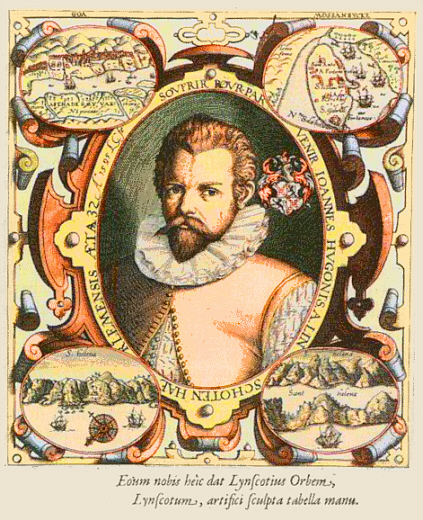
Abb.: Jan Huyghen van Linschoten (1563 - 1611)
[Bildquelle: Wikipedia, Public domain]
Übersetzung siehe:
Payer, Alois <1944 - >: Quellenkunde zur indischen Geschichte bis 1858. -- 15. Frühe europäische Quellen und Quellen aus der Zeit der East India Companies. -- 3. Zum Beispiel: Linschoten, Jan Huygen van <1563 - 1611>: Diary of occurrences in the Portuguese settlements in India, 1583-1588 A.D. -- Fassung vom 2008-05-22. -- http://www.payer.de/quellenkunde/quellen1503.htm
Gesamtübersetzung:
Linschoten, Jan Huygen van <1563 - 1611>: Iohn Huighen van Linschoten his Discours of voyages into ye Easte & West Indies : deuided into foure bookes. -- London : Wolfe, [1598]. -- Originaltitel: Itinerario, voyage ofte schipvaert van Jan Huygen van Linschoten naer Oost ofte Portugaels Indien. -- Online: http://lcweb2.loc.gov/service/rbc/rbc0001/2007/2007kis1964006000001/2007kis1964006000001.pdf. -- Zugriff am 2008-05-22
Abb.: Titelblatt
Abb.: Händler, Baniane, Bramene
[Bildquelle: a.a.O. , nach S. 78]
Abb.: Bauern und Krieger
[Bildquelle: a.a.O. , nach S. 78]
Abb.: Fischerboote
[Bildquelle: a.a.O. , nach S. 78]s
Abb.: Hochzeit in Ballagate, nördlich von Goa
[Bildquelle: a.a.O. , nach S. 78]
Abb.: Satī
[Bildquelle: a.a.O. , nach S. 78]
"Jan Huygen van Linschoten (* 1563 in Haarlem; † 8. Februar 1611 in Enkhuizen) war ein holländischer Kaufmann, Autor und Entdecker. Leben
Linschoten wurde in Haarlem geboren, lernte bei seinen Brüdern in Portugal und Spanien den Kaufmannsberuf. 1581 ging er als Sekretär des Erzbischofs von Goa nach Indien, wo er sechs Jahre verbrachte. Dort beschäftigte er sich auch mit dem Handel asiatischer Produkte und förderte ihn. Durch seine Position hatte Jan Huygen Zugang zu den geheimen Unterlagen einschließlich der Seekarten der Portugiesen, die diese über ein Jahrhundert geheimgehalten hatten. Er begann unter Bruch des in ihn gesetzten Vertrauens diese Unterlagen heimlich zu kopieren.
1587 mit dem Tod seines Gönners, des Erzbischofs von Goa, während dessen Reise nach Lissabon zum Rapport beim potugiesischen König endete das Abenteuer in Indien für Jan Huygens. Er fuhr mit dem Segler Richtung Lissabon im Januar 1589 und passierte im Mai 1589 den portugiesuschen Flottenstützpunkt mit Depot auf der Insel St. Helena.
Die Reise wurde unterbrochen durch einen Schiffbruch verursacht durch englische Piraten, so dass Jan zwei Jahre auf den Azoren verbrachte. Er landete 1592 in Lissabon und kehrte danach inseine Heimatstadt Enkhuizen zurück..
Mit Unterstützung des auf Schiffsthemen, Geographie und Reisen spezialisierten Amsterdamer Verlegers Cornelis Claesz, schrieb 1595 Jan das Buch Reys-gheschrift vande navigatien der Portugaloysers in Orienten (Reisebericht über die portugiesische Navigation im Orient). Das Werk beinhaltet eine Vielzahl von Segelrouten, nicht nur für die Strecken zwischen Portugal und Indien, sondern auch zwischen Indien, China und Japan.
Jan Huyghen schrieb auch zwei weitere Bücher, 1597 die Beschryvinghe van de gantsche custe van Guinea, Manicongo, Angola ende tegen over de Cabo de S. Augustijn in Brasilien, de eyghenschappen des gheheelen Oceanische Zees (Beschreibung der ganzen Küste von Guinea, Manicongo, Angola und zum Kap von St. Augustus in Brasilien.) und Itinerario: Voyage ofte schipvaert van Jan Huyghen van Linschoten naer Oost ofte Portugaels Indien, 1579-1592 [2] (Reisebericht über die Fahrt des Seemanns Jan Huyghen van Linschoten nach portugiesisch Indien 1596).
Eine englische Ausgabe des Itinerario erschien 1598 in London, ebenso wurde im selben Jahr eine deutsche Ausgabe herausgegeben.
Nach seiner Rückkehr nach Holland schrieb Linschoten zwei Bücher (veröffentlicht 1595-96), über die Route nach Ostindien sowie über die dortigen Produkte und Erzeugnisse, Diese Bücher regten die erste holländische Ostexpedition unter Cornelis de Houtman an.
1594 begleitete Linschoten Willem Barents in die Arktis und ging 1595 mit Barents abermals nach Nowaja Semlja. Grund dieser Expeditionen war es unter anderem, auf dem Landweg über den Norden eine neue Route nach China zu finden. Diese Reisen sollten jedoch die Norddurchfahrt nach Indien entdecken; eine Beschreibung erschien 1601.
Literatur
- Van Linschoten, Jan Huyghen. The Voyage of John Huyghen van Linschoten to the East Indies, Elibron Classics, 2001, 368 pages, ISBN 1-4021-9507-9, Replica of 1885 edition by the Hakluyt Society, London
- Van Linschoten, Jan Huyghen. Voyage to Goa and Back, 1583-1592, with His Account of the East Indies : From Linschoten's Discourse of Voyages, in 1598/Jan Huyghen Van Linschoten. Reprint. New Delhi, AES, 2004, xxiv, 126 p., $11. ISBN 81-206-1928-5.
[Quelle: http://de.wikipedia.org/wiki/Jan_Huygen_van_Linschoten. -- Zugriff am 2008-05-20]
Für Quellen zu Indien in britischer Zeit (Company und Raj) ist die Institution die Abteilung "India Office Records" der British Library in London:
Webpräsenz: http://www.bl.uk/collections/orientaloffice.html. -- Zugriff am 2008-05-19
Dort findet man:
Siehe:
Abb.: TitelblattMoir, Martin: A general guide to the India Office Records. -- London : British Library, 1988. -- xvi, 331 p. : ill. ; 25 cm. -- ISBN: 0712306293
Für die Zeit von 1583 - 1619 hat William Foster eine sehr nützliche Anthologie zusammengestellt:
Early travels in India 1583 - 1619 / ed. by William Foster [1863 - 1951]. -- London [u.a.] : Milford, Oxford university press, 1921. -- xiv, 351 S. : Ill. ; 19 cm. -- S. 125 - 187. -- Online: http://www.archive.org/details/earlytravelsinin00fostuoft. -- Zugriff am 2008-05-19. -- "Not in copyright."
Darin werden Berichte zitiert von:
| Name | Lebensdaten | Auf Indienreise |
|---|---|---|
| Ralph Fitch | 1583 - 1591 | |
| John Mildenhall | 1599 - 1606 | |
| William Hawkins | 1608 - 1613 | |
| William Finch | 1608 - 1611 | |
| Nicholas Withington | 1612 - 1613 | |
| Thomas Coryat | 1612 - 1617 | |
| Edward Terry | 1616 - 1619 |
William Foster hat auch die Berichte von Thomas Roe neu herausgegeben, der 1615 - 1619 als Botschafter von König James am Hof des Großmogul weilte:
Roe, Thomas <1581?-1644>: The embassy of Sir Thomas Roe to India, 1615-19, as narrated in his Journal and correspondence / edited by William Foster [1863 - 1951]. -- New and rev. ed. -- London, Oxford University Press, 1926. -- lxxix, 532 S. : Ill. ; 19 cm.
"FITCH, RALPH (fl. 1583-1606), London merchant, one of the earliest English travellers and traders in Mesopotamia, the Persian Gulf and Indian Ocean, India proper and Indo-China. In January 1583 he embarked in the "Tiger" for Tripoli and Aleppo in Syria (see Shakespeare, Macbeth, Act I. sc. 3), together with J. Newberie, J. Eldred and two other merchants or employees of the Levant Company. From Aleppo he reached the Euphrates, descended the river from Bir to Fallujah, crossed southern Mesopotamia to Bagdad, and dropped down the Tigris to Basra (May to July 1583). Here Eldred stayed behind to trade, while Fitch and the rest sailed down the Persian Gulf to Ormuz, where they were arrested as spies (at Venetian instigation, as they believed) and sent prisoners to the Portuguese viceroy at Goa (September to October). Through the sureties procured by two Jesuits (one being Thomas Stevens, formerly of New College, Oxford, the first Englishman known to have reached India by the Cape route in 1579) Fitch and his friends regained their liberty, and escaping from Goa (April 1584) travelled through the heart of India to the court of the Great Mogul Akbar, then probably at Agra. In September 1585 Newberie left on his return journey overland via Lahore (he disappeared, being presumably murdered, in the Punjab), while Fitch descended the Jumna and the Ganges, visiting Benares, Patna, Kuch Behar, Hugli, Chittagong, &c. (1585-1586), and pushed on by sea to Pegu and Burma. Here he visited the Rangoon region, ascended the Irawadi some distance, acquired a remarkable acquaintance with inland Pegu, and even penetrated to the Siamese Shan states (1586-1587). Early in 1588 he visited Malacca; in the autumn of this year he began his homeward travels, first to Bengal; then round the Indian coast, touching at Cochin and Goa, to Ormuz; next up the Persian Gulf to Basra and up the Tigris to Mosul (Nineveh); finally via Urfa, Bir on the Euphrates, Aleppo and Tripoli, to the Mediterranean. He reappeared in London on the 29th of April 1591. His experience was greatly valued by the founders of the East India Company, who specially consulted him on Indian affairs (e.g. 2nd of October 1600; 29th of January 1601; 31st of December 1606).
See Hakluyt, Principal Navigations (1599), voj. ii. part i. pp. 245-271, esp. 250-268; Linschoten, Voyages (Itineraris), part i. ch. xcii. (vol. ii. pp. 158-169, &c., Hakluyt Soc. edition) ; Stevens and Birdwood, Court Records of the East India Company 1599-1603 (1886), esp. pp. 26, 123; State Papers, East Indies, &c., 1513-1616 (1862), No. 36; Pinkerton, Voyages and Travels (1808-1814), ix. 406-425."
[Quelle: Encyclopaedia Britannica. -- 11. ed. -- Bd. 10. -- 1910. -- S. 439]
Text:
Early travels in India 1583 - 1619 / ed. by William Foster [1863 - 1951]. -- London [u.a.] : Milford, Oxford university press, 1921. -- xiv, 351 S. : Ill. ; 19 cm. -- S. 1 - 47. -- Online: http://www.archive.org/details/earlytravelsinin00fostuoft. -- Zugriff am 2008-05-19. -- "Not in copyright."
Auswahl siehe:
Payer, Alois <1944 - >: Quellenkunde zur indischen Geschichte bis 1858. -- 15. Frühe europäische Quellen und Quellen aus der Zeit der East India Companies. --4. Zum Beispiel: Ralph Fitch, 1583 - 1591. -- http://www.payer.de/quellenkunde/quellen1504.htm
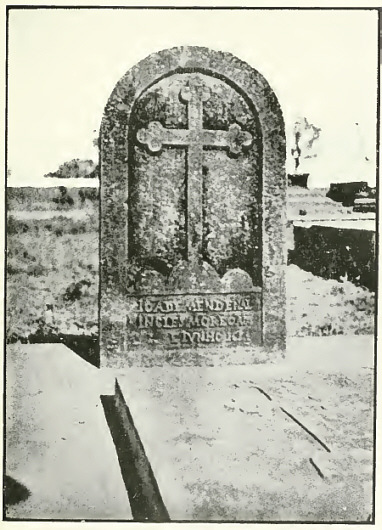
Abb.: John Mildenhall's Grabstein in Agra, Römisch-katholischer Friedhof
[Bildquelle: a.u.a.O., nach S. 50]
Text:
Early travels in India 1583 - 1619 / ed. by William Foster [1863 - 1951]. -- London [u.a.] : Milford, Oxford university press, 1921. -- xiv, 351 S. : Ill. ; 19 cm. -- S. 48 - . -- Online: http://www.archive.org/details/earlytravelsinin00fostuoft. -- Zugriff am 2008-05-19. -- "Not in copyright."
Auswahl siehe:
Payer, Alois <1944 - >: Quellenkunde zur indischen Geschichte bis 1858. -- 15. Frühe europäische Quellen und Quellen aus der Zeit der East India Companies. --5. Zum Beispiel: John Mildenhall, 1599 - 1606. --http://www.payer.de/quellenkunde/quellen1505.htm
Text:
Early travels in India 1583 - 1619 / ed. by William Foster [1863 - 1951]. -- London [u.a.] : Milford, Oxford university press, 1921. -- xiv, 351 S. : Ill. ; 19 cm. -- S. 60 - 121. -- Online: http://www.archive.org/details/earlytravelsinin00fostuoft. -- Zugriff am 2008-05-19. -- "Not in copyright."
Auswahl siehe:
Payer, Alois <1944 - >: Quellenkunde zur indischen Geschichte bis 1858. -- 15. Frühe europäische Quellen und Quellen aus der Zeit der East India Companies. --6. Zum Beispiel: William Hawkins, 1608 - 1613. -- http://www.payer.de/quellenkunde/quellen1506.htm
"FINCH, WILLIAM (d. 1613), merchant, was a native of London. He was agent to an expedition sent by the East India Company, under Captains Hawkins and Keeling, in 1607 to treat with the Great Mogul. Hawkins and Finch landed at Surat on 24 Aug. 1608. They were violently opposed by the Portuguese. Finch, however, obtained permission from the governor of Cambay to dispose of the goods in their vessels. Incited by the Portuguese, who seized two of the English ships, the natives refused to have dealings with the company's representatives. During these squabbles Finch fell ill, and Hawkins, proceeding to Agra alone, obtained favourable notice from the Emperor Jehanghire. Finch recovered, and joined Hawkins at Agra on 14 April 1610. The two remained at the mogul's court for about a year and a half, Finch refusing tempting offers to attach himself permanently to the service of Jehanghire. Hawkins returned to England, but Finch delayed his departure in order to make further explorations, visiting Byana and Lahore among other places. Finch made careful observations on the commerce and natural products of the districts visited. In 1612 the mogul emperor confirmed and extended the privileges he had promised to Finch and Hawkins, and the East India Company in that year set up their first little factory at Surat. Finch died at Babylon on his way to Aleppo from drinking poisoned water in August 1613." [Purchas ; Prévost's Histoire de Voyages ; Dow's Hist, of Hindostan ; Cal. State Papers, East Indies, 1513-1617, Nos. 449, 649, 650 ]
J. B-Y. [James Burnley]"
[Quelle: Dictionary of national biography / ed by Sidney Lee. -- London : Smith, Elder. -- Bd. 19. -- 1889. -- S. 20]
Text:
Early travels in India 1583 - 1619 / ed. by William Foster [1863 - 1951]. -- London [u.a.] : Milford, Oxford university press, 1921. -- xiv, 351 S. : Ill. ; 19 cm. -- S. 122 - 187. -- Online: http://www.archive.org/details/earlytravelsinin00fostuoft. -- Zugriff am 2008-05-19. -- "Not in copyright."
Ebenfalls:
Payer, Alois <1944 - >: Quellenkunde zur indischen Geschichte bis 1858. -- 15. Frühe europäische Quellen und Quellen aus der Zeit der East India Companies. --7. Zum Beispiel: William Finch, 1608 - 1611. -- http://www.payer.de/quellenkunde/quellen1507.htm
Text:
Early travels in India 1583 - 1619 / ed. by William Foster [1863 - 1951]. -- London [u.a.] : Milford, Oxford university press, 1921. -- xiv, 351 S. : Ill. ; 19 cm. -- S. 188 - 233. -- Online: http://www.archive.org/details/earlytravelsinin00fostuoft. -- Zugriff am 2008-05-19. -- "Not in copyright."
Auszug:
Payer, Alois <1944 - >: Quellenkunde zur indischen Geschichte bis 1858. -- 15. Frühe europäische Quellen und Quellen aus der Zeit der East India Companies. --8. Zum Beispiel: Nicholas Withington, 1612 - 1616. -- http://www.payer.de/quellenkunde/quellen1508.htm
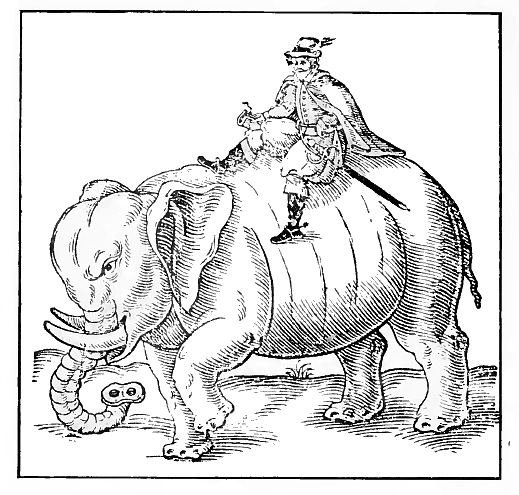
Abb.: Coryat auf einem Elefanten
[Bildquelle: a.u.a.O., nach S. 248]
"CORYATE, THOMAS (1577? -1617), traveller, son of the Rev. George Coryate [q. v.], rector of Odcombe, Somersetshire, by Gertrude his wife, was born in the parsonage house at Odcombe, about 1577, and entered J at Gloucester Hall in the university of Oxford in 1596. He left the university without taking a degree, and appears to have led an aimless life for a few years, till, on the accession of James I, he became a hanger-on of the court, picking up a precarious livelihood as a kind of privileged buffoon. Gifted with an extraordinary memory, and being no contemptible scholar, with what Fuller calls 'an admirable fluency in the Greek tongue,' and a certain sort of ability which occasionally showed itself in very pungent repartee, and an appearance which must have been indescribably comic, he soon attracted notice, 'indeed was the courtiers' anvil to try their wits upon; and sometimes this anvil returned the hammers as hard knocks as it received, his bluntness repaying their abusiveness. He carried folly,' says Fuller '(which the charitable called merriment), in his very face. The shape of his head had no promising form, being like a sugar-loaf inverted, with the little end before, as composed of fancy and memory, without any common sense.' When a separate establishment was set up for the household of Prince Henry and his sister, the Princess Elizabeth, Coryate obtained some post of small emolument which brought him into familiar relations with all the eminent men of the time, who appear to have amused themselves greatly at his expense. Prince Henry had a certain regard for him, and allowed him a pension. Always provided that they made it worth his while, Coryate had no objection even to the courtiers playing practical jokes upon him. On one occasion they shut him up in a trunk, and introduced him in a masque at court, much to the delight of the spectators (Nichols, Progresses of James I, ii. 400). The incident is alluded to by Ben Jonson and other writers of the time. It is probable that he inherited some little property on the death of his father, for within a year of that event he had determined to start on his travels. He sailed from Dover on 14 May 1608, and availing himself of the ordinary means of transit, sometimes going in a cart, sometimes in a boat, and sometimes on horseback,he passed through Paris, Lyons, and other French towns, crossed the Mont Cenis in a chaise à porteurs on 9 June, and, after visiting Turin, Milan, and Padua, arrived at Venice on the 24th. Here he stayed till 8 Aug., when he commenced his homeward journey on foot. He crossed the Splügen, passed through Coire, Zürich, and Basle, and thence sailed down the Rhine, stopping at Strasburg and other places, and reached London at last on 3 Oct., having travelled, according to his own reckoning, 1,975 miles, the greater part of which distance he had covered on foot, and having visited in the space of five months forty-five cities, whereof in France five, in Savoy one, in Italy thirteen, in Rhoetia one, in Helvetia three, in some parts of High Germany fifteen, in the Netherlands seven. Notwithstanding the novelty of this strange expedition and the very large amount of valuable information which he had gathered in his travels, Coryate found it hard to get a bookseller who would undertake the publication of his journal ; and as late as November 1610 it seemed doubtful whether it would be printed at all. But Coryate was not the man to be discouraged or to be easily turned from his purpose. He applied to every person of eminence whom he knew, and many whom he can scarcely have known at all, to write commendatory verses upon himself, his book, and his travels, and by his unwearied pertinacity and unblushing importunity contrived to get together the most extraordinary collection of testimonials which have ever been gathered in a single sheaf. More than sixty of the most brilliant and illustrious litterati of the time were among the contributors to this strange farrago, the wits vying with one another in their attempts to produce mock heroic verses, turning Coryate to solemn ridicule. Ben Jonson undertook to edit these amusing panegyrics, which actually fill 108 quarto pages. Prince Henry was applied to to further the printing of the book, and the volume was published in quarto by W. S[tansby?] in 1611. With the commendatory verses and the posthumous poems of the author's father, George Coryate, it contained nearly eight hundred pages. The title ran : 'Coryats Crudities. Hastily gobled up in Five Moneths Traveils in France, Savoy, Italy, Rhetia comonly called the Grisons country, Helvetia alias Switzerland, &c.,c.', together with 'a most elegant Oration, first written in the Latine tongue by H. Kircunerus . . . now distilled into English spirit through the Odcombian Limbecke ;' and 'Another, also composed by the Author of the former, in praise of travell in Germanie in particular.' It was illustrated by engravings on copper and steel, which have now become extraordinarily valuable. The folded frontispiece and the large and careful copperplate of Strasburg Cathedral are especially rare. The book seems to have had a large sale. In fact it was the first, and for long remained the only, handbook for continental travel ; and though the grotesque collection of commendatory verses went far to get for the work a character which it did not deserve of being only a piece of buffoonery from beginning to end, it is quite plain that there were those who soon got to see its value. Perhaps of no book in the English language of the same size and of the same age is it possible to say that there are not two perfect copies in existence. At the end of one of the British Museum copies is an autograph letter from Coryat to Sir Michael Hickes, dated 'from my chamber in Bowelane this 15th November 1610,' which was printed in Brydges's 'Censura Literaria.' Two appendices to the 'Crudities,' also issued in 1611, are equally rare. They are : 'Coryats Crambe, or his Colwort twise sodden and now served in with other Macaronicke dishes as the second course to his Crudities,' Lond. W. Stansby, 4to ; and 'The Odcombian Banquet, dished foorth by T. the Coriat and served in by a number of Noble Wits in prayse of his Crudities and Crambe too. Imprinted for T. Thorp,' Lond. 4to. In 1612 Coryate started again on his travels. Before doing so he repaired to his native place, and there delivered a valedictory oration at the market cross, announcing his intention of being absent for ten years, and formally hanging up in the church at Odcombe the shoes in which he had walked from Venice. These shoes had already become celebrated, and appear in a droll woodcut, in which they are drawn bound together by a laurel wreath. They serve as an illustration of some humorous verses by Henry Peacharn, author of the 'Complete Gentleman,' among the 'Panegyricke Verses' prefixed to the 'Crudities.' The shoes were still hanging up in Odcombe Church at the beginning of the eighteenth century. Coryate sailed first to Constantinople ; visited Greece and Asia Minor; got a passage from Smyrna to Alexandria ; went up the Nile as far as Cairo, returned to Alexandria; proceeded thence to the Holy Land, which he traversed from the Dead Sea to the Lebanon ; joined a caravan that was on its way to Mesopotamia ; stood upon the mounds of Nimroud ; thence made his way through Persia to Candahar ; managed to reach Lahore ; and arrived safely at Agra, where he was well received by the English merchants who had a 'factory' there. He reached Agra in October 1616. During the four years that he had been in the East, Coryate had learned Persian, Turkish, and Hindustani. On one occasion falling in with Sir Thomas Roe, who was the English ambassador at the court of the Great Mogul, Coryate obtained an audience of the mighty potentate, and delivered an oration in Persian. He sent home letters to his friends from time to time as opportunity occurred. One set of them was published in 1616, entitled 'Letters from Asmere, the Court of the Great Mogul, to several Persons of Quality in England,' in which, in a rather well drawn and well executed woodcut which serves as a frontispiece, he appears riding on an elephant. His last letter ('Mr. Thomas Coriat to his Friends in England sendeth greeting, from Agra . . . . the last of October 1616') was printed in 1618. There are some other pieces of his in 'Purchas his Pilgrimes,' published in 1625. He lived about a year after reaching Agra, but his constitution, naturally a very strong one, gave way under the hospitalities which were shown him when he came among his own countrymen once more in the Indian frontiers, and after receiving one or two serious warnings he died of 'a flux' at Surat in December 1617. A humble tumulus marking the place of his burial was shown half a century afterwards. It is described in Sir Thomas Herbert's 'Travels' (1634). The fame of Tom Coryate produced at least one imitator, even in his lifetime, in the person of William Lithgow [q.v.] Considering how faithful and instructive an account of the chief cities of Europe during the seventeenth century is to be found in his narrative, and how simple and lucid his style is when he is not intentionally fooling, it is strange that Coryate's 'Crudities' should not have been more continuously popular, and that the book should not have been reprinted in our own day.
[The fullest account of Coryate's life is to be found in Wood's Athenae Oxon. (Bliss), ii. 208. Fuller gives a notice of him in his Worthies of Somersetshire. See too Nichols's Progresses of James I, ii. 400 n, and the references there given. There is a pretty full list of his printed works in the Catalogue of English books printed before 1640 in the library of the British Museum, issued in 1884, and a careful description of the Crudities in W. C. Hazlitt's Handbook of Early English Literature, 1867. One copy of the Crudities now in the British Museum was a presentation copy from the author to Prince Henry. The copy in the Chetham Library is said to be the only perfect copy of the book in existence.]
A. J. [Augustus Jessopp]
[Quelle: Dictionary of national biography / ed. by Leslie Stephen. -- London : Smith, Elder. -- Bd. 12. -- 1887. -- S. 259ff.]
Text:
Early travels in India 1583 - 1619 / ed. by William Foster [1863 - 1951]. -- London [u.a.] : Milford, Oxford university press, 1921. -- xiv, 351 S. : Ill. ; 19 cm. -- S. 234 - 287. -- Online: http://www.archive.org/details/earlytravelsinin00fostuoft. -- Zugriff am 2008-05-19. -- "Not in copyright."
Auszug:
Payer, Alois <1944 - >: Quellenkunde zur indischen Geschichte bis 1858. -- 15. Frühe europäische Quellen und Quellen aus der Zeit der East India Companies. --9. Zum Beispiel: Thomas Coryat, 1612 - 1617. -- http://www.payer.de/quellenkunde/quellen1509.htm
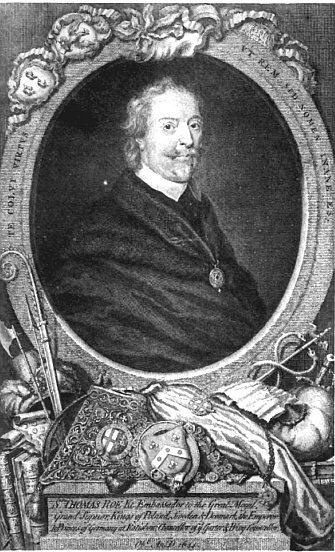
Abb.: Thomas Roe
[Bildquelle: Purchas His Pilgrims, Bd. 4, nach S. 320]
"Toward the end of this present yeere 1614, viz. in the beginning of January, His Majesty, at the request of the East India Company, sent Sir Thomas Roe, Knight, ambassadour to the Great Maghoore, whome some corruptly call Mogall . . . unto whome this ambassadour had commission to make and contract a league between His Majesty and his subjects for commerce and traffique in his dominions, and to procure and establish a factory for our nation in sundry parts of his dominions, as well seaports as inland townes, with other instructions yet undiscovered. Hee is the first that ever was imployed in this hie nature to any of those so farre remote easterne princes." (Stow's Annals, continued by Edmond Howes, 1615, p. 945.)
[Quelle: Roe, Thomas <1581?-1644>: The embassy of Sir Thomas Roe to India, 1615-19, as narrated in his Journal and correspondence / edited by William Foster [1863 - 1951]. -- New and rev. ed. -- London, Oxford University Press, 1926. -- lxxix, 532 S. : Ill. ; 19 cm. -- S. ]
Ausgabe:
Haklvytvs posthumus, or, Pvrchas his Pilgrimes : contayning a history of the world, in sea voyages, & lande-trauells / by Englishmen and others, wherein Gods wonders in nature & prouidence, the actes, arts, varieties & vanities of men, w[i]th a world of the worlds rarities are by a world of eyewitnesse-authors related to the world, some left written by Mr. Hakluyt at his death, more since added, his also perused, & perfected, all examined, abreuiated, illustrated w[i]th notes, enlarged w[i]th discourses, adorned w[i]th pictures, and expressed in mapps, in fower parts, each containing fiue bookes / [compiled] by Samvel Pvrchas, B.D. -- [London] : Imprinted at London for Henry Fetherston at y[e]e signe of the rose in Pauls Churchyard, 1625.. -- 4 Bde. ; 35 cm. -- Nachdruck in 20 Bänden. -- Glasgow : MacLehose, 1905 - 1907. -- Bd. 4 (des Nachdrucks). -- 1905. -- S. 310 - 468
Neuausgabe:
Roe, Thomas <1581?-1644>: The embassy of Sir Thomas Roe to India, 1615-19, as narrated in his Journal and correspondence / edited by William Foster [1863 - 1951]. -- New and rev. ed. -- London, Oxford University Press, 1926. -- lxxix, 532 S. : Ill. ; 19 cm.
Auszüge:
Payer, Alois <1944 - >: Quellenkunde zur indischen Geschichte bis 1858. -- 15. Frühe europäische Quellen und Quellen aus der Zeit der East India Companies. --10. Zum Beispiel: Thomas Roe, 1615 - 1619. -- Fassung vom 2008-06-04. -- http://www.payer.de/quellenkunde/quellen1510.htm
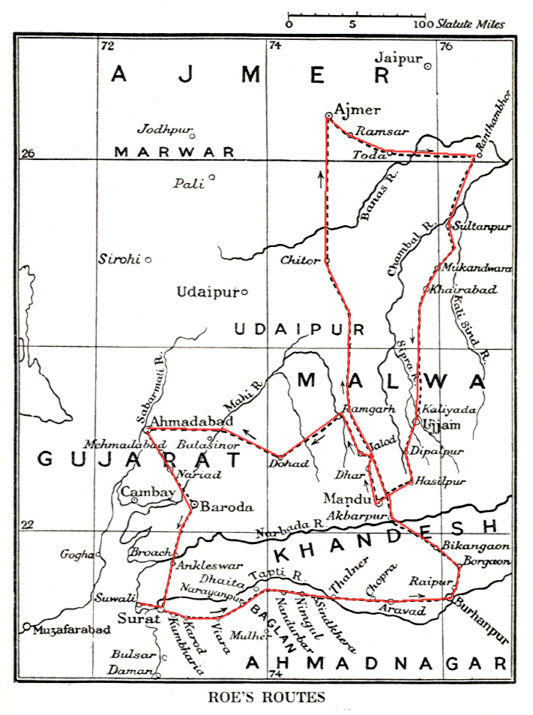
Abb.: Thomas Roe's Reisen in Indien
[Bildquelle: Roe, Thomas <1581?-1644>: The embassy of Sir Thomas Roe to India, 1615-19, as narrated in his Journal and correspondence / edited by William Foster [1863 - 1951]. -- New and rev. ed. -- London, Oxford University Press, 1926. -- lxxix, 532 S. : Ill. ; 19 cm. -- Nach S. 66]
Über Thomas Roe
ROE, SIR THOMAS (1581? -1644), ambassador, son of Robert Rowe, was born at Low Leyton, near Wanstead in Essex, in 1580 or 1581. His grandfather, Sir Thomas Rowe or Roe, merchant tailor, was alderman, sheriff (1560), and lord mayor of London (1568); Mary, daughter of Sir John Gresham, was Sir Thomas's wife Robert, the father of the ambassador, died while his son was a child (WOOD, Athena, ed. Bliss, iii. 111). His mother, Elinor, daughter of Robert Jermy of Worstead, Norfolk (Philpot pedigree in College of Arms), subsequently married 'one Berkeley of Rendcomb in Gloucestershire, of the family of the Lord Berkeley.'
Thomas matriculated as a commoner of Magdalen College, Oxford, on 6 July 1593, at the age of twelve. He had clearly powerful family influence, whether from the Berkeleys, the family of his stepfather, or from his father's wealthy relations. After spending some time 'in one of the inns of court or in France or both' (Wood), he was appointed esquire of the body to Queen Elizabeth in the last years of her reign, and after her death was knighted by James I on 23 March 1604-5. He was popular at court, especially with Henry, prince of Wales, and his sister Elizabeth, afterwards queen of Bohemia : and the former gave him his first opportunity of distant travel by sending him 'upon a discovery to the West Indies.' Roe equipped a ship and pinnace, and sailed from Plymouth on 24 Feb. 1609-10. Striking the mouth of the Amazon, then unknown to English explorers, he sailed two hundred miles up the river, and rowed in boats one hundred miles further, making many excursions into the country from the banks ; then returning to the mouth, he explored the coast and entered various rivers in canoes, passing over' thirty-two falles in the river of Wia Poko' or Oyapok. Having examined the coast from the Amazon to the Orinoco for thirteen months, without discovering the gold in which the West Indies were believed to abound, he returned home by way of Trinidad, and reached the Isle of Wight in July 1611. Twice again was he sent to the same coast, 'to make farther discoveries, and maintained twenty men in the River of Amozones, for the good of his countrey, who are yet [1614] remaining there, and supplied' (Snow, Annales, continued by Howes, 1631, p. 1022). At the close of 1613 he was at Flushing 'going for Captaine Floods companye,' who was just dead (COLLINS, Letters and Memorials of State of the Sydney Family, ii. 329). While in the Netherlands he entered in July 1613 into some theological disputations with Dr. T. Wright at Spa, and these were published by the latter in 1614 at Mechlin, under the title of 'Quatuor Colloquia.'
In 1614, after being elected M.P. for Tarnworth, Roe was commanded by James I to proceed, at the request and at the expense of the East India Company, as lord ambassador to the court of Jehangir, the Mogul emperor of Hindustan (Cal. State Papers, Dom. 24 Nov. 1614). His instructions were to arrange a commercial treaty and obtain concessions for 'factories' for the English merchants in continuation of the privileges obtained by Captain William Hawkins [q.v.] in 1609-12 (PURCHAS, 1625, i. 544 ; STOW, Annales). The expedition consisted of four ships under the command of Captain William Keeling [q. v.] Roe embarked in March 1614-15, and, sailing round the Cape of Good Hope, landed at Surat on 26 Sept. Thence he travelled by way of Burhanpur and Mandu to Ajmir, where the Emperor Jehangir resided. He had his first audience of the emperor on 10 Jan. 1615-16. He remained in close attendance at the court, following Jehangir in his progress to Ujain and Ahmadabad, until January 1617-18, when he took his leave, having accomplished the objects of his mission as far as seemed possible. He obtained the redress of previous wrongs, and an imperial engagement for future immunities, which placed the establishment at Surat in an efficient position for trade, and laid the foundations of the future greatness of Bombay, and. indeed, of British India in general. The patience and self-restraint exercised by Roe under exceptional provocation are admirably displayed in the pages of his entertaining 'Journal,' which gives an inimitable picture of the Indian court.
On his way home Roe went to Persia, to settle matters in respect of the trade in silks (Cal. State Papers, Dom. 7 Jan. 1619), and was reported on 11 Sept. 1619 as 'returned [to London] rich from India,' though it appears the wealth consisted chiefly in presents for King James, and that the ambassador had 'little for himself.'
Roe was elected, in January 1620-1, one of the burgesses for Cirencester, doubtless by the Berkeley interest. But his parliamentary career was quickly interrupted by a new foreign mission. He was sent in September 1621 as ambassador to the Ottoman Porte. In passing through the Mediterranean he received ample evidence of the depredations of the Barbary pirates, and resolved to make it his business to try to suppress them. He arrived at Constantinople on 28 Dec. 1621, displacing Sir John Eyre. Roe's audience of Sultan Osman II took place about the end of February 1621-2, and was of course purely formal. 'I spake to a dumb image,' he reports (Negotiations, p. 37). He was under no illusions as to the strength, or the dignity of the Turkish empire. He described it as 'irrecoverably sick' (ib. p. 126), and compared it (almost in the words of the Emperor Nicholas 230 years later) to ' an old body, crazed through many vices, which remain, when the youth and strength is decayed' (ib. p. 22). He remained at the Porte till the summer of 1628, his term of appointment having been specially extended at the urgent prayer of the well-satisfied Levant merchants to Buckingham, in spite of Roe's repeated requests for recall (Cal. State Papers, Dom. 8 March 1625).
At Constantinople Roe succeeded in enlarging the privileges of English merchants, and the secretary of state, Sir George Calvert [q.v.], wrote that he had 'restored the honour of our king and nation' (Negotiations, p. 60). He also mediated a treaty of peace between Turkey and Poland (ib. pp. 129, 133), and liberated many Polish exiles at Constantinople (Cal. State Papers, Dom. 20 May 1623), services for which he received the thanks of King Sigismund in September 1622 (T. SMITH, Account of the Greek Church, 1680, p. 252 ; WOOD, l.c.) The suppression of the Algerine piracy in the Mediterranean proved beyond the power of mere diplomacy ; but Roe's negotiations put England's relations with Algiers on a better footing, and he arranged for the freeing of English captives, partly at his own cost (Negotiations, pp. 14, 117, 140). By his efforts a treaty with Algiers was patched up in November 1624 (ib. p. 146) ; and though it was not wholly approved in England, it led to the liberation, of seven to eight hundred English captive mariners (Cal. State Papers, Dom. 1623). Roe, however, met with doubtful success in his zealous efforts to attach Bethlen Gabor, the prince of Transylvania, to the protestant alliance, and to use him as an instrument for the support of Count Mansfeld and the restoration of the palatinate. Gabor's attitude perplexed the ambassador, and James I's hesitation and lack of money for subsidies impeded the negotiation. But eventually Roe procured the promise of a monthly subsidy from England, and the Porte's support for the prince. The Porte consented to the reversion of the principality of Transylvania to Gabor's wife, a princess of Brandenburg, who was duly invested with the banner and sceptre by a Turkish ambassador (ib. p. 558 ; von HAMMER, Gesch. d. osm. Reiches, iii. 73-5). Gabor accordingly allied himself to Mansfeld and the protestant union in October 1626 (Negotiations, p. 571); but a victory over the imperialists was neutralised by a truce and Mansfeld's subsequent death (ib. pp. 579-593). Suspicion was aroused by the conduct of Bethlen, who complained that the promised subsidy of ten thousand dollars a month from England had not been paid (ib. p. 595). Nevertheless Roe succeeded in keeping Gabor more or less on the side of the German protestants, and also managed in their interest to quash the proposal for a treaty between Spain and the Porte (ib. p. 452). At the same time he was a warm friend of the Greek church in Turkey, and on intimate terms with its celebrated patriarch, Cyril Lucaris. Cyril presented through Roe to James I the celebrated 'Codex Alexandrinus' of the whole Bible, which the patriarch brought from his former see of Alexandria ; it was transferred with the rest of the royal library to the British Museum in 1757 (cf. Negotiations, p. 618). Roe was himself a collector of Greek manuscripts. Twenty-nine Greek and other manuscripts, including an original copy of the synodal epistles of the council of Basle, which he brought home, he presented in 1628 to the Bodleian Library (MACRAY, Annals of the Bodleian, 2nd ed., pp. 70, 72). A collection made by him of 242 coins was given by his widow, at his desire, to the Bodleian after his death. He also searched for Greek 'marbles' in behalf of the Duke of Buckingham and the second Earl of Arundel.
'Naked I came in, and naked I goe out,' he wrote on 6 April 1628, on finally leaving his embassy at Constantinople (ib. p. 810). June found him at Smyrna, whence he sailed to Leghorn, and on the way fought an engagement with Maltese galleys, during which he was struck down by a spar which had fortunately checked a ball (ib. pp. 826-7). Travelling across the continent, Roe visited Princess Elizabeth, the electress-palatine and queen of Bohemia, at Rhenen, and, in compliance with her wish, adopted the two daughters of Baron Rupa, an impoverished adherent of the elector (GREEN, Princesses of England, vi. 471). Reaching the Hague in December 1628, he presented to the Prince of Orange a memorial in which he urged that Bethlen Gabor should again be subsidised, and that Gustavus Adolphus should march into Silesia, where Bethlen would join him ( Camden Society Miscellany, vol. vii. ; Letters of Sir T. Roe, ed. S. R. Gardiner, pp. 2-4). He left the Hague at the end of February for England, and in May 1629 he submitted another memorial to the same effect to Charles I, and in the result was despatched in June on a mission to mediate a peace between the kings of Sweden and Poland (Instructions, printed ib. pp. 10-21). He visited the Swedish camp near Marienburg, and then the Polish camp, brought about a meeting of commissioners in September 1629, and succeeded in arranging a truce for six years (ib. p. 39). He was in close personal relations with Gustavus Adolphus, whose generous character strongly impressed him, while the Swedish king admitted that he owed chiefly to Roe the suggestion, which he put into effect in June 1630, of carrying the war into Germany and placing himself at the head of the protestant alliance. He called Roe his 'strenuum consultorem,' and sent him a present of 2,000/. on his victory at Leipzig (HowELL, Familiar Letters, 1754, p. 228). After arranging the truce between Poland and Sweden, Roe drew up a treaty at Danzig settling the claims of that city with which he had been instructed to deal, and, breaking his homeward journey at Copenhagen, he concluded a treaty with Denmark which in other hands had been languishing for years.
In the summer of 1630 Roe returned to England from this successful mission. The king had a gold medal struck in his honour, bearing the shields of Sweden and Poland and the date 1630, and on the reverse the crown of England supported by two angels, and beneath a monogram of Roe's initials (Cal. State Papers, Dom. 1630-1, p. 466). This medal Dame Eleanor Roe presented to the Bodleian Library in 1668 (MACKAY, Annals, 2nd edit. p. 134). But beyond this barren honour the ambassador received no rewards. For six years he lived in retirement, suffering from limited means; his wife's purchased pension was in arrears ; even payment was long withheld from him on account of the diamonds which he bought for the king at Constantinople, and the pleasures of a country life ill requited him for the lack of state employment. He 'bought a cell' for his old age at Stanford, and afterwards moved to Bulwick and then to Cranford (Cal. State Papers, Dom. 1629-31, pp. 344, &c.). At last, in January 1636-7, he was appointed chancellor of the order of the Garter, to which a year later a pension of 1,200/. a year was added (ib. 1637-8, p. 214). Meanwhile he was in constant correspondence with the queen of Bohemia, who addressed him as 'Honest Tom,' and who depended on his influence to counteract the indiscretions of her London agent, Sir Francis Nethersole [q. v.] (GREEN, Princesses, vi. 556-66).
In 1638 he was once more sent abroad as ambassador extraordinary to attend the congress of the imperial, French, and Swedish plenipotentiaries for the settlement of the terms of a general peace, which sat successively at Hamburg, Ratisbon, and Vienna (Negotiations, p. 13 ; Letters and Memorials of Sidney Family, ii. pref., 564,570; Cal. State Papers, Dom. 1638-43, passim ; Brit. Mus. Addit. MS. 21993, f. 294). The plenipotentiaries did their utmost to exclude him, but Roe contrived to join the conferences and to make his influence felt towards the restoration of the palatinate. Roe's ability profoundly impressed the emperor, who is reported to have exclaimed, 'I have met with many gallant persons of many nations, but I scarce ever met with an ambassador till now ' (WOOD, Athenae, loc. cit. ; DE WICQUEFORT, L'Ambassadeur, 1682, p. 105). These negotiations and a further treaty with Denmark occupied most of his energies till September 1642 (Cal. State Papers, Dom. 1639, pp. 143, 206; Brit. Mus. Addit. MS. 28937, f. 25), but he was at intervals in London, where he busied himself with parliamentary work. He was sworn a member of the privy council in June 1640 (Cal. State Papers, Dom. 1640, p. 447), and was returned on 17 Oct. 1640 as one of the burgesses for the university of Oxford. His wide experience, sober learning, and dignified eloquence had their weight in the House of Commons. Some of his speeches, chiefly on commercial and currency questions (e.g. on brass money, 1640, on Lord-keeper Finch, 1640, on the decay of coin and trade, 1641), were printed, and on 13 Nov. 1640 he presented to the house a report on the negotiations connected with the Scottish treaty at Ripon (NALSON, Collect, ii. 524). In the following summer he asked and obtained the leave of the house to retain his seat during his absence at the diet of Ratisbon (ib. p. 804). In July 1642, when ambassador-extraordinary at Vienna, he wrote a letter to Edmund Waller, which was read to the House of Commons, repudiating the rumour that he had offered an offensive and defensive alliance to the king of Hungary without his own sovereign's permission (Letter to Waller, Brit. Mus., 1642). On 2 July 1643 Roe obtained permission of the commons to retire to Bath in the hope of improving his health. He died on 6 Nov. 1644 in the words of Dr. Gerard Langbaine's proposed epitaph, 'praereptus opportune, ne funestam regni catastrophen spectaret' and was buried two days later in the chancel of Woodford church, Essex (WOOD, Athenae) : the manor of Woodford had been conveyed to him in 1640 (J. KENNEDY, Hist. ofLeyton, p. 357).
Roe's solid judgment, penetration, and sagacity are sufficiently proved by his published journal and despatches ; in knowledge of foreign affairs and in a practical acquaintance with the details of British commerce he probably had no living equal ; he was not afraid of responsibility ; while of the charm of his manner and conversation it is enough to quote the emperor's remark, that 'if Roe had been one of the fair sex, and a beauty, he was sure the engaging conversation of the English ambassador would have proved too hard for his virtue' (COLLINS, Letters and Memorials of State of the Sydney Family, ii. 541 n. ; Cal. State Papers, Dom. 1641-3, p. 131). In his personal character he was devout and regular ; he always gave a tenth of his income to the poor ; he was an earnest supporter of the protestant principle, and devoted to his king, though lightly rewarded. 'Those who knew him well have said that there was nothing wanting in him towards the accomplishment of a scholar, gentleman, or courtier ; that also as he was learned, so was he a great encourager and promoter of learning and learned men. His spirit was generous and public, and his heart faithful to his prince' (WOOD, Athenae, iii. 113). He married, before 1614, Eleanor, daughter of Sir Thomas Cave of Stamford, Northamptonshire (Philpot pedigree, College of Arms), and niece of Lord Grandison (Cal. State Papers, Dom. 1626, p. 475). She accompanied her husband in 1621 on his embassy to the Ottoman Porte, and showed great courage during the engagement with Maltese galleys on the way home.
Roe's diplomatic memoirs and voluminous and interesting correspondence have only been in part published or preserved. Part of the 'Journal' of his mission to the mogul, to February 1616-17, with interspersed letters, exists in two manuscripts in the British Museum, Addit, 6115 and 19277, and was first published during his lifetime in 1625 by Purchas in 'His Pilgrimes,' pt. i. pp. 535-78, together with some of his correspondence with George Abbot [q. v.], archbishop of Canterbury, and others. The journal was reprinted by Harris in 1705 in his 'Navigantium Bibliotheca,' i. 156-67, and more fully by Churchill in 1732 in his 'Collection of Voyages,' i. 688-728, where it is stated that the original manuscript has been used. It was also translated into French in the 'Relations de divers Voyages Curieux,' 1663, into German in Schwabe's 'Allgemeine Historie der Reisen,' 1747, and into Dutch in the 'Journael van de Reysen,' 1656. Proposals were published in 1730 for editing Roe's European correspondence, and his 'Negotiations in his embassy to the Ottoman Porte,' 1621-8, were eventually printed in great detail by Samuel Richardson (1740), but with scarcely any attempt at annotation or editing, beyond a very full analytical table of contents and decipherments of some of the ciphers. This large volume (of lxiv + 828 folio pages) was published mainly at the cost of the 'Society for the Encouragement of Learning,' and Thomas Carte [q. v.], who originated this society, appears to have arranged the papers published in this volume (Brit. Mus. Addit. MSS. 6190 f. 21, 6185 ff. 103, 111 ; Harl. 1901). This was prospectively the first of several volumes, and the intention was to have published the rest of Roe's correspondence up to his death, but the scheme was abandoned. Roe also printed, besides several of his parliamentary speeches in pamphlet form:
'A True and Faithful Relation ... of what hath lately happened in Constantinople, concerning the death of Sultan Osman and the setting up of Mustapha his uncle,' London, 1622, 4to.
'A Discourse upon the reasons of the resolution taken in the Valteline against the tyranny of the Orisons and heretics,' translated from Fra Paolo Sarpi, London, 4to, 1628 (reissued in 1650 as ' he Cruel Subtilty of Ambition').
A poem by Roe on the death of Lord Harington appeared in 'The Churches Lamentation for the Losse of the Godly,' 1614 (Notes and Queries, 4th ser. v. 9).
A few of Roe's despatches, preserved in the state paper office, were edited in 1847 by Dr. S. R. Gardiner for the 'Camden Society Miscellany,' vol. vii., 'Letters relating to the Mission of Sir T. Roe to Gustavus Adolphus,' and George lord Carew's letters to Roe between 1615 and 1617 were edited by Sir John Maclean for the Camden Society in 1860. There are numerous letters and despatches of Roe's, still unpublished, in the public record office; but few of those published in the volume of 'Negotiations' seem to be preserved there (Notes and Queries, 2nd ser. viii. 351-2). In the British Museum, besides his Indian journal and letters, there are letters among the Harleian, Egerton, and Sloane manuscripts. Roe is further stated by Wood to have left in manuscript 'A Compendious Relation of the Proceedings and Acts of the Imperial Dyet held at Ratisbon in 1640 and 1641, abstracted out of the Diary of the Colleges,' which was in the possession of T. Smith, D.D., of Magdalen College, Oxford, and a 'Journal of several proceedings of the Knights of the Garter,' frequently cited by Ashmole in his 'Institution' (Cat. MSS. Angliae et Hib. i. 330). His portrait, by Michael van Miereveldt of Delft, is engraved by Vertue as a frontispiece to the 'Negotiations.'
[Authorities cited above ; Laud's Works, passim ; information from Messrs. T. M. J. Watkin, Portcullis, S. K. Gardiner, J. Cartwright, F. H. Bickley, and Lionel Gust, F. S. A.]
S. L.-P. [Stanley Lane-Poole]
[Quelle: Dictionary of national biography / ed by Sidney Lee. -- London : Smith, Elder. -- Bd. 49. -- 1897. -- S. 89ff.]
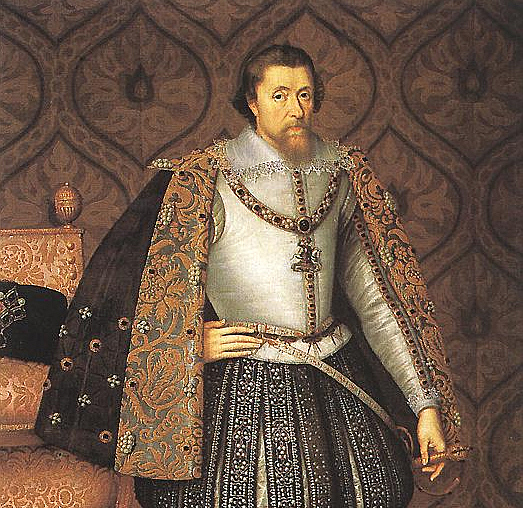
Abb.: King James I of England / von Paul van Somer, um 1603/13 [Ausschnitt]
[Bildquelle: Wikipedia, Public domain]
Text:
Roe, Thomas <1581?-1644>: The embassy of Sir Thomas Roe to India, 1615-19, as narrated in his Journal and correspondence / edited by William Foster [1863 - 1951]. -- New and rev. ed. -- London, Oxford University Press, 1926. -- lxxix, 532 S. : Ill. ; 19 cm. -- S. 502 - 505
Ebenfalls:
Payer, Alois <1944 - >: Quellenkunde zur indischen Geschichte bis 1858. -- 15. Frühe europäische Quellen und Quellen aus der Zeit der East India Companies. --11. Zum Beispiel: Briefwechsel zwischen King James I. und Großmogul Jahāngīr (نور الدین جهانگیر). -- http://www.payer.de/quellenkunde/quellen1511.htm
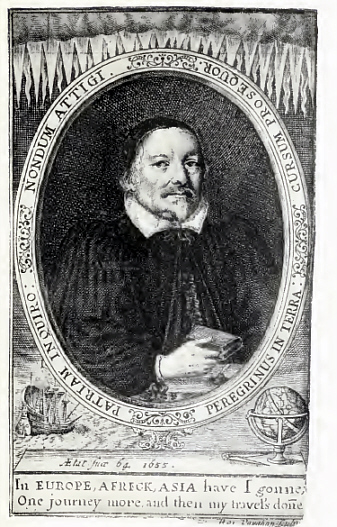
Abb.: Edward Terry
[Bildquelle: a.a.O., vor S. 289]
Text:
Early travels in India 1583 - 1619 / ed. by William Foster [1863 - 1951]. -- London [u.a.] : Milford, Oxford university press, 1921. -- xiv, 351 S. : Ill. ; 19 cm. -- S. 288 - 332. -- Online: http://www.archive.org/details/earlytravelsinin00fostuoft. -- Zugriff am 2008-05-19. -- "Not in copyright."
Auszug:
Payer, Alois <1944 - >: Quellenkunde zur indischen Geschichte bis 1858. -- 15. Frühe europäische Quellen und Quellen aus der Zeit der East India Companies. --12. Zum Beispiel: Edward Terry, 1616 - 1619. -- Fassung vom 2008-06-08. -- http://www.payer.de/quellenkunde/quellen1512.htm
"TERRY, EDWARD (1590-1660), writer of travels, was born in 1590 at Leigh, near Penshurst, Kent. Educated at the free school, Rochester, and at Christ Church, Oxford, he matriculated on 1 July 1608, graduated B.A. on 26 Nov. 1611, and M.A. on 6 July 1614. In February 1615-16 Terry went out to India as chaplain with a fleet sent by the London East India Company, sailing in the Charles with Benjamin Joseph, commander of the expedition. In his account of the voyage Terry describes a fight with a Portugal carrack, in which Joseph was killed, on 6 Aug. 1616. The Charles anchored in Swally Road on 25 Sept. following. On 20 Aug. Sir Thomas Roe [q.v.], ambassador at the moghul's court, whose chaplain, the Rev. John Hall, died the day before, had written to the company's agent at Surat, saying that he could not 'live the life of an atheist,' and begging that another chaplain might be sent to him. Accordingly Terry, shortly after his arrival, was appointed to succeed Hall, and, travelling up country with four other Englishmen who were taking presents for the moghul, joined the ambassador, who was with the Emperor Jehanghir's camp at Mandoa, about the end of February 1617 (Roe, Journal), or, according to Terry, towards the end of March. On the way they were detained by the moghul's son (afterwards the Emperor Shah Jehan), who wished to see the presents meant for his father. Terry stayed at Mandoa till September 1617, and thence travelled with the moghul's camp in the ambassador's suite to Ahmedabad, and in the neighbourhood he remained till September 1618. At Ahmedabad he and others of the ambassador's suite were attacked by the plague, the outbreak of which is recorded in the memoirs of Jehanghir (ELLIOT, Hist, of India, vol. vi.) Terry also notes (November 1618) the comet mentioned in the same memoirs (ib.) He returned with Roe to England in 1619, their ship reaching the Downs on 15 Sept. The court minutes of the East India Company record (22 Oct. 1619) that the freight on the goods of 'Terry the preacher' was remitted, he 'being so much commended by Sir Thomas Roe for his sober, honest, and civil life.' On his arrival in England he went back for a while to Christ Church, and in 1622 wrote, and presented in manuscript to Prince Charles, an account of his life in India. On 26 Aug. 1629 he was appointed rector of Great Greenford, Middlesex, where he lived till his death on 8 Oct. 1660. 'He was an ingenious and polite man of a pious and exemplary conversation, a good preacher, and much respected by the neighbourhood'(Wood, Athenae Oxon.) He was buried in the chancel of his church on 10 Oct. 1660. On 22 Aug. 1661 his widow Elizabeth was buried at Greenford. A son James (d. 1680) matriculated from Pembroke College, Oxford, on 16 April 1641, took orders, and became rector of Mickelmarsh, Hampshire, being ejected from the living in 1662 for nonconformity.
Besides two sermons, printed in 1646 and 1649, Terry published :
'A Voyage to East India,' with portraits and a map,London, 1655 ; reprinted, London, 1777.
'Character of King Charles II, with a Short Apology before it, and Introduction to it, and Conclusion after it,' London, 1660, 4to.
A portrait of Terry, aetat. 64 (1655), engraved by R. Vaughan, is prefixed to his 'Voyage.' A summary of his narrative is given in Purchas's 'Pilgrimes' (ii. 1464 et seq.), and another epitomised version was published, with the English translation of P. della Valle's travels, in 1665.
[Wood's Athenae Oxon. ; Sir Thomas Roe's Journal; Purchas's Pilgrimes ; Cal. State Papers, East Indies, 1617-21 ; Sir H. M. Elliot's Hist, of India ; parish registers at Great Greenford.]
S. W. [Stephen Wheeler]"
[Quelle: Dictionary of national biography / ed by Sidney Lee. -- London : Smith, Elder. -- Bd. 56. -- 1898. -- S. 86]

Abb.: Sir Thomas Smythe (1558 - 1625), erster Vorsitzender der HEIC (1600 -
1621)
Die folgende Darstellung der Geschichte des Archivs der East India Company gibt einen guten Überblick über die Vielzahl der Quellen, die dort gespeichert sind, und vor allem über Bedingungen, unter denen Quellen bewahrt oder vernichtet wurden (Institutionenkunde als Teil der Quellenkunde). Viele der Quellen dieses Archivs sind gedruckt veröffentlicht.
"INTRODUCTION. "The records of the East India Company's governments in India are probably the best historical materials in the world." So said James Grant Duff in his History of the Mahrattas (ed. 1826, vol. ii, p. 185) ; and his reasons for the statement are not far to seek. The distance separating the Company from its servants in the East, and the jealous care with which it supervised their actions, necessitated full explanations by correspondence : while the system of administration in the Company's settlements and territories, which from the first took the form of a Council, also favoured a full disclosure of the motives underlying every decision of importance. In its final development, proposals were largely made in written minutes, which often, in controverted questions, provoked equally argumentative minutes of dissent ; and these were entered at full length upon the records of the Council meetings (termed "Consultations" or "Proceedings"), transcripts of which were regularly sent home. In early days these were accompanied by separate volumes containing copies of all letters received or sent ; in later times such correspondence was either entered on the Consultations, or, in cases of special importance, transmitted as enclosures to dispatches. Since equally careful, though more concise, records were kept at home of the proceedings of the Court of Directors and of the various Committees into which it divided itself, it is obvious that, had the archives of the East India House survived in their entirety, we should now be in possession of full information regarding the transactions both at home and abroad. But during the greater part of the Company's existence little heed was paid to the value of its records for historical purposes, and the preservation of any particular series depended chiefly on its practical utility in relation to current work. Fortunately, in most cases this was sufficiently great to ensure the retention of those on which the student is likely to set chief store.
Naturally it was the seventeenth and early eighteenth century records which mostly suffered from neglect or deliberate destruction. In April 1682 mention is made in the Court Minutes of "old books and papers which are in a confused manner layd in the upper garret of the [East India] House." Evidently no remedial measures were applied, for in January 1717 it was reported that one of the Surat Journals had been cut out of its covers and stolen, and that "great quantities of the Company's packets and other papers were thrown on heaps in the Back Warehouse" ; whereupon a Committee was [S. ii] appointed to select a place for the papers, and a proper officer to look after them. Nothing seems to have resulted, however; for in March 1720 the Court was once more "moved to consider what was to be done with great numbers of papers, packets, and old books, removed out of the Secretary's, Accomptant's, and other offices of the House, and carryed into the warehouse on the other side of the garden, where they lye in the utmost confusion, and it is feared many of them are destroyed." It was then ordered that the Secretary should take steps to have the documents sorted and put into a proper repository ; and this was probably the origin of the Book Office mentioned in the next extract.
Fifty years passed, during which the inflow of records from India continued in ever increasing volume, while the rapid development of the Company's responsibilities in that country produced a corresponding expansion in the correspondence with the various Presidencies. In November 1769 an endeavour was made to relieve the Secretary of part of his burden, by establishing a separate branch of his department for such work, with Samuel Wilks at its head as "Examiner of the Indian Correspondence and Records"; and 16 months later steps were taken to place the Book Office on a proper footing. On 26 March 1771 the Committee of Correspondence reported as follows :
"The Committee having considered of the present confused and disorderly state of the repository for the books, records, and accounts from the several Presidencies and factories in the East Indies, consisting of many thousand volumes, which are annually increasing, and that, in order to remedy the inconveniences, difficulties, and loss of time at present experienced in collecting and arranging the books, to which frequent recourse is necessary to be had, the Committee consider it a matter of essential consequence that a capable and experienced officer be appointed to have the care and custody of the said books, records, and papers, to arrange, number, and register them in proper catalogues ; also to keep an account of the deliveries thereof to any person or persons, so that the same may be preserved from being lost or injured. And Mr. William Barnett being recommended as a proper person for this employ, the Committee offer it to the Court as their opinion that he be appointed Register and Keeper of the Indian Books, Records, Accounts, and other Papers deposited in the room usually called the Book Office, under such regulations, instructions, and directions as he shall from time to time receive from this Committee, at the salary of 100l. a year, to commence from this day."
This proposal was approved by the Court of Directors on the same day, and thus a Record Department came into existence at the East India House. The "Register and Keeper" was, however, a mere custodian of the collection, and his remuneration was evidently fixed on this basis. The next step was to [S. iii] appoint someone of higher attainments to investigate the contents of the volumes, and this came about in the following manner : —
In April 1776 the Examiner's branch was made into a separate department, independent of the Secretary. After a long period of absence from ill-health, Samuel Wilks retired in April 1785, and was succeeded by Samuel Johnson (of the Secretary's Office), who had been acting as Examiner for the past three years.1 This arrangement was evidently a disappointment for Wilks's son Thomas, who had been Assistant Examiner from the beginning of 1770 : and, in May 1786, he and his two brothers, William Morton and Samuel Charles (who were clerks in the department), petitioned the Court for transfer to some other branch of the office, on the ground that Johnson's behaviour towards them was making their positions intolerable. Johnson, in reply, charged the three brothers with intriguing against him and obstructing the work of the department, and intimated that he would be glad to get rid of them. The authorities took time to consider the matter, and it was not until the following March that a decision was reached. Thomas Wilks had already suggested, when making his application, a plan of employment which would be agreeable to himself and, he thought, advantageous to the Company (Miscellaneous Letters Received, vol. 78, No. 214). This was, that he should take over the post of Register and Keeper of the Indian Books, the then Register (Matthew Wall, who had succeeded Barnett in 1776) being in future styled Deputy Register, though continuing his existing duties and receiving the same salary as before. Wilks himself was to make an investigation of the records from the earliest time, for the purpose of compiling statements of the origin of the Company's possessions, particulars of the grants of privileges, an account of the methods adopted from time to time for collecting the revenues, and similar information likely to be of use for Parliamentary and other purposes. He supported his proposals by instancing a case that had occurred in 1783, when it was decided, with reference to a Bill then under consideration in the House of Lords, to collect the grants under which the Company held its respective territories—a task which proved to be one of great difficulty, owing to the necessity of searching through long files of Consultations for the desired information. Wilks's arguments evidently impressed the Directors, who, on 23 March 1787, decided that he should be employed in the manner suggested (receiving his instructions from the Court or from the Secretary), but should confine his researches for the time being to the period anterior to 1765. His proposal that he should be given the title of Register, with authority over the Book Office, was ignored, and that branch [S. iv] went on as before. William Wilks was appointed to assist his brother, while Samuel Charles was transferred to another department.
1 Johnson's successors were: William McCulloch (1817), James Mill (1830), Thomas Love Peacock (1836). John Stuart Mill (1858).
Some of the results of Thomas Wilks's activities are still to be traced among the Home Miscellaneous and Factory Miscellaneous series. His position was evidently felt to be an anomalous one. In April 1788 the matter was reconsidered, and it was decided that the office of Register and Keeper of the Indian Books should be divided ; that Thomas Wilks should henceforward be styled "Register," his duties remaining as before ; and that Matthew Wall should continue the work of the Book Office, with the title of "Keeper."1 On the death of Thomas Wilks in 1791, he was succeeded by his brother William Morton Wilks ; and when the latter died, the post was filled (April 1795) by the promotion of his assistant, William Jackson. Up to that time the Register's office had evidently retained its independent position, for the Directors then decided that it should be placed "under the Examiner or the Secretary, as may be determined hereafter "( Court Minutes, 8 April 1795). So far as can be ascertained, no ruling was ever made on this point, and the "Register of Indian Records continued to be the head of a small department of his own, engaged for the most part, it would seem, in cataloguing the miscellaneous seventeenth century records, which were evidently in its custody.2 The first collection of Original Correspondence was probably put together in this department.
1 Subsequently the old designation of "Register (altered later to the more modem form of 'Registrar') of the Book Office" was revived. In 1836 the Book Office appears in the East India Register as definitely attached to the Examiner's Department. Christopher Waud was then the Registrar, and he continued to hold the post until the end of the Company's rule.
2 See a note on page 32 of vol. i of Robert Wissett's Compendium of Eat Indian Affairs (1802) and Bruce's Annals, passim.
Meanwhile the investigation of the records for historical purposes was being pursued in a semi-official way by the well-known Robert Orme. After the appearance of the first volume of his Military Transactions of the British Nation in Indostan, the Directors (August 1769) encouraged him to continue his researches, and ordered their Secretary to give him access to any of their records that he might desire to consult ; while in 1772 they voted him an annuity of 400l. for the same purpose. Orme availed himself extensively of the privilege granted to him, as may be seen from Mr. S. C. Hill's Catalogue of the Orme MSS. in the India Office Library ; and many of the volumes in the Factory series have his neat initials affixed in pencil, to testify to his examination of their contents. In 1793 a complication arose. Henry Dundas, the President of the India Board, pressed the Company to appoint a regular Historiographer, in the person of his protégé, John Bruce ; to which the Directors replied that [S. v] virtually they already had such an officer, namely, Robert Orme. However, Dundas persisted ; and as a compromise Orme was officially designated Historiographer (though without any other remuneration than the annuity already mentioned), while Bruce was promised the reversion of the post and was given 100l. a year in the meantime. Orme's death in 1801 left the office vacant, and Bruce was thereupon allowed rooms at the East India House and provided with clerical assistance for the compilation of his Annals of the East India Company, 1600-1708 (published in 1810). He had, however, no actual responsibility for the records, and his clerks merely made extracts from them, which Bruce worked up at home with the aid of his principal assistant.
Thus matters remained until March 1817, when Jackson applied for permission to retire, at the same time suggesting that his department should be abolished and its duties transferred either to the Historiographer or to the Librarian. The Directors, however, smarting under the loss of their exclusive privileges in the matter of trade with India, were busily engaged in pruning their establishments, and the Historiographer's office was one of those marked down for abolition. They therefore determined (March 1817) to transfer the duties both of the Historiographer and of the Register of Indian Records to the Librarian, Dr. (afterwards Sir) Charles Wilkins, who was given an increase of salary from 500l. to 700l., and was allowed an additional clerk in respect of the extra work. Jackson and Bruce were both pensioned. In October 1817, Wilkins reported that he had assumed control of the Register's office and had taken over the records belonging to the department of the Historiographer.
In this manner was instituted what in 1821 we find described as the "Register Department of the Library," the work in which seems to have consisted mainly of making catalogues and indexes of, and extracts from, the early records which had been transferred from the "Indian Register Office."
It was in the Library that the revised catalogue of the Original Correspondence was compiled (about 1827-31). When exactly this function of the Librarian ceased has not been discovered ; but apparently all active work upon the records came to an end with the retirement, in February 1835, of Peter Pratt, the clerk specially engaged for this duty. The death of Sir Charles Wilkins followed in May 1836, and on the appointment of his successor (Professor Wilson) no mention was made of any duties in connection with the records. As regards the documents themselves, since there is no trace of their having been transferred to the Book Office, it may be presumed that they remained in the Librarian's custody until 1858.
Apparently the contents of the Book Office were restricted to the later Consultations, ledgers, and other records received from India in volume form, while the correspondence remained in the departments of the Secretary and the Examiner (see Home [S. vi] Miscellaneous, vol. 456E). This in time produced an inconvenient accumulation of records in both departments. At the end of September 1814, Thomas Fisher, an extra clerk in the Examiner's Department, was specially appointed "to arrange, preserve, and produce when called for, the papers transmitted annually from India, as well as those which are prepared in the Examiner's Department, and to see that they are regularly returned " (Correspondence Minutes, vol. 3, p. 811) ; and in March 1816, he was put upon the establishment with the title of "Searcher of the Records."1 The special collections made by him were known later as Fisher's Papers. His post was abolished in April 1884, when its duties were merged into the general work of the Examiner's Department.
1 Besides being something of an artist, Fisher was a zealous antiquary. For an account of his literary and other activities, the notice of him in the Dictionary of National Biography should be consulted.
Thus far we have dealt only with the records of the East India Company. There is, however, another constituent of importance in the present collection, namely the documents which originally belonged to the Commissioners for the Affairs of India, commonly called the India Board or Board of Control. This body, established in 1784 to supervise the East India Company in all its transactions other than commercial, rapidly accumulated a quantity of records. Some of these had come from the government department which had previously dealt with Indian affairs ; others originated in the office itself, in the shape of minutes of the Board's proceedings, correspondence with other government departments, abstracts, memoranda, &c. ; but the bulk consisted of documents and transcripts received from the East India House, thus duplicating the collections existing there. In July 1811, the Board appointed a "Librarian and Keeper of the Papers," whose duty it was to take charge of such records as were not retained in the several departments, and to register and index them. Later (about 1838), his title was changed to "Register and Keeper of the Papers," though he appears to have remained responsible for the Library as well.
As a consequence of the India Act of 1858, the President of the Board of Control became the first Secretary of State for India in Council, and the two offices were amalgamated. Since the Board's office in Cannon Row was quite inadequate for his increased establishment, the Secretary of State took up his quarters at the East India House, though part of his staff and all the Board's records remained at Westminster. This arrangement was a provisional one, as the intention was to erect a new India Office in Whitehall, adjoining the new Foreign Office.
From the lists of the establishment that was now organised, we find that Wand retained his old place as Book Office Registrar, but was attached to a "Record and Statistical Department," which superseded the Statistical Department of [S. vi] the Company's days. Mr. Marmaduke Hornidge remained at the head of the department, though his designation was changed to that of "Searcher of Records and Statistical Reporter" ; and he had for assistant Mr. Charles Campbell Prinsep. A start was at once made with the overhauling of the records, in preparation for the impending change of quarters. As early as December 1858, Wand obtained authority to sell as waste paper about 21 tons of tradesmen's bills, sale books, catalogues, appearance books, &c., that had been accumulating during the past thirty years ; and in the following June nearly two tons of other documents were disposed of in the same way, as being no longer required. In February 1860 the Secretary of State (Sir Charles Wood) gave directions that all useless records, either in the Cannon Row office or in the East India House, should be got rid of, and Messrs. T. N. Waterfield (who was in charge of those in the former office), Fletcher (his assistant), and Waud were appointed a committee for that purpose. To this body Mr. Mark Napier, the chief clerk in the Correspondence Department, and Mr. (afterwards Sir John) Kaye, the Political Secretary, were subsequently added. On the recommendation of the Committee, over 300 tons were sold as waste paper. Much of this consisted of duplicates, arising from the fact, already mentioned, that the records at Cannon Row were largely copies of those in Leadenhall Street, and part at least of the remainder was made up of lists of packet, bundles of commercial accounts, newspapers, dividend warrants, and similar papers, the destruction of which was not open to objection. It is clear, however, that some series of real importance for historical purposes were discarded, the only criterion applied being the probability or otherwise of their being needed for official use : while others narrowly escaped a similar fate. It was even contemplated to destroy the Minutes of the India Board, but fortunately this proposal was dropped ; while the records of the Court of Sadr Diwani were only saved by the interposition of Sir George Clerk, the Under Secretary of State, who suggested that it would be wise to ascertain first whether the original records were available at Calcutta.
The Committee appears to have finished its labours in the summer of 1860. Later in that year, as the well-known quarrel over the style in which the new Foreign and India Offices were to be built was still unsettled, the Secretary of State's establishment moved to temporary quarters in Victoria Street, Westminster, the freshly completed Westminster Palace Hotel having been rented for that purpose. The removal of the records from Leadenhall Street to these premises began on 1 September 1860, and was completed by the beginning of the new year. Such of the Canuon Row records as had survived appear to have been left there temporarily.
The present India Office was ready for occupation by the summer of 1867. The opportunity was taken to make a further reduction in the bulk of the records to be removed to the new [S. viii] building. Mr. Hornidge submitted to the heads of the other departments lists of such papers as, in his opinion, "might be destroyed, not only without inconvenience, but with very great official advantage." The proposed reductions were of a sweeping character, but happily in many cases the departments objected, although once again the only consideration that was really taken into account was whether or not the documents were likely to be referred to for official purposes. The results of these discussions were then submitted to the Under Secretary of State (Mr. Herman Merivale), who sanctioned the destruction of those records with which the departments had agreed to dispense. The removal of the rest to their new quarters occupied from the middle of June to 20 September 1867. The records which had been left at Cannon How were taken to the India Office in February 1868.1
1 These particulars are derived from Home Miscellaneous, vol. 722.
In the spring of 1874 a re-organisation took place which involved the disappearance of the Record and Statistical Department (with the retirement of Mr. Hornidge) and the creation of a new ''Statistics and Commerce Department," with the care of the records as a subordinate duty. The secretary of the new department was Mr. (afterwards Sir) Henry Waterfield, with Mr. C. C. Prinsep as his assistant. Under Mr. Waterfield's superintendence improvements were made in the record rooms ; the unbound records were examined, and lists were drawn up which were of considerable assistance in their subsequent arrangement ; while the valuable collection of seventeenth century documents, from which at a later date the Factory series was mainly formed was arranged and roughly catalogued by Dr. (afterwards Sir) George Birdwood, whose report on the subject is well-known.1 It is not going too far to say that it was the interest aroused by his enthusiastic account of these neglected materials that brought about the reforms of 1884 ; and the work of classification and publication then undertaken by Mr. Danvers owed not a little of its success to the support and assistance of Sir George Birdwood. Another helper was Sir Henry Yule, who, during his tenure of office as a Member of Council (1875-89), made effective use of the seventeenth century records in his edition of The Diary of William Hedges (Hakluyt Society, 1888-89), and was ever ready to advocate the preservation and utilisation of the India Office archives.
1 Printed for official use in 1879, and reprinted for the same purpose (wihi additions) in 1890. The latter edition was reprinted and published by Messrs. Allen & Co. in 1891.
In 1879 Mr. Waterfield became Financial Secretary in succession to Sir Thomas Seccombe ; while the Revenue branch of the Judicial, Public and Revenue Department was transferred to the Statistics and Commerce Department, the new head of which was Mr. W. G. Pedder. The records remained under the [S. ix] care of the latter department, but were placed under the special charge of Mr. Prinsep, who was now termed "Statistical Reporter and Superintendent of the Records." Thus matters remained until the beginning of 1884, when the custody of the records was made over to a new department, termed the "Registry and Records Department," which absorbed the existing Registry Department. The first to hold the combined office of Registrar and Superintendent of Records was Mr. Frederick Charles Danvers, who had been an assistant in the Revenue, Statistics and Commerce Department, and had suggested the new arrangement in September 1882.
Mr. Danvers entered upon his duties with great energy, and until his retirement in 1898 he was busily engaged in sorting, binding, and reporting upon the records in his charge. A report by him, dealing chiefly with the collections relating to Java and other countries outside India, was issued as a Parliamentary Paper [C. 5055] in 1887 ; and from this in the following year was prepared an edition for office use, containing an additional section on the China and Japan records. A similar report on the Persia and Persian Gulf records was printed for official purposes in 1891. During the remainder of Mr. Danvers's term of office he completed the sorting and binding of all the loose papers, acquired a number of useful transcripts from the Portuguese and Dutch archives (making several journeys to Lisbon and the Hague for the purpose), and commenced the compilation and printing of detailed press lists for each section of the records. At the time of his retirement, however, only two of these, viz., the List of the Marine Records (1896) and the List of the Factory Records (1897), had been actually printed.
Mr. Danvers's period of administration was also noteworthy for the start that was made with the publication of the early records. In 1886 the first volume of the Court Minutes of the East India Company was published at the cost of Mr. Henry Stevens, with an introduction by Sir George Birdwood : and this was followed, seven years later, by the issue of The First Letter Book of the East India Company, edited by Sir George Birdwood and Mr. William Foster. In 1896, upon Mr. Danvers's initiative, the first volume appeared of a verbatim edition (in modernised spelling) of the early portion of the Original Correspondence series, under the title of Letters Received by the East India Company from its Servants in the East. Of this series only two volumes (1602-13 and 1613-15) had been published at the time of Mr. Danvers's retirement.
Under his successor, Mr. (now Sir) Arthur N. Wollaston, the issue of the press lists was completed, as follows :—
Bengal Consultations, &c., 1704-1858 (1899).
Bengal Proceedings, &c., 1859-97 (1899).
Government of India Proceedings, &c., 1834-58 (1900).
Covernment of India Proceedings, &c., 1859-98 (1900). [S. x]
Proceedings, &c., of the North- Wester Provinces and other Minor Administrations, 1834-99 (1902).
Bombay Proceedings, &c., 1702-1900 (1902).
General Records, 1599-1879 (1902).
Madras Proceedings, &c., 1702-1900 (1904).
The ten press lists thus printed form the working lists of the present Record Department. Every volume in its custody (save certain duplicates) will be found in one or other of the lists, with (in most cases) an indication of its position on the shelves.
Under Mr. Wollaston, the series of Letters Received was continued by Mr. Foster down to a sixth volume (1617), which appeared in 1902. A fresh series was then started, under the title of The English Factories in India. In this, with a view to more rapid progress, abstracts were given in lieu of printing the documents in full, and the scope was restricted in the main to the settlements in India itself ; but, on the other hand, documents in the Public Record Office, the British Museum, and the Indian Record Offices were included. A companion series of calendars of the Court Minutes and other home papers (including documents in the Public Record Office) was also commenced, the text being compiled by Miss E. B. Sainsbury, and the introductions contributed by Mr. Foster. The series began with the year 1635, the earlier period having been dealt with in Mr. W. N. Sainsbury's Calendars of State Papers, East Indies, issued by the Public Record Office.1 At the date of Mr. Wollaston's retirement (1907), one volume in each series had been issued. They are still in course of publication by the Clarendon Press, Oxford, and have reached 1654 in the one case and 1659 in the other.
1 Though chiefly concerned with the documents in the Public Record Office itself, these calendars included both the Court Minutes and the Original Correspondence series of the India Office. They came to an end upon the appearance of a fifth volume in 1892. The first four volumes have been for some time out of print.
The activities of the various Indian Record Offices, in the publication of press lists, calendars, &c. are described at the appropriate places in the text of this work.
The present handbook is largely a summary of the India Office press lists already mentioned, which were only printed for official use and hence are not generally available. Its scope, however, is in one way more restricted, since the press lists include records of later date than 1858. The arrangement too is different, the object being to meet the needs of students who are not familiar with the subject. For the same purpose u considerable amount of explanatory matter has been inserted, giving information regarding the contents of the various series ; while, especially in the case of the Consultations of the Indian [S. xi] Governments, the genesis of each section is briefly recorded. In cases in which any series, or portion of a series, has been printed or calendared, a note has been made.
As the particulars given have been purposely condensed as far as possible, the handbook does not entirely obviate the necessity of referring to the press lists when using the records. For instance, if it is desired to consult the Court Minutes or the Despatches or the Consultations for any particular date, it will still be necessary to go to the relevant press list, in order to specify the volume required. Otherwise, if the year only is given, the Record Department may (in the case of Consultations) be put to the trouble of producing a dozen volumes when only one is really wanted. In order to facilitate the task of looking up the press lists, references have been inserted in the handbook whenever there is likely to be a difficulty in identifying the series by means of the index.
The records here dealt with are in the main those which are under the charge of the Registrar and Superintendent of Records ; but references have been included to such series in the departments of the Political Secretary and of the Accountant-General as are similar in character or complementary to the Record Department files.
It will not escape notice that, while attention has been devoted mostly to the records relating directly to India, the collection itself (as will be seen from Section III.) makes a much wider appeal to historical students. Not only was the East India Company brought into contact with every country of Southern Asia, from Arabia to China and Japan, and with the islands in the Indian Ocean, including Madagascar, Ceylon, Sumatra, Java, Borneo and the Moluccas, but in Africa it had much to do with Egypt and the Cape Colony, to say nothing of the island of St. Helena and the early factories on the Gold Coast. Further, its relations with the Portuguese, the French, the Dutch, the Danes, and other European competitors in Eastern commerce bulk largely in its records, which also include many references to Australian and American trade with Asiatic countries.
Much information upon Indian topics, including copious extracts from the East India Company's records, will be found published in Parliamentary Papers. Detailed lists (with index) of those dealing with India issued between 1801 and 1907 were drawn up in the India Office and printed as a House of Commons paper (No. 89) in 1909 ; and a printed list of earlier documents of the same nature is available for reference. There are also several collections in the India Office Library which afford valuable information, such as the Mackenzie, the Orme, and the Philip Francis MSS. Catalogues of the first two of these collections have been published. It may further be mentioned that a large proportion of the India Office records are duplicated by those in various Record Offices in India, and it is sometimes [S. xii] found that a document missing from the home files is still on record in its place of origin. Much has been done of late years to fill up gaps, in the India Office series by obtaining transcripts from India, and this process is still going on. Press lists (which may be consulted at the India Office) are being issued by the Record Offices at Calcutta (both the Imperial and the local), Madras, Bombay, Lahore, and Nagpur.
Certain duplicates of documents in the Factory and Home Miscellaneous series in the India Office have not yet been put in order, and are not referred to in the text.
Access to such of the India Office records as are not regarded as still confidential is readily granted for purposes of historical research. Applications should be addressed to the Registrar and Superintendent of Records. For information from the ecclesiastical returns of baptisms, marriages, and burials it is necessary to apply to the Accountant-General.
The volumes dealt with in this little handbook are estimated to number about forty-eight thousand. To re-examine the whole of these was manifestly impossible, although as a matter of fact several hundreds of them have been specially consulted for the purpose ; and it has been necessary therefore to depend largely on the press lists already compiled. This must be in part the excuse for any errors or omissions which may be discovered."
[Quelle: Foster, William, <1863-1951>: A guide to the India office records, 1600-1858. -- London : Printed for the India office by Eyre and Spottiswoode, 1919. -- xii, 130 S. ; 22 cm. -- S. i - xii. -- Online:http://www.archive.org/details/guidetoindiaoffi00greauoft. -- Zugriff am 2008-05-20. -- "Not in copyright".]
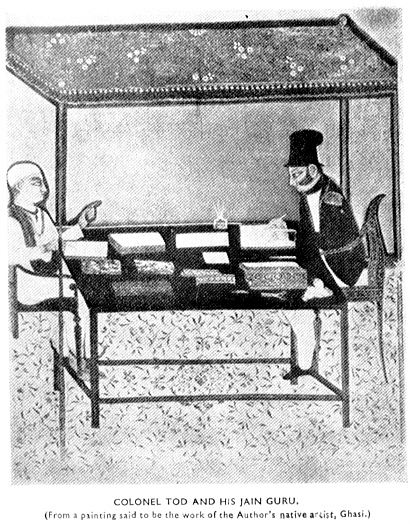
Colonel Tod and his Jain guru
[a.u.a.O., vol. III, Frontispiece]
Text:
Tod, James <1782 - 1835>: Annals and antiquities of Rajasthan, or The central and western Rājput states of India / by James Tod, ed. with an introduction and notes by William Crooke [1848 - 1923]. -- London : Oxford University Press, 1920. -- 3 Bde. ; 19 cm.
Siehe:
Payer, Alois <1944 - >: Quellenkunde zur indischen Geschichte bis 1858. -- 9. Quellen in Regionalsprachen. -- Fassung vom 2008-04-24. -- http://www.payer.de/quellenkunde/quellen09.htm
TOD, JAMES (1782-1835), colonel, Indian diplomatist, born at Islington on 20 March 1782, was the son of James Tod (b. 1745), and Mary, the daughter of Andrew Heatly, a Scotsman, settled in Rhode Island. In 1798 his uncle, Patrick Heatly, procured him an East Indian cadetship, and, after a course of instruction at Woolwich, he proceeded (March 1799) to Bengal, where he was posted to the 2nd European regiment, his commission bearing date 9 Jan. 1800. Volunteering for service with Lord Wellesley's projected expedition to the Moluccas, he served for a short time with the marines on board the Mornington. Appointed on 29 May 1800 lieutenant in the 14th Bengal infantry, he went up country; and in 1801, when stationed at Delhi, was ordered to survey an old canal in the neighbourhood. In 1805 he was attached to the escort sent with Graeme Mercer, envoy and resident at Sindhia's court. While travelling with the maharaja's camp, and afterwards from 1812 to 1817 when it remained at Gwalior, he was constantly engaged either in surveying or in collecting topographical information. In 1815 he submitted a map to the governor-general (Lord Hastings), in which for the first time the term 'Central India' was applied to the collection of native states now under the Central India agency. Rajputana was also included in the area of his researches. 'Though I never,' he wrote, 'penetrated personally further into the heart of the Indian desert than Mandate . . . my parties of discovery have traversed it in every direction, adding to their journals of routes living testimonies of their accuracy, and bringing to me natives of every t'hul from Bhutnair to Omurkote and from Aboo to Arore. The journals of all these routes, with others from Central and Western India, form eleven moderate-sized folio volumes' (Annals of Rajasthan, ii. 289). Most of his extra salary was spent in paying his native explorers. In October 1810 he was promoted captain, with command of the resident's escort; and in October 1815 the resident, Richard Strachey, nominated him second assistant.
When Lord Hastings, in 1817, began operations against the Pindharis, Tod's local knowledge became invaluable. He had already sent in reports on the Pindharis and plans of a campaign, and on volunteering for service was sent to Rowtah in Haraoti, where he organised and superintended an intelligence department, which in the governor-general's opinion 'materially contributed to the success of the campaign.' He also induced the regent of Kotah to capture and surrender to the British officers the wives and children of the leading Pindhari chiefs.
In 1818, after the chiefs of Rajputana had accepted the protective alliance offered to them, Tod was appointed by the governor-general political agent in the western Rajput states, and was so successful in his efforts to restore peace and confidence that within less than a year some three hundred deserted towns and villages were repeopled, trade revived, and, in spite of the abolition of transit duties and the reduction of frontier customs, the state revenue had reached an amount never before known. During the next five years. Tod earned the respect of both the chiefs and the people ; and was able to rescue more than one princely family, including that of the ranas of Udaipur, from the destitution to which they had been reduced by Mahratta raiders. Bishop Heber, who travelled through Rajputana in February 1825, was told that the country had never known prosperity till Tod came, and that every one, rich or poor, except thieves or Pindharis, loved him. 'His misfortune.' Heber added, 'was that, in consequence of favouring native princes so much, the government of Calcutta were led to suspect him of corruption, and consequently to narrow his powers and associate other officers with him in his trust, till he was disgusted and resigned his place.' 'They are now,' said Heber, ' satisfied, I believe, that their suspicions were groundless.' But ill-health was the reason assigned for Tod's retirement in June 1822, though it did not prevent his journeying to Bombay by the circuitous route described in the volume of 'Travels in Western India,' published after his death.
He left Bombay for England in February 1823, and never returned. The remainder of his life was mostly spent in arranging and publishing the immense mass of materials amassed during his Indian career. He also acted for a time as librarian to the Royal Asiatic Society, before which he read several papers on his favourite subjects. On 1 May 1824 he was gazetted major, on 2 June 1826, lieutenant-colonel, being retransferred to the 2nd European infantry, and on 28 June 1825, he retired from the service.
Thenceforth he lived much on the continent, and in 1827 visited Count de Boigne, Sindhia's old general at Chambéri. In September 1835 he purchased a house in Regent's Park, and on 10 Nov. following, while transacting business at his banker's in Lombard Street, was stricken with apoplexy, from which he never recovered. He died on 17 Nov. 1835, aged 53. On 16 Nov. 1820 he married the daughter of Dr. Clutterbuck, a London physician, by whom he had two sons and a daughter.
Tod published, besides archaeological papers in the Royal Asiatic Society's 'Transactions' and a paper on the politics of Western India, appended to the report of the House of Commons committee on Indian affairs, 1833 :
'Annals and Antiquities of Rajasthan, or the Central and Western Rajpoot States of India,' London, 1829-32,2 vols. 4to; a second edition was published at Madras in 1873, and a popular edition at Calcutta, s.d.
'Travels in Western India, embracing a Visit to the Sacred Mounts of the Jains, London, 1839, 4to, with an anonymous memoir of Tod.
[Tod's works cited above; R. A. S. Journal, vol. iii. p. lxi (1836); Asiatic Journal, 1836, p. 165.]
S. W. [Stephen Wheeler]"
[Quelle: Dictionary of national biography / ed by Sidney Lee. -- London : Smith, Elder. -- Bd. 56. -- 1898. -- S. 424f.]
1828 erschien anonym ein burleskes Gedicht in 12 Cantos mit 6596 Zeilen über einen "griffin":
[D’Oyly, Charles <1781-1845>:] Tom Raw, the Griffin: a burlesque poem, in twelve cantos: illustrated by twenty-five engravings, descriptive of the adventures of a cadet in the East India company’s service, from the period of his quitting England to his obtaining a staff situtation in India / by a civilian and an officer on the Bengal establishment. -- London : Printed for R. Ackermann, 1828. -- 325 S. : 25 col. pl. ; 26 cm. -- Online: http://www.archive.org/details/tomrawgriffinbur00doylrich. -- Zugriff am 2008-06-01. -- "Not in cpyright"
Auszug (Canto X):
Payer, Alois <1944 - >: Quellenkunde zur indischen Geschichte bis 1858. -- 15. Frühe europäische Quellen und Quellen aus der Zeit der East India Companies. --13. Zum Beispiel: "Tom Raw, the Griffin", 1828. -- http://www.payer.de/quellenkunde/quellen1513.htm
Alle Abbildungen siehe:
Payer, Alois <1944 - >: Quellenkunde zur indischen Geschichte bis 1858. -- 7. Bildträger. -- 3. Zum Beispiel: "Tom Raw, the Griffin", 1828. -- http://www.payer.de/quellenkunde/quellen073.htm
"griffin" bedeutet "Greenhorn in Indien":
"GRIFFIN, GRIFF, s.; GRIFFISH , adj. One newly arrived in India, and unaccustomed to Indian ways and peculiarities; a Johnny Newcome. The origin of the phrase is unknown to us. There was an Admiral Griffin who commanded in the Indian seas from Nov. 1746 to June 1748, and was not very fortunate. Had his name to do with the origin of the term? The word seems to have been first used at Madras (see Boyd, below). [But also see the quotation from Beaumont & Fletcher, below.] Three references below indicate the parallel terms formerly used by the Portuguese at Goa, by the Dutch in the Archipelago, and by the English in Ceylon." [Quelle: Yule, Henry <1820 - 1889> ; Burnell, A. C. (Arthur Coke) <1840 - 1882>: Hobson-Jobson : being a glossary of Anglo-Indian colloquial words and phrases and of kindred terms etymological, historical, geographical and discursive. -- London : John Murray, 1886. -- xlviii, 870 S. ; 23 cm. -- s.v. -- Online: http://www.archive.org/details/hobsonjobsonbein00yuleuoft. -- Zugriff am 2008-06-01. -- "Not in coypright."
Der Verfasser und Zeichner ist Charles D’Oyly <1781-1845>, der 40 Jahre in Indien lebte:
"D'OYLY, SIR CHARLES, seventh baronet (1781-1845), Indian civilian and artist, was the elder son of Sir John Hadley D'Oyly, the sixth baronet, of Shottisham, Norfolk, formerly collector of Calcutta and M.P. for Ipswich, who restored the fortunes of the family, which had previously been at a low ebb through generations of spendthrifts. He was born in India on 18 Sept. 1781, and in 1785 accompanied his family to England, where he was educated. Having determined on entering the civil service of the East India Company, he sailed for Calcutta in his sixteenth year. He was appointed assistant to the registrar of the court of appeal at Calcutta in 1798, keeper of the records in the governor-general's office in 1803, collector of Dacca in 1808, collector of government customs and town duties at Calcutta in 1818, opium agent at Behar in 1821, commercial resident at Patna 1831, and finally senior member of the board of customs, salt, and opium, and of the marine board in 1833. After forty years of honourable service he was compelled by severe ill-health to return to England in 1838. The remainder of his life was chiefly spent in Italy, and he died at Leghorn on 21 Sept. 1845. D'Oyly was twice married, first, to his cousin, Marian Greer, and secondly to Elizabeth Jane, daughter of Thomas Ross, major R.A., but he left no direct issue, and was succeeded in the baronetcy by his brother, Sir John Hadley D'Oyly. D'Oyly was an amateur artist of some powers, and his drawings, chiefly illustrative of Indian customs and field sports, were highly commended by Bishop Heber, who calls him 'the best gentleman artist he ever met with' (HEBER, Journey through the Upper Provinces of India, i. 314, 2nd edition). Several collections of them were published. 'The European in India, with a preface and copious descriptions by Captain Thomas Williamson, and a brief History of Ancient and Modern India by F. W. Blagdon,' appeared in 1813, and a valuable work on the 'Antiquities of Dacca,' with engravings by John Landseer, from Sir Charles D'Oyly's drawings, was published in 1814-15. 'Sketches on the New Road in a journey from Calcutta to Gyah' appeared in 1830. He also published anonymously in 1828 'Tom Raw, the Griffin ; a Burlesque Poem,' illustrated by twenty-five engravings descriptive of the adventures of a cadet in the East India Company's service, which is more meritorious from an artistic than a literary point of view. [D'Oyly Bayley's Account of the House of D'Oyly ; Dodwell and Miles's Bengal Civil Servants, 1780-1838; Gent. Mag. 1843, new ser. vol. xxiv.]
L. C. S."
[Quelle: [Quelle: Dictionary of national biography / ed. by Leslie Stephen. -- London : Smith, Elder. -- Bd. 15. -- 1888. -- S. 418f.]
Russel Miller charakterisiert das Werk so:
"Das Gedicht von Sir Charles ist in burleskem Stil gehalten und über 6000 Zeilen lang. Es befaßt sich mit dem Werdegang Tom Raws, angefangen von seiner Ernennung zum Kadetten in der Armee der Ostindischen Kompanie im „.. . Fort William,
Einem solide gebautem Fort, in dem es nichts zu tun gibt,
Außer neue Regimenter in Empfang zu nehmen und zu ,grillen',
(Oder wenn sie im Mai oder Juni kommen, sie zu ,killen'),"bis zu einer Reihe von Abenteuern, die er in verschiedenen Regionen des indischen Subkontinents zu bestehen hat.
Das Gedicht ist durchzogen von einem wohlwollend-satirischen Ton. Toms Eltern, denen es in ihrem kleinen Haus allmählich etwas zu eng wird, vermitteln ihm eine Stelle als Kadett. Tom ist ein typischer Taugenichts, der sich durch eine Anzahl lächerlicher Situationen hindurchmanövriert und am Ende triumphierend aus ihnen hervorgeht. Die britischen Leser hatten ihn wegen der zahlreichen Fettnäpfchen, in die er trat, in ihr Herz geschlossen. Sie schätzten aber auch die in seiner Geschichte vermittelte Fülle an genauen Informationen über das interessante ferne Land, mit dem die englische Weltmachtstellung so eng verknüpft war."
[Quelle: Miller, Russell: Die Ostindienfahrer / von Russell Miller u.d. Red. d. Time-Life-Bücher. --Amsterdam : Time-Life-Bücher, 1981. -- 176 S. : Ill. ; 29 cm. -- (Die Seefahrer : Time-Life-Bücher). -- ISBN 90-6182-461-3. -- S. 163.]
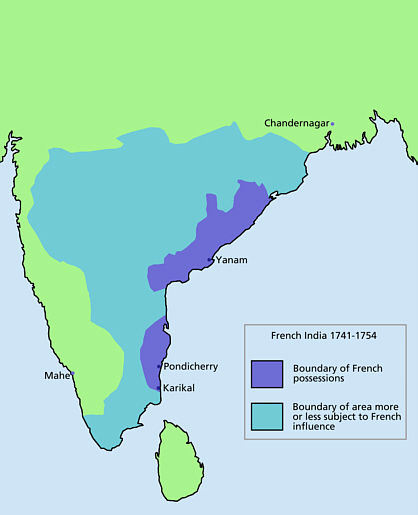
Abb.: Französische Besitzungen und Einflusszonen in Indien
[Bildquelle: Wikipedia, GNU FDLicense]
"INDIA, FRENCH, a general name for the French possessions in India on the Coromandel coast, Pondicherry [Puducherry/Putuccēri/ புதுச்சேரி], Karikal [காரைக்கால்] and Yanaon; on the Malabar coast, Mahe; and in Bengal, Chandernagore. In addition there are a few "lodges" elsewhere, but they are merely nominal remnants of French factories. The total area amounts to 203 sq. m., of which 113 sq. m. belong to the territory of Pondicherry. In 1901 the total population amounted to 273,185. By decree of the 25th of January 1879 French India was provided with an elective general council and elective local councils. The results of this measure have not been very satisfactory, and the qualifications for and the classes of the franchise have been modified. The governor resides at Pondicherry, and is assisted by a council. There are two tribunals of first instance (at Pondicherry and Karikal), one court of appeal (at Pondicherry) and five justices of the peace. The agricultural produce consists of rice, earth-nuts, tobacco, betel nuts and vegetables. History. The first French expedition to India is believed to have taken place in the reign of Francis I., when two ships were fitted out by some merchants of Rouen to trade in eastern seas; they sailed from Havre in that year and were never afterwards heard of. In 1604 a company was granted letters patent by Henry IV., but the project failed. Fresh letters patent were issued in 1615, and two ships went to India, only one returning. La Compagnie des Indes was formed under the auspices of Richelieu (1642) and reconstructed under Colbert (1664), sending an expedition to Madagascar. In 1667 the French India Company sent out another expedition, which reached Surat in 1668, where the first French factory in India was established. In 1672 Saint Thomé was taken, but the French were driven out by the Dutch and retired to Pondicherry (1674). In 1741 Dupleix became governor of Pondicherry and in 1744 war broke out between France and England; for the remaining history of the French in India see INDIA.
See Haurigot, French India (Paris, 1887); Henrique, Les Colonies françaises (Paris, 1889); Lee, French Colonies (Foreign Office Report, 1900); L'Année coloniale (Paris, 1900); and F. C. Danvers, Records of the India Office (1887)."
[Quelle: Encyclopaedia Britannica. -- 11. ed. -- Bd. 14. -- 1910. -- S. 421]
"Die französische Niederlage in Indien Zu der Zeit, da ich mich zu Pondicherry aufhielt, konnte diese Stadt höchstens 450 bis 500 Europäer enthalten; da eine so kleine Bevölkerung nicht viel verschiedenes Interesse, oder doch nicht viel widerstreitendes Interesse hervorbringen kann, hatte die Kolonie Ursache zu hoffen, dass sie nichts von den Unruhen, die Europa umwälzten, empfinden würde.
Allein die Revolution kündigte sich gleich mit allen Symptomen an, die den Jakobinismus in Frankreich charakterisierten, und wenn ihr Ausbruch für die Hälfte der Einwohner nicht verderblich war, so hat man es der Entschlossenheit des Chevalier de Fresne zu danken, der damals Gouverneur des Platzes war. Das Detachement, welches seine Garnison ausmachte, war noch der strengsten Mannszucht unterworfen, und es ist zu glauben, dass der unermüdliche Eifer dieses Offiziers die Kolonie vor den Unruhen, die sie seitdem erlitten hat, bewahrt haben würde, hätte Frankreich nicht in der Absicht, diesen Platz zu befestigen, ein Bataillon Infanterie hingeschickt, welchen bald Kommissarien folgten. Einer von ihnen, Kommissar der Marine, konnte, ungeachtet seiner Absicht, die Parteien zu einigen, nicht die Aufstellung der revolutionären Formationen verhindern, welche den Chevalier de Fresne zwangen, sich zurückzuziehen. Seine Abreise überantwortete den Platz dem Schicksal, das er seither erlitten hat.
Einige Zeit vorher hatte Lord Cornwallis mit Tipu jenen berühmten Frieden geschlossen, durch welchen die Englische Kompanie die Hälfte des Gebiets dieses Fürsten gewann. Jetzt sah sie ruhig im Mittelpunkt ihrer Besitzungen ihre Nebenbuhler ohne Macht und genoss ohne Furcht die Frucht ihrer Siege.
Sie befand sich indessen auf einem Krater, dessen Ausbruch bloß von dem Betragen der Feinde abhing. Die Abmachung, welche ihre Macht untergraben sollte, wurde entworfen und verfasst; aber die Umstände haben verhindert, sie zur Ausführung zu bringen. So schien das Schicksal ihr durch ein unbegreifliches Unglück immer den Sieg zu bestimmen.
Der Ruf der Französischen Revolution war bis zum Hofe Tipus gedrungen. Dieser Fürst glaubte, dass eine neue Ordnung der Dinge in Frankreich eine Veränderung zu seinen Gunsten hervorbringen und Verbündete, die ihn schon verlassen hatten, wieder an seine Seite bringen würde. Er entwarf damals die Unternehmungen, deren Folgen jetzt seinen Sturz nach sich gezogen haben.
In einer der Truppenbewegungen, die er unternahm, ehe Lord Cornwallis, um ihn anzugreifen, von Bengalen heranrückte, näherte er sich Pondicherry und campierte auf dem benachbarten Hügel. Da die Politik dem französischen Gouverneur nicht erlaubte, die Neutralität zu brechen und ihn in die Stadt aufzunehmen, so bat ihn dieser Fürst, Herrn L., Intendant der Festung, zu ihm zu schicken. Dieser Offizier war ein Kommissar der Marine und hatte sich durch langes Studium die maurische Sprache sehr zu eigen gemacht, sodass er mit dem Sultan ohne Dolmetscher sprechen konnte.
Tipu öffnete sich ihm voller Vertrauen, und hier entwarfen sie den Plan zu dessen Ausführung dieser Intendant nach zwei Monaten auf der Fregatte „Thetis" abreiste, um bei der Regierung um eine engere Verbindung und hinreichende Hilfe nachzusuchen, um diesen Fürsten instandzusetzen, den Waffen der englischen Kompanie kräftiger zu widerstehen. Der französische Kommissar, dem eine so wichtige Sendung sehr schmeichelte und dem es sehr darum zu tun war, zu dem Sultan in der Eigenschaft eines Bevollmächtigten zurückzukehren, verhehlte sich die Ungewissheit des Erfolgs und überredete sich, es durchzusetzen. Es kostete ihn keine Mühe, der Seele eines unglücklichen und verlassenen Fürsten alle die Hoffnung einzuflößen, von der er selbst belebt war. Durch dieses unselige Vertrauen wurde Tipu verleitet, einige Zeit nachher einen nachteiligen Frieden mit Lord Cornwallis zu schließen in der Hoffnung, sich dafür bald zu entschädigen und die aufgegebenen Vorteile wiederzuerlangen, sobald seine Abmachung von Frankreich ratifiziert sein würde.
Doch Frankreich, welches damals zu sehr mit seinen eigenen Angelegenheiten beschäftigt war, um an die von Indien zu denken, verschob einen Augenblick die Allianz, auf welche Tipu gehofft hatte. Erst als das Glück seiner Waffen ihm erlaubte, die Augen auf das Interesse dieses Fürsten zu werfen, gab das französische Direktorium, da es die Skizze der entworfenen Abmachung bei Pondicherry wiederfand, ihm einige Hoffnung, welche den unglücklichen Nabob bewog, den letzten Feldzug zu unternehmen, der nun seinen Thron umgestürzt hat.
Hätten die Unruhen in Europa der engen Verbindung, welche dieser Fürst verlangte, nicht entgegengestanden und Frankreich nicht verhindert, die erbetenen Truppen nach Pondicherry zu schicken, so ist es wahrscheinlich, dass sein Fall nicht würde stattgehabt haben. Die Franzosen hätten nun noch einen Verbündeten und einen festen Fuß in Indien, um in ruhigeren Zeiten ihren Handel wieder emporzubringen. Daher sind der Tod Tipus und die Vertreibung seiner Familie vom Thron neu hinzugekommene Schicksalsschläge zu allen denen, die Frankreich erlitten hat. Da die Zerstörung der Monarchie den Krieg zwischen der neuen Regierung und England herbeiführte, sind alle französischen Niederlassungen in Indien in dessen Gewalt gefallen ..."
[Quelle: Degrandpré: Louis Marie Joseph <1761 - 1846>: Reise nach Indien und Arabien in den Jahren 1789 und 1790 / unternommen von B. Degrandpré, Französischem Marine-Offizier. Aus dem Französischen übersetzt. -- Berlin ; Hamburg : [s.n.], 1803. -- (Archiv der neuesten und interessantesten Reisebeschreibungen ; 3 : Bibliothek der neuesten und interessantesten Reisebeschreibungen ; 15). -- Originaltitel: Voyage dans l'Inde et aus Bengale, fait dans les années 1789 et 1790 (1801). -- S. 124 - 127. -- Zitiert in: Die Entdeckung und Eroberung der Welt : Dokumente und Berichte / hrsg. von Urs Bitterli. -- München : Beck. -- (Beck'sche Sonderausgaben). -- Bd. 2. -- 1981. -- S. 123 - 125.]
Bernier, François <1620-1688>: Histoire de la dernière révolution des états du Grand Mogol / par F. Bernier. -- Paris : Barbin, 1670-71. -- 4 Bde. ; 15 cm. -- Titel von Bd. 2: Évenemens particuliers, ou ce qui se̓st passé de plus considerable aprés la guerre pendant cinq ans, ou environ, dans les états du Grand Mogol. Avec vne lettre de lé̓tenduë de lH̓indoustan, circulation de lo̓r & de la̓rgent pour venir sy̓ abîmer, richesses, forces, iustice, & caus principale de la décadence des états dA̓sie. ; Titel von Bd. 3 -4: Svite des memoires dv Sr. Bernier, svr l’empire dv Grand Mogol.
Übersetzung:
Bernier, François <1620-1688>: Travels in the Mogul empire, A.D. 1656-1668 / by François Bernier ... Translated on the basis of Irving Brock’s version and annotated by Archibald Constable (1891). -- 2d ed., rev / by Vincent A. Smith [1848 - 1920]. -- London [u.a.] : Milford, Oxford University Press, 1916. li, 497, S. : Ill; 19 cm. -- S. 130 - 133; 154 - 163; 176 - 179; 248 - 256; 259; 263 - 265; 286 - 292. -- Online: http://www.archive.org/details/travelsinmogulem00bernuoft. -- Zugriff am 2008-05-19. -- "Not in copyright."
Auszüge:
Payer, Alois <1944 - >: Quellenkunde zur indischen Geschichte bis 1858. -- 15. Frühe europäische Quellen und Quellen aus der Zeit der East India Companies. --14. Zum Beispiel: François Bernier: Travels in the Mogul empire, A.D. 1656-1668 <Auszüge>. -- http://www.payer.de/quellenkunde/quellen1514.htm
Payer, Alois <1944 - >: Quellenkunde zur indischen Geschichte bis 1858. -- 15. Frühe europäische Quellen und Quellen aus der Zeit der East India Companies. --15. Zum Beispiel: François Bernier: Letter to Monsieur Chapelain, 1667. -- http://www.payer.de/quellenkunde/quellen1515.htm
"CHRONICLE OF SOME OF THE PRINCIPAL EVENTS IN THE LIFE AND TIMES OF FRANÇOIS BERNIER Louis XIII., King of France.
James Stuart, VI. of Scotland and I. of England reigns in England.
Jāhangīr, Emperor of Hindostan.1620.
September 25th or 26th.
Born at Joué, near Gonnord, in Anjou. His parents, cultivators of the soil, were leaseholders, in the Barony of Etiau, of land belonging to the Canonry of St. Maurice at Angers.
September 26th.
Baptized.
Aujourd'hui vingt-sixiesme jour de septambre mil six cent vingt, a esté baptizé par moy curé soubsigné François fils de honnorable homme Pierre Bernier et de Andrée Grimault ; fut parrain vénérable et discret Messire François Bernier curé de Chantraux, et marraine honneste fille Julliesne Bonnin, laquelle ma déclarer ne sçavoir signer.
F. Bernier. Guytton.
(Register of the Parish of Joué, preserved in the Archives of the Commune of Joué-Etiau. )
Charles I., King of England, begins to reign, 27th March 1625.
Louis XIV. succeeds the throne of France, 14th May 1643.
Shāh Jahān, Emperor of Hindostan, 4th February 1628.
Commonwealth proclaimed in England, 30th January 1648-9.1647-1650.
Travels in Northern Germany, Poland, Switzerland and Italy.
1652.
May 6th.
Having passed an examination in physiology, for which he had been prepared by the philosopher Gassendi, in Provence, he matriculates at the University of Montpellier.
July 18th.
Passes his examination as licentiate in medicine.
August 26th.
Takes his degree as Doctor of Medicine, and subsequently goes to Paris.
1654.
Visits Palestine and Syria.
1655.
October 24th.
Tends, together with Antoine de la Potherie, amanuensis, the philosopher Gassendi in his last illness, and is present at his death.
Bernier undoubtedly owed his great powers of accurate observation to his training under Gassendi, and he has warmly recorded his sense of gratitude to M. Chapelle (who first introduced him to that philosopher) in the last paragraph of his letter to M. Chapelain, on the Gentiles of Hindostan, see p. 349.
Admirable testimony to the genius of Gassendi has been borne by Henry Rogers as follows : 'The character of Gassendi's intellect is everywhere indicated by his works ; it was critical rather than inventive. . . . Gassendi's powers of acquisition must have been singularly active ; nor was his logical acuteness, or the liveliness of his imagination, much inferior to the promptness and retentiveness of his memory. His learning is never mere learning ; like that of many of his erudite contemporaries, it ministers to his intellect, but does not oppress it. The vivacity of his mind animates and penetrates themass ; and the acuteness of his reasoning and the exuberance of his illustrations relieve of much of their tedium discussions in themselves often uninviting enough.' Encyc. Brit. Eighth edition, 1856.
Aurangzeb proclaims himself Emperor of Hidostan, under the title of Alamgir, 21st July 1658.
1656-1658.
Goes to Egypt. Has 'the plague' at Rosetta. Lives at Cairo for upwards of a year. Embarks at Suez for Jedda, where he is detained for nearly five weeks. Sails thence for Moka, where he arrives after a passage of fifteen days. Is compelled to abandon his intention of visiting Abyssinia, and sets sail in an Indian vessel for Surat, which he reaches in twenty-two days, most probably towards the end of 1658 or early in 1659.
1659.
March-April.
After the battle fought at Deorā near Ajmere, between the Princes Aurangzeb and Dārā, on the 12th-13th March 1659, Bernier, then on his way from Surat to Agra, is compelled by Dārā, whom he meets near Ahmedabad, to accompany him as his physician. Dārā being obliged to fly towards Sind, Bernier is harassed by robbers ; but eventually reaches Ahmedabad, where he falls in with a Mogul Noble who was travelling to Delhi, and places himself under his protection.
Charles II. of England enters London, 29th May 1660.
Restoration.1663.
July 1st.
Is in Delhi, whence he dates his letter to M. de la Mothe le Vayer, see p. 239.
1664.
December14th.
At Delhi, Aurangzeb about to start for Kashmīr.
1665.
February 25th.
At Lahore, Aurangzeb having arrived there.
December 6th.
After travelling in Kashmīr, he voyages to Bengal with Tavernier, who left Agra on the 25th November. On the 6th December they are at Alum Chand, about eighteen miles west of Allahabad.
1666.
January 6th.
Tavernier and Bernier part company near Rājmahāl. Bernier proceeding to Kāsimbāzār (Tavernier's Travels. Edited by Dr. Ball, London, 1889), afterwards travelling from Bengal to Masulipatam (see my text, p. 113) and Golkonda, where he heard of the death of the Shāh Jahān (p. 198), which event happened on the 22d January 1666.
1667.
In this year he was still in Golkonda (text, p. 195), and it is probable that in the early part of it he embarked at Surat, where he saw Chardin the traveller, see page 312.
October 4th.
He is at Shīrāz in Persia, see p. 300.
1668.
June 4th.
Is at Taduan near Shīrāz, whence he addresses a letter to M. Chapelain at Paris, received there on the 15th February 1669.
1669.
April-May.
M. Chapelain addresses a letter on the 26th April from Paris to Bernier at Marseilles.
September 25th.
Bernier is still at Marseilles, as would appear from a letter addressed to him there by M. Chapelain. It is probable that shortly after this date he was in Paris arranging for the publication of his Travels.
1670.
April 25th.
Date of the French King's Licence for the printing and publishing of his book.
August 13th
The transfer of all his rights in the publication, to Claude Barbin, is registered in the book of the Booksellers and Printers of Paris.
James II. succeeds to the Crown of England, 6th Febrary 1685
1685
Visits England.
1688.
September22d.
Dies at Paris.
Extrait du Registre des sépultures faites en l'église paroissiale de St. Barthélemy à Paris de septembre 1677 à mars 1692.
Année 1688. -- Le jeudi vingt-troisième septembre a été inhumé dans cette église Me François Bernier, docteur en médecine de la Faculté de Montpellier, âgé de soixante et treize ans, décédé le vingt-deuxième du dit mois en la maison place Dauphine, à la Renommée, de cette paroisse. Ont assisté au convoy Philippe Bourigault, aussi docteur en médecine de la dite Faculté, demeurant de présent susdite place Dauphine, et Martin Barthelemy d'Herbelot, escuyer, demeurant rue de Touraine, paroisse St. Sulpice.
B. D'HERBELOT. P. BOURIGAULT.
His friend D'Herbelot, the Orientalist, and his nephew Philippe Bourigault, who arranged for his burial, would appear to have given his age inexactly as seventy-three, whereas he was then a few days short of sixty-eight years.
Bernier does not appear to have been long ill, and it is said that his death resulted from an apoplectic fit, the effect of excitement caused by some rude bantering he had been subjected to when in the company of M. le Procureur-général de Harlay. He had made his will on the 18th September, bequeathing his property to his nephew Philippe Bourigault, charged with legacies to Antoine de la Potherie, his man of business, formerly secretary to Gassendi, to the Prior of Saint- Marc-lès-Vendôme, his two female servants, and another.
For the facts contained in the foregoing Chronicle I am mainly indebted to the researches of Drs. E. Farge and Pompée Mabille, and M. L. De Lens; see Biographies and Miscellanea No. 12-16, p. xlii post."
[Quelle: Bernier, François <1620-1688>: Travels in the Mogul empire, A.D. 1656-1668 / by François Bernier ... Translated on the basis of Irving Brock’s version and annotated by Archibald Constable (1891). -- 2d ed., rev / by Vincent A. Smith [1848 - 1920]. -- London [u.a.] : Milford, Oxford University Press, 1916. li, 497, S. : Ill; 19 cm. -- S. xix - xxii. -- Online: http://www.archive.org/details/travelsinmogulem00bernuoft. -- Zugriff am 2008-05-19. -- "Not in copyright."
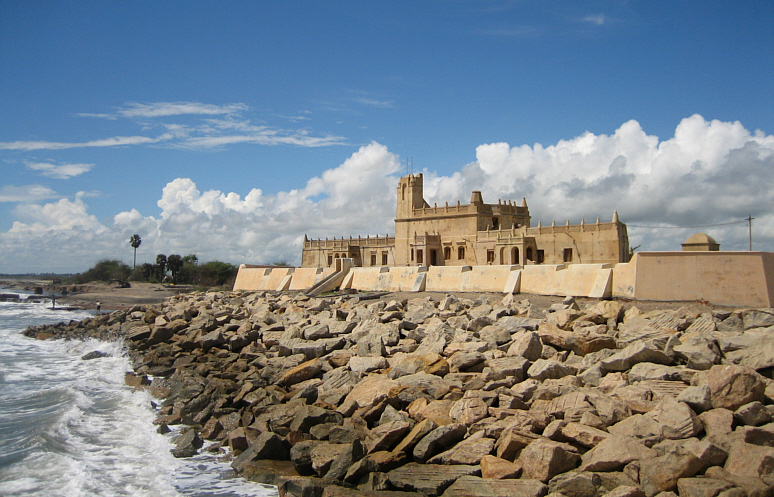
Abb.: Fort Dansborg, Tranquebar
[Bildquelle: Wikipedia, GNU FDLicense]
Dänische Stützpunkte in Indien waren:
"Danish India is a term for the former colonies of Denmark in India. They included the town of Tranquebar in present-day Tamil Nadu state, Serampore in present-day West Bengal, and the Nicobar Islands, currently part of India's union territory of the Andaman and Nicobar Islands.
HistoryThe Danish colonies in India were founded by the Danish East India Company, which was active from the 17th to the 19th centuries. The Danish colony's capital was Fort Dansborg at Tranquebar, established in 1620, on the Coromandel coast.
The Danish also established several commercial outposts, governed from Tranquebar:
- 1696 - 1722 Oddeway Torre on the Malabar coast
- 1698 - 1714 Dannemarksnagore at Gondalpara, southeast of Chandernagore
- 1752 - 1791 Calicut [Kozhikode/കോഴിക്കോട്]
- October 1755 Frederiksnagore at Serampore, in present-day West Bengal.
- 1754/1756 the Nicobar Islands -under the name Frederiksøerne.
- 1763 Balasore (already occupied 1636-1643).
In 1779 it was turned over to the government by the chartered company and became a Danish crown colony.
In 1789 the Andaman Islands become a British possession. During the Napoleonic Wars, the British attacked Danish shipping, and devastated the Danish East India Company's India trade; in May 1801 - August 1802 and 1808 - 20 September 1815 the British even occupied Dansborg and Frederiksnagore.
The Danish colonies went into decline, and the British ultimately took possession of them, making them part of British India: Serampore was sold to the British in 1839, and Tranquebar and most minor settlements in 1845 (11 October 1845 Frederiksnagore sold; 7 November 1845 other continental Danish India settlements sold); on 16 October 1869 all Danish rights to the Nicobar Islands, which since 1848 had been gradually abandoned, were sold to Britain."
[Quelle: http://en.wikipedia.org/wiki/Danish_India. -- Zugriff am 2008-06-02]
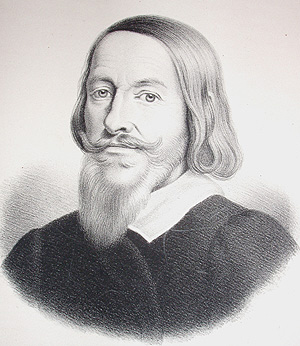
Abb.: Ove Giedde (1594 - 1660) / from J.P.Trap's Berømte danske mænd og
kvinder (1867)
[Bildquelle: Wikipedia, Public domain]
Text:
Payer, Alois <1944 - >: Quellenkunde zur indischen Geschichte bis 1858. -- 15. Frühe europäische Quellen und Quellen aus der Zeit der East India Companies. --16. Zum Beispiel: Vertrag zwischen Admiral Ove Giedde im Namen König Christians IV. und dem König von Tanjore vom 19. November 1620. -- Fassung vom 2008-06-12. -- http://www.payer.de/quellenkunde/quellen1516.htm
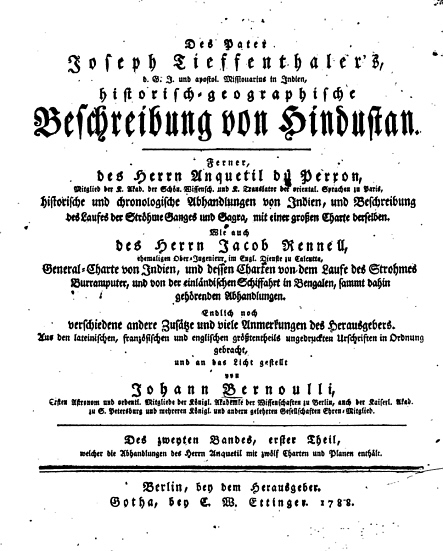
Abb.: Titelblatt von:
Tieffenthaler, Joseph <S.J.> <1710-1785>: Des Pater Joseph Tieffenthaler's, d. G. J. und apostol. Missionarius in Indien historisch-geographische Beschreibung von Hindustan. Ferner des Herrn Anquetil du Perron, Mitglied der Königl. Akad. der Inschriften und K. Translator der oriental. Sprachen zu Paris historische und chronologische Abhandlungen von Indien, und dessen Beschreibung des Laufes der Ströhme Ganges und Gagra, mit einer sehr großen Charte. Wie auch des Herrn Jacob Rennell ehemaligen Ober-Ingenieur im Engl. Dienste zu Calcutta, General-Charte von Indien, und dessen Charten von dem Laufe des Strohmes Burramputuer und von der einländischen Schiffahrt in Bengalen, sammt dahin gehörenden Abhandlungen. Endlich noch verschiedene andere Zusätze und viele Anmerkungen des Herausgebers / Aus den lateinischen, französischen und englischen größtentheils ungedruckten Urschriften in Ordnung gebracht, und in deutscher Sprache an das Licht gestellt von Johann Bernoulli, Königl. Astronom und ordentl. Mitgliede der Königl. Akademie der Wissenschaften zu Berlin, auch der Kaiserl. Akad. zu S. Petersburg und mehreren Königl. und anderen gelehrten Gesellschaften Ehren-Mitglied. -- Berlin : bey dem Herausgeber ; Gotha : bey C. W. Ettinger, 1785-1788. -- 3 Bde. in 5.
"Joseph Tieffentaller Jesuit missionary and noted geographer in Hindustan, b. at Bozen in the Tyrol, 27 August, 1710; d. at Lucknow, 5 July, 1785. He entered the Society of Jesus 9 October, 1729, and went in 1740 to the East Indian mission where he occupied various positions, chiefly in the empire of the Great Mogul. After the suppression of the Society he remained in India, and on his death was buried in the mission cemetery at Agra, where his tombstone still stands. He was a fine scholar with an unusual talent for languages; besides his native tongue he understood Latin, Italian, Spanish, French, Hindustan, Arabic, Persian, and Sanskrit. He was the first European who wrote an exact description of Hindustan. A brief list of his works is the best proof of his extraordinary power of work and his varied scholarship.
In geography, he wrote a "Descriptio Indiæ", that is a circumstantial description of the twenty-two provinces of India, of its cities, fortresses, and the most important smaller towns, together with an exact statement of geographical positions, calculated by means of a simple quadrant. The work also contains a large numbers of maps, plans, and sketches drawn by himself, and the list of geographical positions fills twenty-one quarto pages. He also prepared a large book of maps on the basin of the Ganges, entitled: "Cursus Gangæ fluvi Indiæ maximi, inde Priaga seu Elahbado Calcuttam usque ope acus magneticæ exploratus atque litteris mandatus aJ. T. S. J." (1765). the original map of the lower course of the river measures 15',that of the middle course, from Benares to Patna, measures 4' 3" square. In addition there is a map of similar dimensions of the Gagra, the whole accompanied by numerous notes, sketches of particular parts, and maps giving details - an "enormous labour" as Bernoulli calls it. he also wrote a work on the regions containing the sources of the chief rivers of India. In the field of religions he wrote a Brahmanism a work directed against the errors of the Englishmen Z. Howell and Alexander Dow. Others of his writings were on Indian idolatry, Indian asceticism, the religion of the Parsees, Mohammedanism, the relation of these religions to one another, etc. His writings in the department of the natural sciences are: astronomical observations on the sunspots and zodiacal light, studies on the astronomy, astrology, and cosmology of the Hindus, descriptions and observation's of the flora and fauna of India. the department of history is represented by writings in Latin on the origin of the Hindus and of their religion, an account in German of the expeditions of Nadir Shah to India, the deeds of the Great Mogul Shah Alam in Persian, and in French in incursions of the Afghans and the conquest of Delhi, and the contemporary history of India, 1757-64. In linguistics he wrote a Sanskrit-Parsee lexicon, treatises in Latin on the language of the Parsees, on the proper pronunciation of Latin, etc.
Tieffentaller sent these works in manuscript partly to the Danish scholar Dr. Kratzenstein in Copenhagen, partly to the celebrated French orientalist and geographer A. H. Anquetil-Duperron (1731-1805). The latter gave due credit to the value and importance of the works, especially those on geography, in his address before the French Academy of Sciences ("Journal des Scavans", Dec., 1776), and made the writing of Tieffentaller partly accessible to the learned world in his "Recherches hist. et géogr. sur l'Inde" (1786), and also in his "Carte général du cours du Gange et du Gagra dressée par les cartes particuliéres du P. Tieffenthaler (Paris, 1784). A part of the manuscripts at Copenhagen were obtained by the German scholar Johann Bernoulli of Berlin who used them in connection with the "Recherches" of Anquetil for the great work "Des Pater Joseph Tieffenthalers d. Ges. Jesu. und apost. Missionarius in Indien historisch-geographische Beschreibung von Hindustan . . ." (3 vols., quarto, Berlin-Gotha, 1785-87). the greater part of the first two volumes is devoted to Tieffentaller's writings, his maps, and sketches. the French edition, entitled "Description hist. et géogr. de l'Inde . . ." appeared at Berlin in three vols., 4to (1786-91). a large part of his manuscripts are probably still extant in Paris and Copenhagen.
HUONDER, Deutsche Jesuitenmissionäre des 17. und 18. Jahrh. (Freiberg, 1899), 179;
NOTI. Jos. Tieffentaller, S. J., A Forgotten Geographer of India (Bombay, 1906);
HOSTEN, Jesuit Missionaries in Northern India (Calcutta, 1907).A. HOUNDER" S. J. <1858 - 1926>
[Quelle: Catholic Encyclopedia. -- 1913. -- http://en.wikisource.org/wiki/Catholic_Encyclopedia_%281913%29/Joseph_Tieffentaller. -- Zugriff am 2008-06-06]
"Balthasar Sprenger (auch Balthasar Springer) (* vor 1500 in Vils, Außerfern, † wahrscheinlich zwischen 1509 und 1511) war ein Tiroler Afrika- und Indienreisender im Auftrag des Augsburger Handelshauses Welser. Person
Die Person wird heute überwiegend als Balthasar Springer bezeichnet, wenngleich er selbst in seiner Aufzeichnung „Merfart“ Balthasar Sprenger nennt. Über Sprengers Person ist wenig bekannt. Er wurde im 15. Jahrhundert in Vils, Außerfern, wahrscheinlich als Sohn des wohlhabenden Johannes (Hans) Springer geboren, der in den Jahren 1482 bis 1487 im Dienst der Landesfürsten von Tirol als Pfleger der Burg Fragenstein bei Zirl gestanden sein dürfte. Hans Springer soll nach einer Pilgerfahrt in das Heilige Land mit anderen Vilser Bürgern einen Teil seines Vermögens für den Bau einer Heiliggeistkapelle und eines „Seelhauses“ für Arme, Alte und Kranke außerhalb der Vilser Stadtmauern verwendet haben.
Das Todesdatum Balthasar Sprengers wird aus bestimmten Indizien auf den Zeitraum von 1509 bis 1511 eingegrenzt. Es gibt aber keine Quellen, wann und wo Sprenger verstorben ist.
Sprenger wurde 1503 vom Augsburger Handelshaus Welser als Vertreter nach Portugal entsandt, um neue Geschäftsmöglichkeiten zu erkunden. 1505 nahm er in dessen Auftrag an einer Fahrt unter der 22 Schiffe starken Flotte des portugiesischen Vizekönigs Francisco de Almeida teil, die ihn von Lissabon aus um den afrikanischen Kontinent und das Kap der guten Hoffnung an die afrikanische Ostküste und weiter an die indische Südostküste nach Kochi und Calicut führte, um dort Gewürze einzukaufen. Nach einem Jahr kehrte er 1506 nach Lissabon und Augsburg zurück. In seinem Reisetagebuch beschrieb er nicht nur die Handelsfahrt und die diversen Städte und Niederlassungen, die die Reisegesellschaft anfuhr, sondern auch seine Eindrücke über Menschen, Siedlungen und Kulturen, mit denen er in Afrika und Indien in Kontakt kam.
Erst wenige Jahre zuvor wurde der Seeweg nach Indien vom Portugiesen Vasco da Gama entdeckt (1497/98). Die Besatzung des Schiffs Sprengers fuhr wohl eine ähnliche Route (s. Gewürzroute). Sprenger beschreibt unter anderem „Monbasa“ (Mombasa), „Monsebick“ (Mosambik) und „Mellyndi“ (Melinde).
Das ReisetagebuchSprengers Tagebuch gehört zu den ältesten Reiseberichten in deutscher Sprache. Es wurde 1509 gedruckt. Die Titel lautet:
- DJe Merfart vnd erfarung nüwer Schiffung vnd Wege zuo viln onerkanten Jnseln vnd Künigreichen/
- von dem großmechtigen Portugalischen Kunig Emanuel Erforscht/ funden/ bestritten vnnd Jngenomen/
- Auch wunderbarliche Streyt/ordenung/
- leben wesen handlung vnd wunderwercke/
- des volcks vnd Thyrer dar inn wonende/
- findestu in diessem buchlyn warhaftiglich beschryben vnd abkunterfeyt/
- wie ich Balthasar Sprenger sollichs selbs: in kurtzuerschynen zeiten: gesehen vnd erfaren habe.
- GEDRVCKT ANNO. M.D.IX.
Die Bedeutung des Berichtes zeigt sich daran, dass das Buch mit Holzschnitten eines der seinerzeit anerkanntesten Künstler auf diesem Gebiet, des Augsburger Zeichners Hans Burgkmair illustriert wurde. Berühmt ist sein nach den Schilderungen Sprengers gefertigter Holzschnitt „Kunig von Gutzin“, der den in einer Prozession auf einer Art Sänfte getragenen König des Reichs von Kochi zeigt. Eine zweite Fassung der Bilder wurde vom Nürnberger Graphiker Georg Glockendon gefertigt.
Unmittelbar nach der Herausgabe in Deutschland wurde eine flämische Raubkopie des gesamten Textes mit Kopien nach Burkmairs Holzschnitten von Jan Doesborch in Antwerpen veröffentlicht. Heute existieren noch vier Original-Exemplare.
Das Buch wurde 1998 im Faksimile mit Übersetzung und Erläuterungen im Innsbrucker Haymon-Verlag nachgedruckt. Sprengers Reise war auch Inhalt weiterer Bücher und eines zweiteiligen Fernsehberichtes des ORF im Rahmen der Sendereihe „Land der Berge“, die im Juni 1998 erstausgestrahlt wurde.
SonstigesIn Königsbrunn präsentiert das Museum Mercateum die Handelsreise Balthasar Sprengers aus dem Jahr 1505.
In der Stadt Vils ist ein Weg nach Balthasar Springer benannt.
Literatur
- Beate Borowka-Clausberg: Balthasar Sprenger und der frühneuzeitliche Reisebericht[1] 1999 ISBN 3-89129-439-5 VI/220
- Eva Ramminger, Andreas Erhard: Die Meerfahrt - Balthasar Springers Reise zur Pfefferküste[2], 1998, ISBN 3-85218-260-3
- Franz Schulze (Hg): Balthasar Springers Indienfahrt 1505/06. Wissenschaftliche Würdigung der Reiseberichte zur Einführung in den Neudruck seiner »Meerfahrt« vom Jahre 1509. Strassburg 1902[3]
- Franz Schulze: Die wissenschaftliche Bedeutung der Reiseberichte Balthasar Springers, des ersten bekannten Indienfahrers aus Deutschland, Diss. Leipzig 1902[4]
- Karl H. Reger: Pfeffer aus Fernost. Das abenteuerliche Leben eines Augsburger Kaufmanns[5], 1986, ISBN 3-7787-3276-5
- David Armitage: The Procession Portrait of Queen Elizabeth I - A Note on a Tradition, Journal of the Warburg and Courtauld Institutes, (1990), pp. 301-307[6]
- Karen Sabine Meetz: Tempora Triumphant - Ikonographische Studien zur Rezeption des antiken Themas der Jahreszeitenprozession im 16. und 17. Jahrhundert und zu seinen naturphilosophischen, astronomischen und bildlichen Voraussetzungen, Dissertation Bonn 2003, S. 231f[7]"
[Quelle: http://de.wikipedia.org/wiki/Balthasar_Springer. -- Zugriff am 2008-06-02]
Faksimile und Text in heutigem Deutsch:
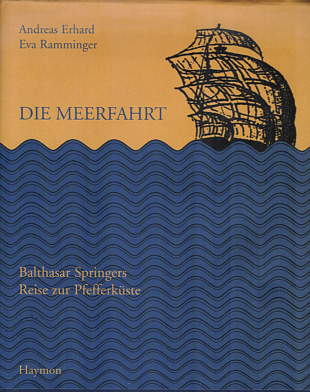
Abb.: Einbandtitel
Andreas Erhard ; Eva Ramminger: Die Meerfahrt : Balthasar Springers Reise zur Pfefferküste ; mit einem Faksimile des Buches von 1509. -- Innsbruck : Haymon. -- 1998. -- 175 S. : Ill. ; 27 cm. -- ISBN 3-85218-260-3. -- Enthält: Springer, Balthasar: Die Merfart un erfarung nüwer Schiffung und Wege zu viln onerkanten Inseln und Künigreichen (1509)
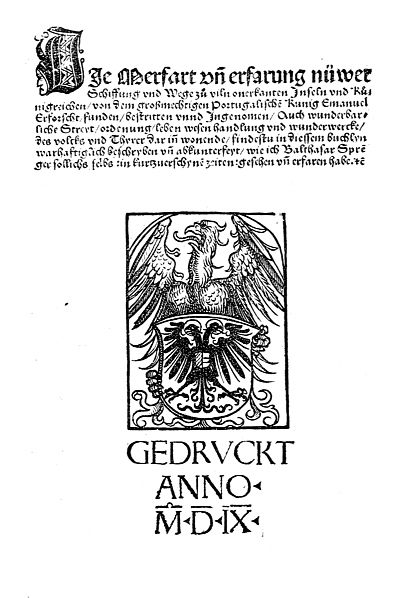
Abb.: Titelblatt, 1509
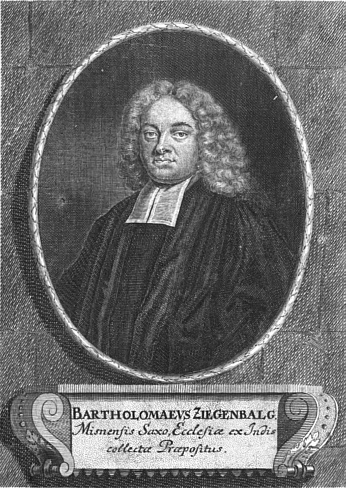
Abb.: Bartholomäus Ziegenbalg (1682 - 1719), 1715
[Bildquelle: Wikipedia, Public domain]
Siehe:
Bregy, Sabine: Zum Beispiel: Bartholomäus Ziegenbalg. -- (Quellenkunde zur indischen Geschichte bis 1858 / Alois Payer ; 15. Frühe europäische Quellen und Quellen aus der Zeit der East India Companies ; 17). -- Fassung vom 2008-06-13. -- http://www.payer.de/quellenkunde/quellen1517.htm
"Ziegenbalg: Bartholomäus Ziegenbalg, der erste deutsch-evangelische Missionar, wurde am 24. Juni 1683[1] als Sohn eines schlichten Handelsmannes gleichen Namens in dem sächsischen Städtchen Pulsnitz in der Lausitz geboren. Nach dem frühen Tode beider Eltern versah die älteste Schwester an den andern noch unmündigen Geschwistern Elternstelle; sie trug auch Sorge, dass der zum Studium bestimmte Knabe die städtische Schule zu Kamenz und darnach das Gymnasium zu Görlitz besuchte. Hier in Görlitz wurde der 16jährige Jüngling, bei dem der religiöse Zug schon frühzeitig entwickelt war, in die Kreise der damals im Aufblühen begriffenen pietistischen Bewegung mit hineingezogen. Er machte eine tiefgehende Erweckung durch, die für die Richtung seines ganzen weiteren Lebensganges von ausschlaggebender Bedeutung wurde. Nachdem ein Briefwechsel mit dem von ihm um seinen väterlichen Rath angegangenen Aug. Herm. Francke ihn an den Direktor des Friedrich-Werder'schen Gymnasium zu Berlin, Joachim Lange, einen anderen bekannten Vertreter des Pietismus, gewiesen hatte, sehen wir den jungen Ziegenbalg im Frühjahr 1702 in Berlin, wo er auch die Bekanntschaft mit Philipp Spener und dem Freiherrn v. Canstein machte. Allerdings war der Aufenthalt nur sehr kurz, Krankheit zwang ihn bald, Berlin wieder zu verlassen. Einigermaßen wiederhergestellt, zog es ihn dann nach Halle, um seinen väterlichen Berater A. H. Francke selbst kennen zu lernen und sich unter seinen Augen dem Studium der Theologie zu widmen. Doch erwies sich auch der Aufenthalt in Halle mit seiner ungesunden Luft seiner schwächlichen Körperkonstitution als so unzuträglich, dass er es ebenfalls nach einem kurzen, dort verbrachten Sommersemester (1703) wieder verlassen musste. Aber war auch seines Bleibens in Berlin und Halle nicht lange gewesen, so hat er doch aus dem Verkehr mit jenen von ihm hochverehrten Männern, Lange, Spener, Canstein und dann zuletzt und besonders Francke, unverwischliche Eindrücke mit fortgenommen. So sauer es Ziegenbalg wurde, so beschloss er doch, da nun einmal seine Gesundheit das wissenschaftliche Studium nicht zuzulassen schien, ganz darauf zu verzichten und den praktischen, bescheidenen Beruf eines Landmanns zu ergreifen. Doch zu guter Letzt eröffnete sich ihm ein anderer Weg, um zu dem so sehr ersehnten Ziele zu [156]kommen. Als Lehrer einer Privatschule in Merseburg und dann in Erfurt und darauf als Prädikant in seiner Heimat und in Werder bei Berlin fand er Gelegenheit, sich auf praktischem Wege für das geistliche Amt vorzubereiten. In dieser letzten Stellung als Prädikant in Werder empfing er die Berufung zu seinem nachmaligen Missionsamte. Der König Friedrich IV. von Dänemark hatte, vornehmlich wohl auf Betreiben seines eifrigen Hofpredigers Lütkens, den Entschluss gefasst, zu den heidnischen Bewohnern der überseeischen dänischen Kolonien Boten des Evangeliums zu senden, um jene zum Christentum zu bekehren. Lütkens wurde beauftragt, sich nach Kandidaten umzusehen, die zu solchem Amte geeignet sein möchten. Da sich nun in Dänemark zu solch gefährlichem Dienst niemand bereit fand, wandte er sich nach seinem Heimatlande, Deutschland, und schrieb an seine Berliner Freunde, zu welchen auch Lange gehörte, ob man in dieser Sache dort keinen Rath wüsste. Sofort dachte man in Berlin an Ziegenbalg, der sich ja auch gerade in der Nähe von Berlin befand. Er und mit ihm ein anderer junger Theologe, Heinr. Plütschau, wurden, nachdem sie sich einverstanden erklärt hatten, in feierlicher Sitzung am 1. Oktober 1705 in Berlin zum Missionsdienst ausgesondert und nach Kopenhagen abgesandt. Auf der Reise dorthin und in Kopenhagen selbst erregten zwar die beiden jungen Leute, wenn sie von ihrem Vorhaben sprachen, viel Kopfschütteln; die meisten hielten das Unternehmen für eine höchst abenteuerliche und ganz nutzlose Sache. Auch der Bischof Bornemann stellte sich feindselig. Er ließ sie bei dem Examen, das er mit ihnen anzustellen hatte, mit der charakteristischen Begründung durchfallen: „Die Männer sind verwerflich, denn es sind Pietisten.“ Indessen setzte Lütkens eine nochmalige Prüfung in Gegenwart von Zeugen durch, und jetzt musste Bornemann sie wohl oder übel für „bestanden“ erklären. Nachdem Ziegenbalg und Plütschau dann zum Missionsamt ordiniert waren, segelten sie am 29. November 1705 nach ihrer neuen Wirkungsstätte ab. Ursprünglich war als solche Westindien ins Auge gefasst, dann die Küste von Guinea in Westafrika. Schließlich wurde – es ist unbekannt aus welchem Grunde – auch davon Abstand genommen, und Vorderindien wurde das Arbeitsfeld unserer beiden Missionare. Hier besaß Dänemark an der Koromandel-Küste eine kleine Besitzung Trankebar, sie liegt in dem fruchtbaren Delta, welches die Kaweri, der südindische Nil, bei ihrer Einmündung in den Indischen Ocean bildet. Die Einwohner des Landes gehören zu dem etwa 16 Millionen zählenden dravidischen Volksstamm der Tamilen; unrichtigerweise werden sie in den alten Missionsberichten stets Malabaren genannt.
Als Ziegenbalg und Plütschau nach glücklich beendeter Seereise am 9. Juli 1706 in Trankebar landeten, ahnten sie noch nicht, wieviel Schwierigkeiten und Hindernisse sich ihrer Arbeit entgegentürmen würden. Die von Kopenhagen ziemlich unabhängige dänisch-ostindische Compagnie, welche von der Predigt des Evangeliums eine Erregung des religiösen Fanatismus ihrer heidnischen Untertanen und damit eine Gefährdung ihrer Herrschafts- und Handelsinteressen befürchtete, sah darum von Anbeginn an das Eindringen der Missionare mit feindseligen Augen an. Zwar konnte die Handelskompanie öffentlich gegen die auf ausdrücklichen Befehl des Königs eingerichtete Mission nichts unternehmen, desto mehr suchte man sie unter der Hand zu hemmen und wirkungslos zu machen. Demgemäß lauteten die dem Kommandanten von Trankebar, Hassius, erteilten geheimen Instruktionen. Und Hassius erwies sich als ein gefügiges Werkzeug seiner Auftraggeber. So oft die Missionare ein Anliegen an ihn hatten, dessen Beförderung sie im Vertrauen auf die königlichen Befehle von ihm erwarteten, legte derselbe vielmehr das äußerste Widerstreben an den Tag, ihnen entgegen zu kommen; ja es geschah wohl gerade das Gegenteil von dem, was die [157]Missionare gewünscht hatten. Er suchte den missliebigen Männern das Leben so sauer wie möglich zu machen. Dabei blieb es nicht einmal; es kam mehrfach zu erregten Auftritten, wobei sich der Kommandant dazu fortreißen ließ, die Missionare mit gemeinen Schimpfworten und sogar mit Faustschlägen zu traktieren. Auf den Höhepunkt stieg diese Verfolgung, als er Ziegenbalg, welcher sich in furchtloser Freimütigkeit einer tamilischen Christin gegen einen gewissenlosen dänischen Kompaniebeamten angenommen hatte, wie einen Aufrührer ins Gefängnis werfen ließ. Niemand durfte Ziegenbalg darin besuchen; sogar Tinte und Papier wurden ihm verweigert. Die Speisen, für welche Plütschau sorgen musste, wurden vorher erst untersucht, ob auch kein Brief eingeschmuggelt würde. Mehr als vier Monate hat er in diesem Gefängnis sitzen müssen, dann wurde er entlassen, ohne dass je in seiner Sache ein Urteil gesprochen wäre. Jahrelang wurden diese Drangsalierungen seitens des Kommandanten fortgesetzt, die Missionare haben darüber ein dickes Buch „den Bericht von den Verhindernissen in dem Werk der Bekehrung der Heiden“ geschrieben. Erst als Ziegenbalg 1715 selbst nach Europa ging, wurde Abhülfe geschaffen; Hassius wurde seines Amtes entsetzt, und ein missionsfreundlicher Kommandant, Herr v. Nissen, trat an seine Stelle.
Auch den sonstigen in Trankebar ansässigen Europäern war ihre Anwesenheit ein Dorn im Auge; man argwöhnte, dass sie Spione wären, die von dem Thun und Treiben der Europäer nach Hause berichten würden, was denselben allerdings angesichts ihres lasterhaften Wandels nicht eben erwünscht sein konnte. Leider stellten sich auch die beiden dänisch-evangelischen Prediger auf Seite ihrer Feinde, sie hielten es für angebracht, eine geharnischte Predigt gegen sie zu halten, in welcher sie die Missionare als falsche Propheten und Irrgeister an den Pranger stellten. Vollends sah der katholische Priester P. Guevara, der die Arbeit unter den Tamilen bisher als seine Domäne angesehen hatte, in den evangelischen Missionaren Eindringlinge in seine Interessensphäre, welche er mit allen Mitteln der Intrige bekämpfen zu müssen glaubte. So hatten die Missionare viele Feinde und wenig Freunde. Die Freunde in der Heimat aber waren weit und ließen wenig von sich hören. Bei den damaligen unvollkommenen Verkehrsverhältnissen dauerte es oft Jahre lang, bis ein Schiff nach Indien gelangte und Briefe und die zur Beförderung des Werkes nötigen Geldmittel brachte. Welch ein Schlag war es da, dass die erste größere Geldsendung von 2000 Thl. auf der Reede von Trankebar durch die Schuld des betrunkenen Kapitäns ins Wasser fiel und verloren ging. Zu dem allen gesellte sich schließlich noch Leid im eigenen Hause. Von drei 1708 neu hinausgesandten Missionaren trat einer auf die Seite ihrer Feinde. Es war ein höchst unerquickliches Zusammenleben voll täglicher kleiner Reibereien und Streitereien. Die Missionare atmeten erleichtert auf, als dieser falsche Bruder sie nach drei Jahren wieder verließ.
Das war der schwere Anfang der Mission. Alle diese Hindernisse mussten offenbar den Prüfstein abgeben, an dem sich erwies, ob das Werk probehaltig war oder nicht. Ziegenbalg hat die Probe bestanden. Er ist unter den zahlreichen Heimsuchungen nicht müde noch mürbe geworden. Hätte er das Feld geräumt, so wäre es menschlicher Berechnung nach für lange Zeit mit der Mission aus gewesen. Durch sein standhaftes Beharren hat er die Mission sowohl im Heidenlande wie in der Heimat fest begründet.
Was nun Ziegenbalg's Missionstätigkeit selbst betrifft, so hatte er auch hierin natürlich eine viel schwierigere Position als spätere Missionare. Es hatte noch niemand vor ihm auf diesem Gebiete Erfahrungen gesammelt, es waren noch keine Missionsprinzipien festgelegt noch Regeln für ihren Betrieb aufgestellt. Ziegenbalg musste als Bahnbrecher alles selbst erproben. Dass er nun als junger Missionar auch manchen Missgriff getan hat, ist nicht verwunderlich. Aber sehr interessant [158]ist es, zu beobachten, wie Ziegenbalg's Tätigkeit doch schon die wichtigsten Grundzüge aufweist, nach welchen auch heute noch die evangelische Mission verfährt. Gar bald kam er zur Erkenntnis, dass es durchaus nicht genüge, das Evangelium auf Portugiesisch – damals die lingua franca in Südindien – zu verkündigen, und dass er, um tieferen Eingang in das Volk zu finden, unbedingt in seiner Muttersprache, auf Tamilisch, zu ihm reden musste. Mit allem Nachdruck und mit Benutzung aller auftreibbarer Hilfsmittel warf er sich auf diese Sprache und konnte zur Verwunderung der Europäer nicht minder als der Eingeborenen bereits nach Jahresfrist die erste tamilische Predigt halten. – Nach dem bekannten Worte, dass, wer die Jugend hat, auch die Zukunft hat, ruft die evangelische Mission überall Schulen ins Leben. So war es auch einer der ersten Schritte Ziegenbalg's und seines Kollegen, die Kinder der Tamilensklaven und die Waisenkinder in Trankebar zusammenzulesen und mit ihnen eine Schule anzufangen. Dies war der Anfang des bis heute blühenden Schulwesens in Trankebar. – Weiter sieht es die evangelische Mission überall als ein von ihr zu erstrebendes Ziel an, dem Volke, an dem sie arbeitet, die Bibel in seiner Muttersprache zu bieten; die Bibel in der Landessprache ist eins der wesentlichsten Fundamente der aus der Heidenschaft zu bildenden Volkskirche. Auch Ziegenbalg machte sich, sobald er die Sprache einigermaßen beherrschte, an die Bibelübersetzung. Er hat das Neue Testament vollständig ins Tamilische übersetzt und mit dem Alten einen Anfang gemacht. Bei dem Stande der damaligen Kenntnis der tamilischen Sprache konnten diese Arbeiten natürlich noch nicht vollkommen ausfallen; spätere Übersetzer haben dann fort und fort daran gebessert und sie immer vollkommener gestaltet. – Es gilt aber nicht nur den heidnischen Nationen unsere heiligen Schriften zu bieten; um sie in ihrem religiösen Denken und Fühlen zu verstehen, ist es nötig, auch eine Kenntnis ihrer Religion zu haben. Solcher Erkenntnis verschloss sich Ziegenbalg nicht. Um die religiösen Anschauungen, Sitten und Gebräuche der Tamilen kennen zu lernen, trat er mit vielen gelehrten Vertretern des Brahmanentums in brieflichen Verkehr und benutzte auch jede Gelegenheit, um mit ihnen ein Gespräch anzuknüpfen. Eine ganze Reihe von Abhandlungen sind Früchte dieser Studien, so z. B. seine „Genealogie der Malabarischen Götter“, „Das Malabarische Heidentum“, „Malabarische Moralia“ u. s. w.
Immer mehr wurde es Ziegenbalg auch klar, dass die wenigen europäischen Missionare allein die zahllosen Scharen der Heiden nicht würden bekehren können, dass man hierzu der Hülfe der eingeborenen Christen nicht würde entraten können. Als er daher 1716 von seiner Europareise (s. o.), auf welcher er übrigens vom König von Dänemark zum Propst der Mission ernannt wurde, nach Trankebar zurückkehrte, machte er durch Gründung eines kleinen [?][2] Seminars den Anfang mit der Ausbildung eingeborener Lehrer. Es sollte dies eins seiner letzten Lebenswerke sein. Nehmen wir zu dem allen noch die tägliche Arbeit, das Ausgehen unter die Heiden und die Verkündigung des Evangeliums, die sonntäglichen und Wochengottesdienste, den Katechumenenunterricht der Taufbewerber, die Weiterbildung der jungen Christen, so werden wir staunen müssen über alles, was Ziegenbalg zumal bei der ihm sein Leben lang anhaftenden Leibesschwachheit und bei dem entnervenden Klima Indiens geleistet hat. Um so schmerzlicher musste es ihn treffen, wenn das Missionskollegium zu Kopenhagen sich dazu berufen glaubte, an dieser mit Hingabe seines ganzen Lebens betriebenen Arbeit eine vernichtende Kritik zu üben. Das Missionskollegium meinte, die Missionare verflöchten sich zu sehr in abliegende Angelegenheiten; von Kirchenbauen, Schulehalten, Bibelübersetzen stände in der Missionsinstruktion, die der Herr selbst Matth. 10 den Jüngern gegeben habe, nichts; darum sollten sich die Missionare auch dessen [159]enthalten u. s. w. Diese ungerechte und unverständige Verurteilung seines Lebenswerkes brach Ziegenbalg das Herz. Er fiel in schwere Krankheit und starb am 23. Februar 1719 im Alter von erst 34 Jahren.
Die in die Augen fallenden Früchte seiner Arbeit waren noch bescheiden: etwa 250 tamilische Christen sammelten sich zur Zeit seines Todes um die „Jerusalemskirche“, als ihr Zentrum. Es gilt hier das Wort: „der eine sät, der andere schneidet.“ Ziegenbalg war der Sämann, der den guten Samen ausstreute, andere haben dann geerntet, was er gesät hat. Jedenfalls gebührt Ziegenbalg ein Ehrenplatz unter den hervorragenden Vertretern der evangelischen Mission.
Dr. W. Germann, Ziegenbalg und Plütschau. Bd. I, Ihr Leben. Bd. II, Urkunden.
P. Richter.
[Anmerkungen]
- ↑ [WS: Andere Quellen nennen als Geburtsdatum den 10. Juli 1682. Der 24. Juni 1683 könnte das Taufdatum sein.]
- ↑ Das unvollständige Wort („kleinen“?) ist auf Seite 158 in Zeile 6 des unteren Absatzes (Zeile 14 von unten)"
[Quelle: P. Richter. -- In: Allgemeine Deutsche Biographie / herausgegeben von der Historischen Kommission bei der Bayrischen Akademie der Wissenschaften. -- Band 45. -- 1900. -- S. 155ff. -- Online: http://de.wikisource.org/wiki/ADB:Ziegenbalg%2C_Bartholom%C3%A4us. -- Zugriff am 2008-06-13]
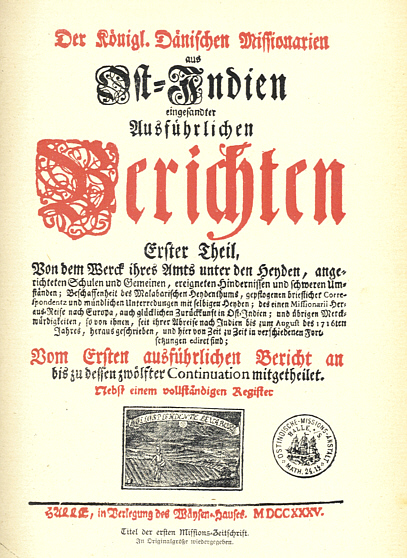
Abb.: Titelblatt der ersten deutschen Missionszeitschrift:
Der Königl. dänischen Missionarien aus Ost-Indien eingesandte ausführliche Berichte von dem Werck ihres Amts unter den Heyden / hrsg. von Gotthilf August Francken. - Halle, S. : Waysenhaus 1.1710 - 9.1762/67(1764/72) = Continuation 1. - 108.
Text:
Hümmerich, Franz <1868 - >: Vasco da Gama und die Entdeckung des Seewegs nach Ostindien ; auf Grund neuer Quellenuntersuchgen dargest. -- München: C. H. Beck, 1898. -- XIV, 203 S. ; 24 cm. -- S. 196 - 202
Auszug:
Payer, Alois <1944 - >: Quellenkunde zur indischen Geschichte bis 1858. -- 15. Frühe europäische Quellen und Quellen aus der Zeit der East India Companies. --18. Zum Beispiel: Tratato de una lettera dil fattore dil viaggio di India <Auszug>. -- Fassung vom 2008-06-12. -- http://www.payer.de/quellenkunde/quellen1518.htm
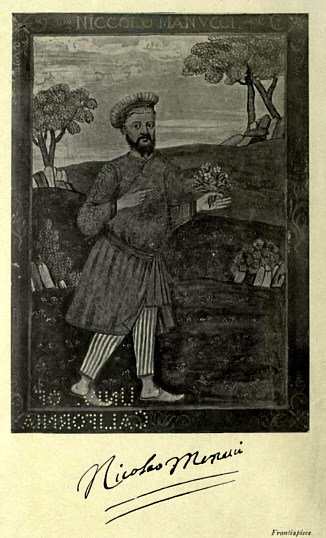
Abb.: Niccolao Manucci
[a.a.O., Vortitelblatt]
Text:
Manucci, Niccolao <1639-1717>: A Pepys of Mogul India, 1653-1708 : being an abridged edition of the "Storia do Mogor" of Niccolao Manucci / abridged edition prepared by Margaret L. Irvine ; translated by William Irvine. -- London : John Murray, 1913. -- xii, 310 S. ; 21 cm. -- Originaltitel: Storia do mogor. -- S. 149 - 162. -- Online: http://www.archive.org/details/pepysofmongulind00manurich. -- Zugriff am 2008-05-20. -- "Not in copyright."
Auszug:
Payer, Alois <1944 - >: Quellenkunde zur indischen Geschichte bis 1858. -- 15. Frühe europäische Quellen und Quellen aus der Zeit der East India Companies. --19. Zum Beispiel: Niccolao Manucci: Storia do Mogor, 1701 <Auszug>. -- Fassung vom 2008-06-12. -- http://www.payer.de/quellenkunde/quellen1519.htm
"NICCOLAO MANUCCI THE MAN NICCOLAO MANUCCI, the hero of our narrative, ran away from Venice in 1653, being then fourteen. He hid on board a vessel bound for Smyrna, and was fortunate enough to find a protector in a certain Viscount Bellomont, an English nobleman, then on his way to Persia and India. He followed Bellomont through Asia Minor to Persia, and from Persia to India, meeting with many adventures by sea and land. The sudden death of his master near Hoḍal, in 1656, left Manucci friendless in a strange land.
He seems to have been a youth of considerable resource, however, and fortune favoured him, for he soon found employment as an artilleryman in the service of Prince Dārā Shukoh, eldest son of the Emperor Shāhjahān. Till Dārā's death, in 1659, Manucci followed his varying fortunes in peace and war, and, refusing to transfer his services to Aurangzeb, he gradually adopted the profession of medicine.
Being offered the post of a captain of artillery by Rajah Jai Singh, he returned to soldiering for some years, till apparently he grew tired of it, and resigned his post. He made his way to Bassain, where he narrowly escaped the Inquisition, and thence to Goa, ultimately returning to Āgrah and Dihlī. Here he [S. vi] took service with Kīrat Singh, son of Jai Singh ; but when Kīrat Singh was ordered to Kābul, Manucci resolved to move to Lāhor (end of 1670 or early in 1671) and start in practice as a physician. At the end of six or seven years, having made a little money, Manucci decided to remove into European territory, and he made his home at Bandora, on Salsette Island. Before long, however, he lost his money in an unlucky venture, and was obliged to return to the Mogul Court. He obtained an appointment as one of the physicians attached to Shāh 'Ālam, and followed him to the Dakhin when he went there as Governor in 1678. Shāh 'Ālam was recalled in 1680 to take part in a campaign, and from that time they were on the move till early in 1681. Manucci seems to have found his position somewhat irksome, and determined to make his escape to Goa on the pretext of taking leave of absence.
He reached Goa, and was employed by the Portuguese in negotiations with the Mahrattah chief, Sambhā Jī, and also with Shāh 'Ālam, for which services the Governor conferred on him a patent of knighthood in the Portuguese Order of Sant' Iago, 1684. On a second embassy to Shāh 'Ālam, Manucci was detained as a deserter from his service. He attempted flight, but was brought back, and had to accompany Shāh 'Ālam through the Ghāts to Aḥmadnagar, and thence on a campaign against the King of Gulkhandah. When at Mālkher, Manucci managed to make his escape into Gulkhandah, and when Shāh 'Ālam occupied Gulkhandah he fled to the European settlements at Narsāpur and Masulipatam. He was brought back to Gulkhandah, but evaded being given up to the agents of Shāh 'Ālam, and, with the help of an [S. vii] Augustinian friar, he managed to escape once more and took refuge at the English settlement of Fort St. George. He had thought at this time of returning to Europe, but was dissuaded from doing so, and was advised to marry. He acted on this advice, and married in 1686 a Catholic widow named Clarke, daughter of Christopher Hartley and Aguida Pereyra. They had one child, a son, who died in infancy.
During his residence in Madras Manucci was employed by Governors Gyfford and Pitt ; by Gyfford in the matter of transmitting letters to the "Great Mogull," and by Thomas Pitt in actual negotiations with Dā'ūd Khan, who invested Madras in 1702. From 1703 onwards for several years Manucci seems to have been quite absorbed in matters ecclesiastical, and he devoted many pages of his memoirs to the discussion of the disputes between the Capuchins and Jesuits, which reached an active stage about that time. In 1706 his wife died, and between 1706 and 1712 Manucci moved his home to Pondicherry.
In that year he was about to make a special journey to Shāh 'Ālam's court at Lāhor as an intermediary on behalf of the Madras Council, who wished to settle various long-standing difficulties, and also to secure fresh privileges. The death of Shāh 'Ālam put an end to these plans, but as a reward for his previous services the Governor and Council on January 14, 1712, conceded to him in perpetuity his leasehold house and garden at Madras, which he had acquired as being heir of Thomas Clarke, having married his widow.
There is no further trace of Manucci at Madras or Pondicherry, and the only date for his death is a reference in the work, "Della Litteratura Veneziano" [S. viii] (4to, Venice, 1854), by the Doge Marco Nicolò Foscarini, where on p. 441 of the 4th edition, 1854, it is said that Manucci died in India in 1717 as an octogenarian, as he (Foscarini) had heard.
NICCOLAO MANUCCI THE AUTHOR
Manucci's own life is brimful of adventure, and not less interesting is the story of the vicissitudes through which his manuscript memoirs passed before they were finally presented to the public in 1907 in the masterly edition prepared by my father, the late William Irvine, entitled "Storia do Mogor." The strange story is given by him in the minutest detail in his Introduction to the "Storia," and I must content myself by giving a mere outline of the most essential facts.
Manucci sent home two copies of his manuscript ; the first by the hands of a certain Mons. Boureau Deslandes in 1701. This manuscript was lent by Deslandes to a certain Père Catrou, a Jesuit priest, who published in 1705 a book founded upon it, and entitled "Histoire Générale de l'Empire du Mogol depuis sa fondation, sur les Mémoires de M. Manouchi Venitien."
In 1705 this particular manuscript passed with others into the possession of Baron Gerard Meerman, of the Hague, was bought from his heirs in 1824 by Sir Thomas Philipps, of Middle Hill, Worcester, and was finally acquired by the Königliche Bibliothek at Berlin in 1887.
Some time in 1704, or 1705, Manucci received from Catrou an advance copy of his "Histoire," or of the preface to it. He was intensely indignant at what [S. ix] he considered to be an attempt on the part of the Jesuit Fathers "to transfer to themselves the glory won by another's labour," and he determined to send to Europe the original draft of his Parts I., II., and III., together with Part IV., on which he had been engaged since 1701. He sent them to the Venetian Senate by the hand of Father Eusebius, of Bourges, a Capuchin, in 1705. We learn that the manuscript was made over to the then Ambassador of the Venetian Senate at Paris, Lorenzo Tiepolo. Tiepolo became librarian of the San Marco Library in 1736, and Manucci's manuscript is entered in the catalogue made during his tenure of office, although we have no record of its transmission to Venice.
With the first manuscript sent to Europe, in 1701, Manucci also sent a volume of portraits. This seems to have passed out of the Jesuits' possession, for Zanetti catalogues it as being in the San Marco Library at Venice in 1741. Since then it has become the property of the French nation, being made over to them in 1797, and is now to be found in the Cabinet des Estampes at the Bibliothèque Nationale in Paris, classed as O.D. No. 45 (réserve).
This brief sketch of the man and his work will serve, I hope, to awaken interest in his story, and perhaps it will not be out of place to state here the reasons which suggested that a volume of selections from the "Storia" might meet with success.
The "Storia do Mogor," as a whole, is very lengthy, and somewhat diffuse ; and a great deal of it is interesting only to the student and the scholar. Some passages, such as those dealing with the disputes between the Capuchins and Jesuits, might even be called wearisome, whilst to many people the mere [S. x.] appearance of the four weighty volumes is quite alarming. We hoped, therefore, by making a selection of passages, dealing chiefly with Manucci's own life-story, that we might thus give a sufficiently faithful picture of the man and his career, and introduce him in this way to many readers, who otherwise would never have made his acquaintance.
In conclusion, I wish to express my most cordial thanks to Mr. L. Cranmer-Byng for his kind and able assistance and advice,
M. L. IRVINE.
GRINDELWALD,
January II, 1913."
[Quelle: Manucci, Niccolao <1639-1717>: A Pepys of Mogul India, 1653-1708 : being an abridged edition of the "Storia do Mogor" of Niccolao Manucci / abridged edition prepared by Margaret L. Irvine ; translated by William Irvine. -- London : John Murray, 1913. -- xii, 310 S. ; 21 cm. -- Originaltitel: Storia do mogol. -- S. v - x. -- Online: http://www.archive.org/details/pepysofmongulind00manurich. -- Zugriff am 2008-05-20. -- "Not in copyright."]
Übersetzung:
Manucci, Niccolao <1639-1717>: Storia do Mogor or Mogul India 1653 - 1708 / by Nicolao Manucci. Translated with introd. and notes by William Irvine [1840 - 1911]. Vorr.: T[homas] W[illiam] Rhys Davids. -- London : Murray, 1907 - 1908. -- 4 Bde. -- (Indian texts Series ; 1)
Manucci, Niccolao <1639-1717>: A Pepys of Mogul India, 1653-1708 : being an abridged edition of the "Storia do Mogor" of Niccolao Manucci / abridged edition prepared by Margaret L. Irvine ; translated by William Irvine. -- London : John Murray, 1913. -- xii, 310 S. ; 21 cm. -- Originaltitel: Storia do mogol. -- Online: http://www.archive.org/details/pepysofmongulind00manurich. -- Zugriff am 2008-05-20. -- "Not in copyright."
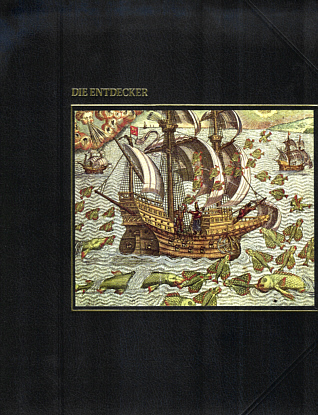
Abb.: Einbandtitel
Humble, Richard: Die Entdecker / von Richard
Humble u.d. Red. d. Time-Life-Bücher. -- Amsterdam : Time-Life International,
1979. -- 176 S. : Ill. . ; 29 cm. -- (Die Seefahrer : Time-Life-Bücher).
-- Hervorragende Einführung in die seefahrerischen Aspekte dieser Zeit.
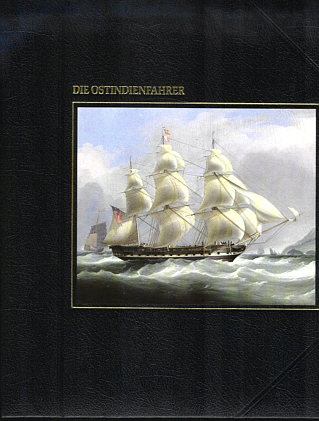
Abb.: Einbandtitel
Miller, Russell: Die Ostindienfahrer / von Russell Miller u.d. Red. d. Time-Life-Bücher. --Amsterdam : Time-Life-Bücher, 1981. -- 176 S. : Ill. ; 29 cm. -- (Die Seefahrer : Time-Life-Bücher). -- ISBN 90-6182-461-3. -- Hervorragende Einführung in die seefahrerischen Aspekte dieser Zeit.
Zu: 1. Zum Beispiel: Gaspar Correa <16. Jhdt.>: Lendas de India, erste Reise Vasco da Gamas nach Indien.